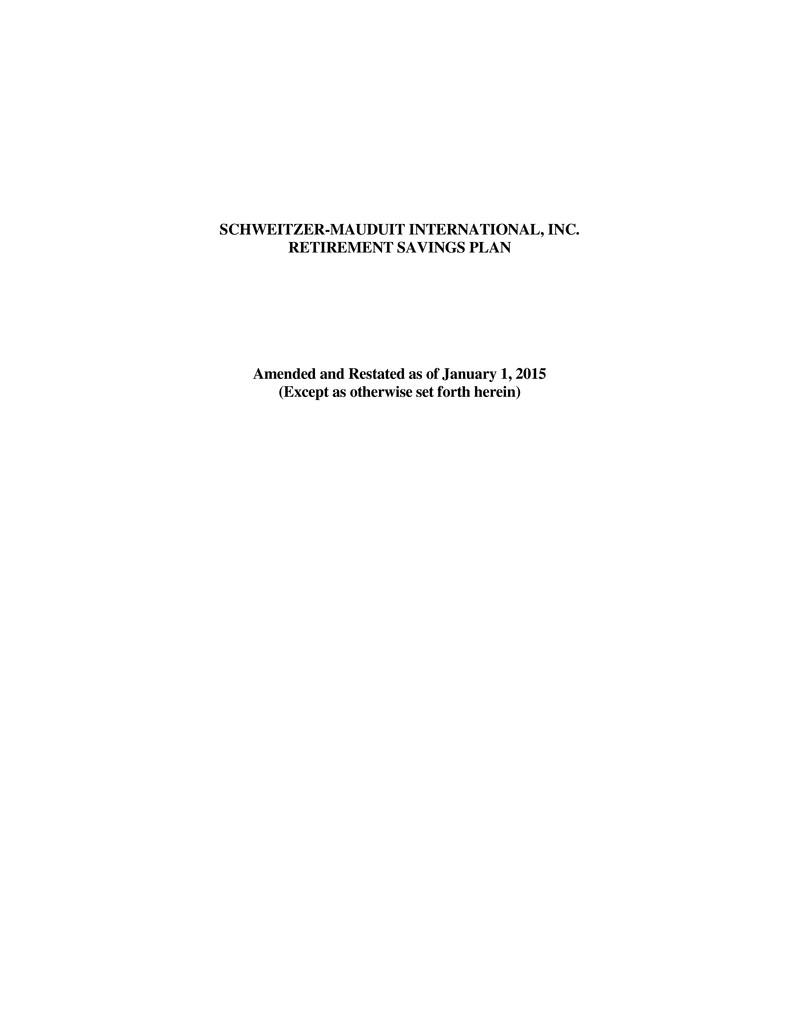
SCHWEITZER-MAUDUIT INTERNATIONAL, INC. RETIREMENT SAVINGS PLAN Amended and Restated as of January 1, 2015 (Except as otherwise set forth herein)
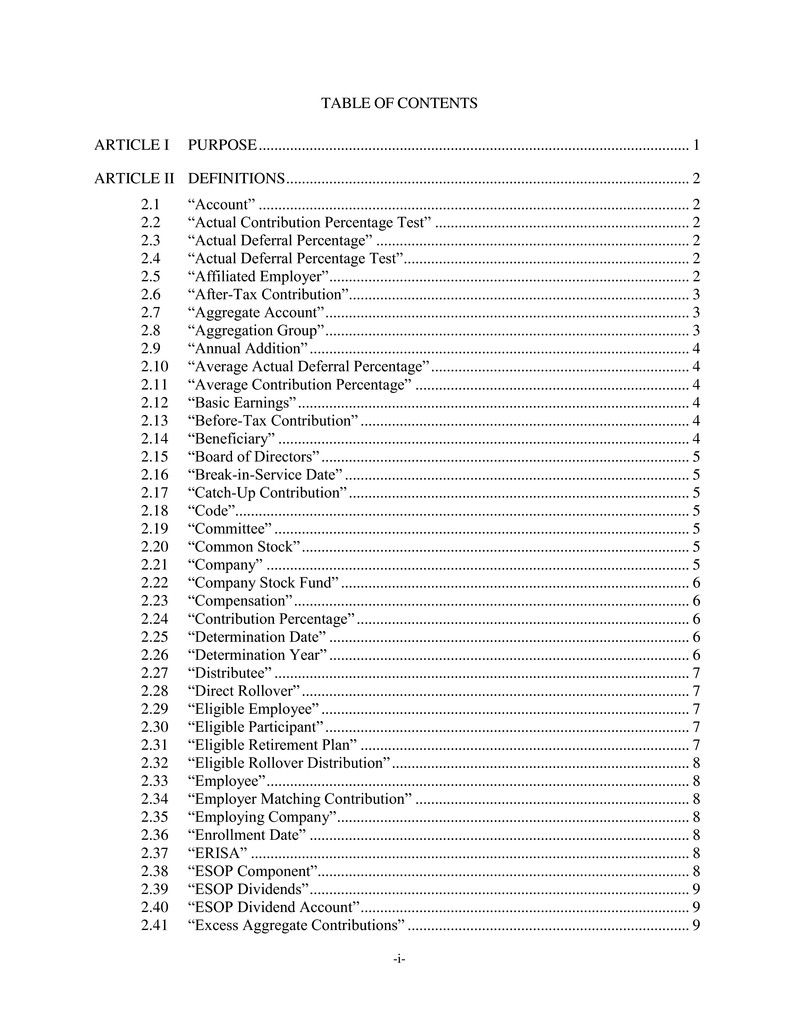
-i- TABLE OF CONTENTS ARTICLE I PURPOSE .............................................................................................................. 1 ARTICLE II DEFINITIONS ....................................................................................................... 2 2.1 “Account” .............................................................................................................. 2 2.2 “Actual Contribution Percentage Test” ................................................................. 2 2.3 “Actual Deferral Percentage” ................................................................................ 2 2.4 “Actual Deferral Percentage Test” ......................................................................... 2 2.5 “Affiliated Employer” ............................................................................................ 2 2.6 “After-Tax Contribution” ....................................................................................... 3 2.7 “Aggregate Account” ............................................................................................. 3 2.8 “Aggregation Group” ............................................................................................. 3 2.9 “Annual Addition” ................................................................................................. 4 2.10 “Average Actual Deferral Percentage” .................................................................. 4 2.11 “Average Contribution Percentage” ...................................................................... 4 2.12 “Basic Earnings” .................................................................................................... 4 2.13 “Before-Tax Contribution” .................................................................................... 4 2.14 “Beneficiary” ......................................................................................................... 4 2.15 “Board of Directors” .............................................................................................. 5 2.16 “Break-in-Service Date” ........................................................................................ 5 2.17 “Catch-Up Contribution” ....................................................................................... 5 2.18 “Code”.................................................................................................................... 5 2.19 “Committee” .......................................................................................................... 5 2.20 “Common Stock” ................................................................................................... 5 2.21 “Company” ............................................................................................................ 5 2.22 “Company Stock Fund” ......................................................................................... 6 2.23 “Compensation” ..................................................................................................... 6 2.24 “Contribution Percentage” ..................................................................................... 6 2.25 “Determination Date” ............................................................................................ 6 2.26 “Determination Year” ............................................................................................ 6 2.27 “Distributee” .......................................................................................................... 7 2.28 “Direct Rollover” ................................................................................................... 7 2.29 “Eligible Employee” .............................................................................................. 7 2.30 “Eligible Participant” ............................................................................................. 7 2.31 “Eligible Retirement Plan” .................................................................................... 7 2.32 “Eligible Rollover Distribution” ............................................................................ 8 2.33 “Employee” ............................................................................................................ 8 2.34 “Employer Matching Contribution” ...................................................................... 8 2.35 “Employing Company” .......................................................................................... 8 2.36 “Enrollment Date” ................................................................................................. 8 2.37 “ERISA” ................................................................................................................ 8 2.38 “ESOP Component”............................................................................................... 8 2.39 “ESOP Dividends” ................................................................................................. 9 2.40 “ESOP Dividend Account” .................................................................................... 9 2.41 “Excess Aggregate Contributions” ........................................................................ 9

TABLE OF CONTENTS (continued) Page -ii- 2.42 “Excess Deferral Amount” .................................................................................... 9 2.43 “Excess Deferral Contributions”............................................................................ 9 2.44 “Forfeiture” ............................................................................................................ 9 2.45 “Group Termination” ............................................................................................. 9 2.46 “Highly Compensated Employee” ......................................................................... 9 2.47 “Hour of Service” .................................................................................................. 9 2.48 “Investment Fund” ............................................................................................... 11 2.49 “K-C Plan” ........................................................................................................... 11 2.50 “Key Employee” .................................................................................................. 11 2.51 “Limitation Year” ................................................................................................ 11 2.52 “Month of Service” .............................................................................................. 11 2.53 “Non-Highly Compensated Employee” ............................................................... 11 2.54 “Normal Retirement Date” .................................................................................. 11 2.55 “One-Year Break in Service”............................................................................... 11 2.56 “Participant” ......................................................................................................... 11 2.57 “Participating Unit” ............................................................................................. 11 2.58 “Plan” ................................................................................................................... 11 2.59 “Plan Year” .......................................................................................................... 12 2.60 “Profit Sharing Component” ................................................................................ 12 2.61 “Record Date” ...................................................................................................... 12 2.62 “Rollover Contribution”....................................................................................... 12 2.63 “Present Value of Accrued Retirement Income” ................................................. 12 2.64 “Surviving Spouse” .............................................................................................. 12 2.65 “Supplemental Account” ..................................................................................... 12 2.66 “Suspense Account”............................................................................................. 12 2.67 “Top-Heavy Group”............................................................................................. 12 2.68 “Total and Permanent Disability” ........................................................................ 13 2.69 “Trust” or “Trust Fund” ....................................................................................... 13 2.70 “Trust Agreement” ............................................................................................... 13 2.71 “Trustee” .............................................................................................................. 13 2.72 “12-Month Work Schedule” ................................................................................ 13 2.73 “Valuation Date” .................................................................................................. 13 2.74 “Year of Service” ................................................................................................. 13 ARTICLE III PARTICIPATION ............................................................................................... 15 3.1 Eligibility Requirements ...................................................................................... 15 3.2 Participation upon Reemployment ....................................................................... 15 3.3 Loss of Eligible Employee Status ........................................................................ 15 ARTICLE IV BEFORE-TAX CONTRIBUTIONS AND AFTER-TAX CONTRIBUTIONS ............................................................................................. 16 4.1 Before-Tax Contributions .................................................................................... 16 4.2 Maximum Amount of Before-Tax Contributions ................................................ 16

TABLE OF CONTENTS (continued) Page -iii- 4.3 Distribution of Excess Deferral Amounts ............................................................ 16 4.4 Additional Rules Regarding Before-Tax Contributions ...................................... 17 4.5 Section 401(k) Nondiscrimination Tests ............................................................. 18 4.6 After-Tax Contributions....................................................................................... 22 4.7 Manner and Time of Payment of Before-Tax Contributions and After-Tax Contributions........................................................................................................ 22 4.8 Change in Contribution Rate ............................................................................... 22 4.9 Change in Contribution Amount .......................................................................... 22 4.10 Rollover Contributions and Transfers from Other Plans ..................................... 22 4.11 Code Section 401(k)(12) Safe Harbor ................................................................. 23 ARTICLE V EMPLOYER MATCHING CONTRIBUTIONS ................................................ 25 5.1 Amount of Employer Matching Contributions .................................................... 25 5.2 Investment of Employer Matching Contributions ............................................... 25 5.3 Payment of Employer Matching Contributions ................................................... 25 5.4 Section 401(m) Nondiscrimination Tests ............................................................ 25 5.5 Reversion of Employing Company Contributions ............................................... 28 5.6 Correction of Prior Incorrect Allocations and Distributions................................ 29 ARTICLE VI LIMITATIONS ON CONTRIBUTIONS ............................................................ 30 6.1 Section 415 Limitations ....................................................................................... 30 6.2 Correction of Contributions in Excess of Section 415 Limits ............................. 30 6.3 Combination of Plans ........................................................................................... 31 ARTICLE VII SUSPENSION OF CONTRIBUTIONS .............................................................. 33 7.1 Suspension of Contributions ................................................................................ 33 7.2 Resumption of Contributions ............................................................................... 33 ARTICLE VIII INVESTMENT OF CONTRIBUTIONS ........................................................... 34 8.1 Investment Funds ................................................................................................. 34 8.2 Investment of Contributions ................................................................................ 34 8.3 Investment of Earnings ........................................................................................ 34 8.4 Transfer of Assets between Funds ....................................................................... 34 8.5 Change in Investment Direction .......................................................................... 35 8.6 Section 404(c) Plan .............................................................................................. 35 ARTICLE IX MAINTENANCE AND VALUATION OF PARTICIPANTS’ ACCOUNTS ........................................................................................................ 36 9.1 Establishment of Accounts .................................................................................. 36 9.2 Valuation of Investment Funds ............................................................................ 36 9.3 Rights in Investment Funds ................................................................................. 36

TABLE OF CONTENTS (continued) Page -iv- ARTICLE X VESTING ............................................................................................................ 37 10.1 Vesting ................................................................................................................. 37 10.2 Allocation of Forfeitures ...................................................................................... 37 10.3 Reemployment After Break in Service ................................................................ 37 10.4 Buy-Back Procedure ............................................................................................ 37 ARTICLE XI WITHDRAWALS AND LOANS PRIOR TO TERMINATION OF EMPLOYMENT .................................................................................................. 39 11.1 Withdrawals by Participants ................................................................................ 39 11.2 Notice of Withdrawal ........................................................................................... 39 11.3 Form of Withdrawal ............................................................................................. 40 11.4 Source of Withdrawal .......................................................................................... 40 11.5 Requirement of Hardship ..................................................................................... 40 11.6 Suspension of Contributions ................................................................................ 41 11.7 Loans .................................................................................................................... 42 ARTICLE XII DISTRIBUTION TO PARTICIPANTS .............................................................. 44 12.1 Distribution upon Retirement .............................................................................. 44 12.2 Distribution upon Disability ................................................................................ 44 12.3 Distribution upon Group Terminations ................................................................ 44 12.4 Distribution upon Death ....................................................................................... 44 12.5 Designation of Beneficiary in the Event of Death ............................................... 44 12.6 Distribution upon Termination of Employment .................................................. 45 12.7 Commencement of Benefits ................................................................................. 46 12.8 Transfer between Employing Companies ............................................................ 47 12.9 Distributions to Alternate Payees......................................................................... 47 12.10 Requirement for Direct Rollovers ........................................................................ 48 12.11 Consent and Notice Requirements ....................................................................... 48 12.12 Form of Payment.................................................................................................. 49 ARTICLE XIII ADMINISTRATION OF THE PLAN ............................................................... 50 13.1 Membership of Committee .................................................................................. 50 13.2 Transaction of Business ....................................................................................... 50 13.3 Responsibilities in General .................................................................................. 50 13.4 Committee as Named Fiduciary........................................................................... 50 13.5 Rules for Plan Administration ............................................................................. 50 13.6 Employment of Agents ........................................................................................ 50 13.7 Co-Fiduciaries ...................................................................................................... 51 13.8 General Records ................................................................................................... 51 13.9 Liability of the Committee ................................................................................... 51 13.10 Reimbursement of Expenses and Compensation of Committee .......................... 51 13.11 Expenses of Plan and Trust Fund......................................................................... 52
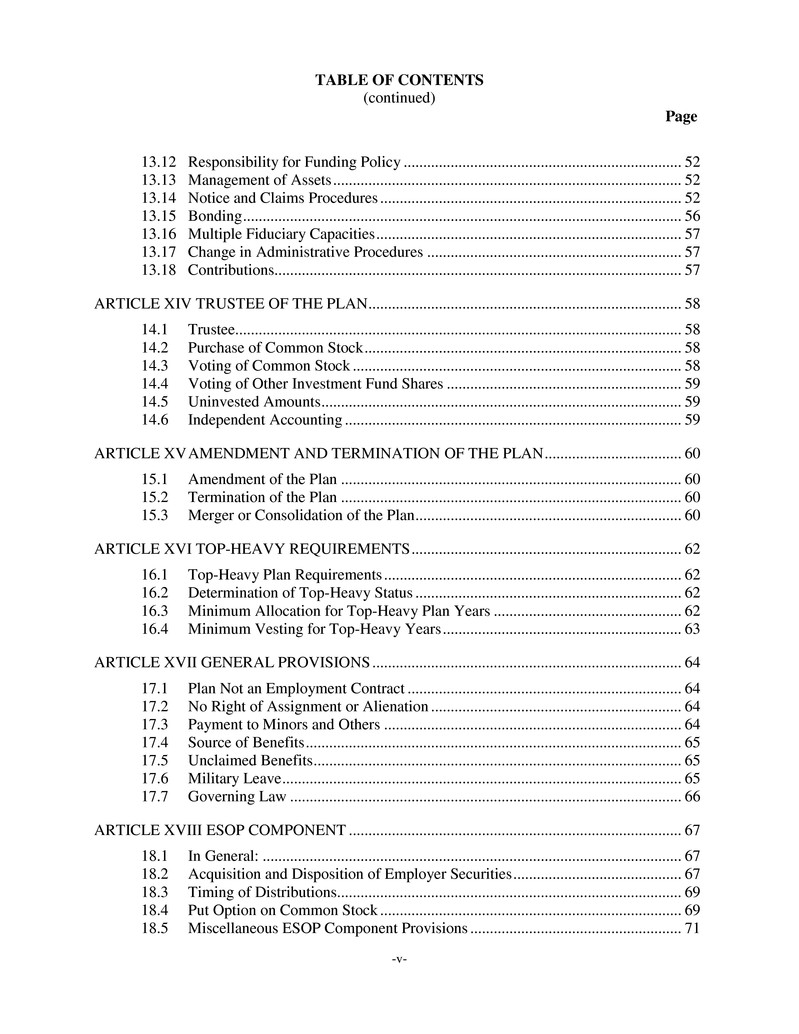
TABLE OF CONTENTS (continued) Page -v- 13.12 Responsibility for Funding Policy ....................................................................... 52 13.13 Management of Assets ......................................................................................... 52 13.14 Notice and Claims Procedures ............................................................................. 52 13.15 Bonding ................................................................................................................ 56 13.16 Multiple Fiduciary Capacities .............................................................................. 57 13.17 Change in Administrative Procedures ................................................................. 57 13.18 Contributions........................................................................................................ 57 ARTICLE XIV TRUSTEE OF THE PLAN ................................................................................ 58 14.1 Trustee.................................................................................................................. 58 14.2 Purchase of Common Stock ................................................................................. 58 14.3 Voting of Common Stock .................................................................................... 58 14.4 Voting of Other Investment Fund Shares ............................................................ 59 14.5 Uninvested Amounts ............................................................................................ 59 14.6 Independent Accounting ...................................................................................... 59 ARTICLE XV AMENDMENT AND TERMINATION OF THE PLAN ................................... 60 15.1 Amendment of the Plan ....................................................................................... 60 15.2 Termination of the Plan ....................................................................................... 60 15.3 Merger or Consolidation of the Plan .................................................................... 60 ARTICLE XVI TOP-HEAVY REQUIREMENTS ..................................................................... 62 16.1 Top-Heavy Plan Requirements ............................................................................ 62 16.2 Determination of Top-Heavy Status .................................................................... 62 16.3 Minimum Allocation for Top-Heavy Plan Years ................................................ 62 16.4 Minimum Vesting for Top-Heavy Years ............................................................. 63 ARTICLE XVII GENERAL PROVISIONS ............................................................................... 64 17.1 Plan Not an Employment Contract ...................................................................... 64 17.2 No Right of Assignment or Alienation ................................................................ 64 17.3 Payment to Minors and Others ............................................................................ 64 17.4 Source of Benefits ................................................................................................ 65 17.5 Unclaimed Benefits .............................................................................................. 65 17.6 Military Leave ...................................................................................................... 65 17.7 Governing Law .................................................................................................... 66 ARTICLE XVIII ESOP COMPONENT ..................................................................................... 67 18.1 In General: ........................................................................................................... 67 18.2 Acquisition and Disposition of Employer Securities ........................................... 67 18.3 Timing of Distributions........................................................................................ 69 18.4 Put Option on Common Stock ............................................................................. 69 18.5 Miscellaneous ESOP Component Provisions ...................................................... 71

TABLE OF CONTENTS (continued) Page -vi- APPENDIX A - EMPLOYING COMPANIES ........................................................................... 74 APPENDIX B - PARTICIPATING UNITS ................................................................................ 75

1 Schedules to the Plan SCHEDULES TO THE PLAN Schedule 1 Non-Collectively Bargained Employees Schedule 2 Ancram Mill Schedule 3 Lee Mills (Closed) Schedule 4 Spotswood Mill

1 RSP - Art. I ARTICLE I PURPOSE The purpose of the Plan is to encourage employee thrift, to create added employee interest in the affairs of Schweitzer-Mauduit International, Inc., to provide a means for becoming a shareholder in Schweitzer-Mauduit International, Inc., to supplement retirement and death benefits, and to create a competitive compensation program for employees through the establishment of a formal plan under which contributions by and on behalf of Participants are supplemented by contributions of Employing Companies. The Plan consists of two components, one of which is designed to qualify as a profit sharing plan under Code Section 401(a) that includes a qualified cash or deferred arrangement within the meaning of Code Section 401(k), and the other of which is designed to qualify as a stock bonus plan under Code Section 401(a) and as an employee stock ownership plan under Code Section 4975(e)(7). The Plan originally was effective as of January 1, 1999, immediately following the December 31, 1998 effective date of the merger of the Schweitzer-Mauduit International, Inc. Hourly Employees Retirement Savings Plan with the Schweitzer-Mauduit International, Inc. Salaried Employees Retirement Savings Plan. The Company amended and restated the Plan effective as of January 1, 2007 and again effective as of January 1, 2009, in order to meet the requirements of the 2008 Cumulative List in Notice 2008-108 for Cycle D Plans and to comply with the requirements of the Pension Protection Act of 2006, the Heroes Earnings Assistance and Relief Tax Act of 2008 and the Worker, Retiree and Employer Recovery Act of 2008. The Company hereby amends and restates the Plan, generally effective as of January 1, 2015, in order to (i) meet the safe harbor requirements under Code Section 401(k)(12), (ii) add a loan feature, and (iii) meet the requirements of the 2013 Cumulative List in Notice 2013-84 for Cycle D Plans.

RSP - Art. II 2 ARTICLE II DEFINITIONS All references to articles, sections, subsections, and paragraphs shall be to articles, sections, subsections, and paragraphs of this Plan unless another reference is expressly set forth in this Plan. Any words used in the masculine shall be read and be construed in the feminine where they would so apply. Words in the singular shall be read and construed in the plural, and all words in the plural shall be read and construed in the singular in all cases where they would so apply. For purposes of this Plan, unless otherwise required by the context or unless otherwise defined in the Appendix B Schedules attached hereto, the following terms shall have the meanings set forth opposite such terms: 2.1 “Account” shall mean the total amount credited to the account of a Participant, as described in Section 9.1. To the extent that all or part of an Account is invested in Common Stock, the Account may consist of two components, one of which is attributable to the Profit Sharing Component of the Plan (which includes that portion of the Account that is invested in any Investment Fund other than the Company Stock Fund), and the other of which is attributable to the ESOP Component of the Plan (which includes that portion of the Account that is invested in the Company Stock Fund, and which shall be subject to the provisions of Article XVIII). 2.2 “Actual Contribution Percentage Test” shall mean the test described in Section 5.4(a). 2.3 “Actual Deferral Percentage” shall mean the ratio (expressed as a percentage) of the Before-Tax Contributions (excluding Catch-Up Contributions) made on behalf of an Eligible Participant for the Plan Year to the Eligible Participant’s compensation (within the meaning of Code Section 414(s)) for the Plan Year. For the purpose of determining an Eligible Participant’s Actual Deferral Percentage for a Plan Year, the Plan Committee may elect to consider an Eligible Participant’s compensation for (a) the entire Plan Year or (b) that portion of the Plan Year in which the Eligible Participant was eligible to have Before-Tax Contributions made on his behalf, provided that such election is applied uniformly to all Eligible Participants for the Plan Year. The Actual Deferral Percentage of an Eligible Participant who does not have Before- Tax Contributions made on his behalf shall be zero. 2.4 “Actual Deferral Percentage Test” shall mean the test described in Section 4.5(a). 2.5 “Affiliated Employer” shall mean an Employing Company and (a) any corporation which is a member of a controlled group of corporations (as defined in Section 414(b) of the Code) which includes such Employing Company, (b) any trade or business (whether or not incorporated) which is under common control (as defined in Section 414(c) of the Code) with such Employing Company, (c) any organization (whether or not incorporated) which is a member of an affiliated service group (as defined in Section 414(m) of the Code) which includes such Employing Company, and (d) any other entity required to be aggregated with such Employing Company pursuant to regulations under Section 414(o) of the Code.

RSP - Art. II 3 Notwithstanding the foregoing, for purposes of applying the limitations of Article VI, the term Affiliated Employer shall be adjusted as required by Code Section 415(h). 2.6 “After-Tax Contribution” shall mean a contribution made pursuant to Section 4.6 during the Plan Year. 2.7 “Aggregate Account” shall mean with respect to a Participant as of the Determination Date, the sum of the following: (a) the Account balance of such Participant as of the most recent valuation occurring within a twelve-month period ending on the Determination Date; (b) an adjustment for any contributions due as of the Determination Date; (c) any Plan distributions, including unrelated rollovers and plan-to-plan transfers (ones which are both initiated by the Employee and made from a plan maintained by one employer to a plan maintained by another employer), but not related rollovers or plan-to-plan transfers (ones either not initiated by the Employee or made to a plan maintained by the same employer), made during the one-year period ending on the Determination Date, including distributions made under a terminated plan which if it had not been terminated would have been required to be included in an Aggregation Group. In the case of any distribution made for a reason other than severance from employment, death or disability, this subsection (c) shall be applied by substituting “five-year period” for “one-year period;” (d) any Employee contributions, whether voluntary or mandatory; and (e) related rollovers and plan-to-plan transfers to this Plan. 2.8 “Aggregation Group” shall mean either a Required Aggregation Group or a Permissive Aggregation Group as hereinafter determined. (a) Required Aggregation Group: In determining a Required Aggregation Group hereunder, each plan of the Affiliated Employers in which a Key Employee is a participant and each other plan of the Affiliated Employers which enables any plan in which a Key Employee participates to meet requirements of Code Section 401(a)(4) or 410 will be required to be aggregated. Such group shall be known as a Required Aggregation Group. (b) Permissive Aggregation Group: The Affiliated Employers may also include any other plan not required to be included in the Required Aggregation Group, provided the resulting group, taken as a whole, would continue to satisfy the provisions of Code Section 401(a)(4) or 410. Such group shall be known as a Permissive Aggregation Group. 2.9 “Annual Addition” shall mean the amount allocated to a Participant’s Account and accounts under all defined contribution plans maintained by the Affiliated Employers during a Limitation Year that constitutes the following:
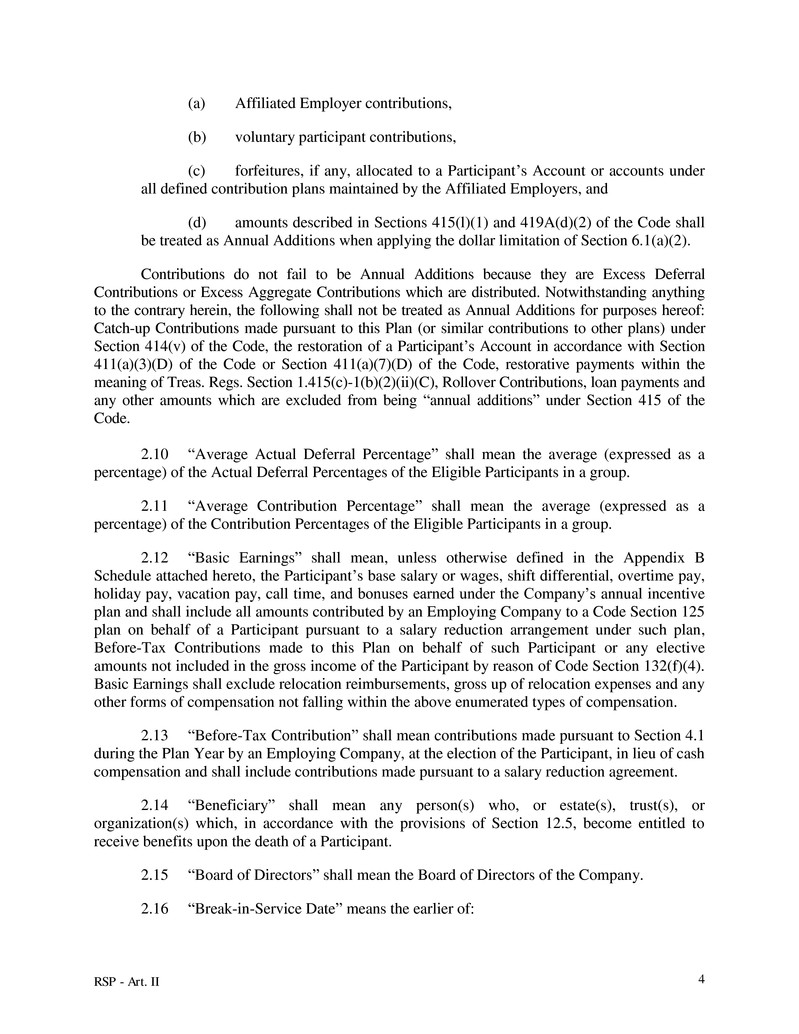
RSP - Art. II 4 (a) Affiliated Employer contributions, (b) voluntary participant contributions, (c) forfeitures, if any, allocated to a Participant’s Account or accounts under all defined contribution plans maintained by the Affiliated Employers, and (d) amounts described in Sections 415(l)(1) and 419A(d)(2) of the Code shall be treated as Annual Additions when applying the dollar limitation of Section 6.1(a)(2). Contributions do not fail to be Annual Additions because they are Excess Deferral Contributions or Excess Aggregate Contributions which are distributed. Notwithstanding anything to the contrary herein, the following shall not be treated as Annual Additions for purposes hereof: Catch-up Contributions made pursuant to this Plan (or similar contributions to other plans) under Section 414(v) of the Code, the restoration of a Participant’s Account in accordance with Section 411(a)(3)(D) of the Code or Section 411(a)(7)(D) of the Code, restorative payments within the meaning of Treas. Regs. Section 1.415(c)-1(b)(2)(ii)(C), Rollover Contributions, loan payments and any other amounts which are excluded from being “annual additions” under Section 415 of the Code. 2.10 “Average Actual Deferral Percentage” shall mean the average (expressed as a percentage) of the Actual Deferral Percentages of the Eligible Participants in a group. 2.11 “Average Contribution Percentage” shall mean the average (expressed as a percentage) of the Contribution Percentages of the Eligible Participants in a group. 2.12 “Basic Earnings” shall mean, unless otherwise defined in the Appendix B Schedule attached hereto, the Participant’s base salary or wages, shift differential, overtime pay, holiday pay, vacation pay, call time, and bonuses earned under the Company’s annual incentive plan and shall include all amounts contributed by an Employing Company to a Code Section 125 plan on behalf of a Participant pursuant to a salary reduction arrangement under such plan, Before-Tax Contributions made to this Plan on behalf of such Participant or any elective amounts not included in the gross income of the Participant by reason of Code Section 132(f)(4). Basic Earnings shall exclude relocation reimbursements, gross up of relocation expenses and any other forms of compensation not falling within the above enumerated types of compensation. 2.13 “Before-Tax Contribution” shall mean contributions made pursuant to Section 4.1 during the Plan Year by an Employing Company, at the election of the Participant, in lieu of cash compensation and shall include contributions made pursuant to a salary reduction agreement. 2.14 “Beneficiary” shall mean any person(s) who, or estate(s), trust(s), or organization(s) which, in accordance with the provisions of Section 12.5, become entitled to receive benefits upon the death of a Participant. 2.15 “Board of Directors” shall mean the Board of Directors of the Company. 2.16 “Break-in-Service Date” means the earlier of:
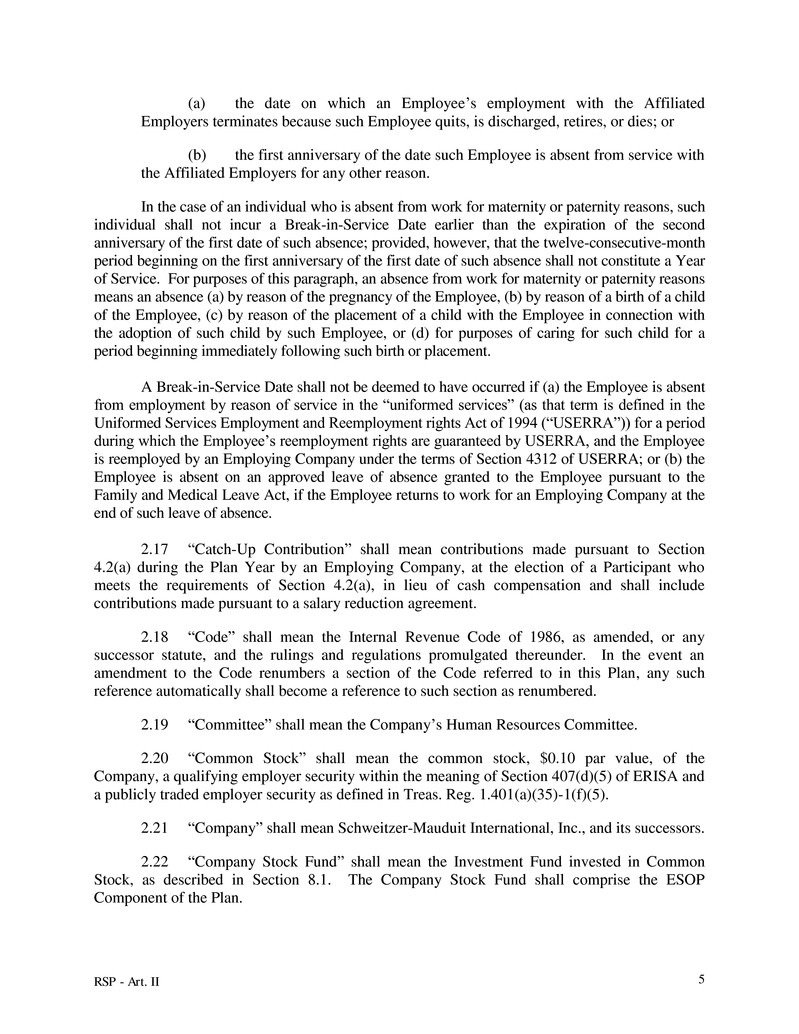
RSP - Art. II 5 (a) the date on which an Employee’s employment with the Affiliated Employers terminates because such Employee quits, is discharged, retires, or dies; or (b) the first anniversary of the date such Employee is absent from service with the Affiliated Employers for any other reason. In the case of an individual who is absent from work for maternity or paternity reasons, such individual shall not incur a Break-in-Service Date earlier than the expiration of the second anniversary of the first date of such absence; provided, however, that the twelve-consecutive-month period beginning on the first anniversary of the first date of such absence shall not constitute a Year of Service. For purposes of this paragraph, an absence from work for maternity or paternity reasons means an absence (a) by reason of the pregnancy of the Employee, (b) by reason of a birth of a child of the Employee, (c) by reason of the placement of a child with the Employee in connection with the adoption of such child by such Employee, or (d) for purposes of caring for such child for a period beginning immediately following such birth or placement. A Break-in-Service Date shall not be deemed to have occurred if (a) the Employee is absent from employment by reason of service in the “uniformed services” (as that term is defined in the Uniformed Services Employment and Reemployment rights Act of 1994 (“USERRA”)) for a period during which the Employee’s reemployment rights are guaranteed by USERRA, and the Employee is reemployed by an Employing Company under the terms of Section 4312 of USERRA; or (b) the Employee is absent on an approved leave of absence granted to the Employee pursuant to the Family and Medical Leave Act, if the Employee returns to work for an Employing Company at the end of such leave of absence. 2.17 “Catch-Up Contribution” shall mean contributions made pursuant to Section 4.2(a) during the Plan Year by an Employing Company, at the election of a Participant who meets the requirements of Section 4.2(a), in lieu of cash compensation and shall include contributions made pursuant to a salary reduction agreement. 2.18 “Code” shall mean the Internal Revenue Code of 1986, as amended, or any successor statute, and the rulings and regulations promulgated thereunder. In the event an amendment to the Code renumbers a section of the Code referred to in this Plan, any such reference automatically shall become a reference to such section as renumbered. 2.19 “Committee” shall mean the Company’s Human Resources Committee. 2.20 “Common Stock” shall mean the common stock, $0.10 par value, of the Company, a qualifying employer security within the meaning of Section 407(d)(5) of ERISA and a publicly traded employer security as defined in Treas. Reg. 1.401(a)(35)-1(f)(5). 2.21 “Company” shall mean Schweitzer-Mauduit International, Inc., and its successors. 2.22 “Company Stock Fund” shall mean the Investment Fund invested in Common Stock, as described in Section 8.1. The Company Stock Fund shall comprise the ESOP Component of the Plan.

RSP - Art. II 6 2.23 “Compensation” shall mean the Basic Earnings of a Participant from an Employing Company as determined by the Employing Company. Compensation shall be determined without regard to any adjustment in a Participant’s base salary or wages as a result of foreign assignment. Amounts earned but not paid during a Plan Year solely because of the timing of pay periods and pay dates shall not be included in Compensation for the Plan Year earned, but shall be included when paid. Compensation shall include amounts paid to an individual who does not currently perform services for the Employer by reason of qualified military service (within the meaning of Code Section 414(u)(5)) (while on active duty for a period of more than 30 days) to the extent these payments constitute “differential wage payments” within the meaning of Code Section 3401(h)(2) and do not exceed the amounts the individual would have received if the individual had continued to perform services for the Employer rather than performing qualified military service. Compensation shall not include amounts paid after severance from employment unless such compensation is paid within the later of 2-1/2 months after severance from employment or the last day of the Limitation Year in which severance from employment occurs and such payment is regular compensation for services during the Employee’s regular working hours, or compensation for services outside the Employee’s regular working hours (such as overtime or shift differential), commissions, bonuses, or other similar payments and such payment would have been paid to the Employee in the absence of a severance from employment. Notwithstanding any provision herein to the contrary and for all purposes under the Plan, the Compensation of each Participant taken into account for purposes of this Plan shall not exceed $260,000 for any Plan Year, as adjusted for cost-of-living increases in accordance with Code Section 401(a)(17)(B). If a determination period consists of fewer than 12 months, the applicable compensation limit shall be multiplied by a fraction, the numerator of which is the number of months in the determination period and the denominator of which is 12. 2.24 “Contribution Percentage” shall mean the ratio (expressed as a percentage), of the sum of After-Tax Contributions and Employer Matching Contributions under the Plan on behalf of the Eligible Participant for the Plan Year to the Eligible Participant’s compensation (within the meaning of Code Section 414(s)) for the Plan Year. For the purpose of determining an Eligible Participant’s Contribution Percentage for a Plan Year, the Committee may elect to consider an Eligible Participant’s compensation for (a) the entire Plan Year or (b) that portion of the Plan Year in which the individual is an Eligible Participant, provided that such election is applied uniformly to all Eligible Participants for the Plan Year. 2.25 “Determination Date” shall mean with respect to a Plan Year, the last day of the preceding Plan Year. 2.26 “Determination Year” shall mean the Plan Year being tested. 2.27 “Distributee” shall include an Employee or former Employee. In addition, the Employee’s or former Employee’s Surviving Spouse and the Employee’s or former Employee’s spouse or former spouse who is an alternate payee under a qualified domestic relations order, as defined in Section 414(p) of the Code, are Distributees with regard to the interest of the spouse
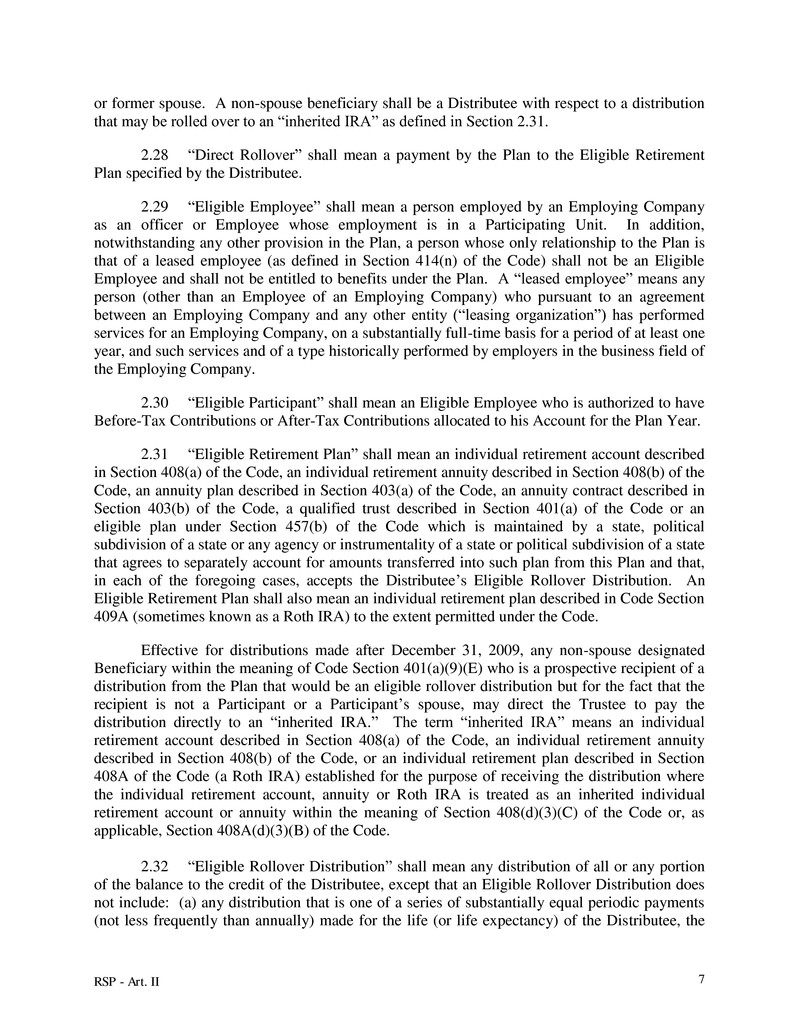
RSP - Art. II 7 or former spouse. A non-spouse beneficiary shall be a Distributee with respect to a distribution that may be rolled over to an “inherited IRA” as defined in Section 2.31. 2.28 “Direct Rollover” shall mean a payment by the Plan to the Eligible Retirement Plan specified by the Distributee. 2.29 “Eligible Employee” shall mean a person employed by an Employing Company as an officer or Employee whose employment is in a Participating Unit. In addition, notwithstanding any other provision in the Plan, a person whose only relationship to the Plan is that of a leased employee (as defined in Section 414(n) of the Code) shall not be an Eligible Employee and shall not be entitled to benefits under the Plan. A “leased employee” means any person (other than an Employee of an Employing Company) who pursuant to an agreement between an Employing Company and any other entity (“leasing organization”) has performed services for an Employing Company, on a substantially full-time basis for a period of at least one year, and such services and of a type historically performed by employers in the business field of the Employing Company. 2.30 “Eligible Participant” shall mean an Eligible Employee who is authorized to have Before-Tax Contributions or After-Tax Contributions allocated to his Account for the Plan Year. 2.31 “Eligible Retirement Plan” shall mean an individual retirement account described in Section 408(a) of the Code, an individual retirement annuity described in Section 408(b) of the Code, an annuity plan described in Section 403(a) of the Code, an annuity contract described in Section 403(b) of the Code, a qualified trust described in Section 401(a) of the Code or an eligible plan under Section 457(b) of the Code which is maintained by a state, political subdivision of a state or any agency or instrumentality of a state or political subdivision of a state that agrees to separately account for amounts transferred into such plan from this Plan and that, in each of the foregoing cases, accepts the Distributee’s Eligible Rollover Distribution. An Eligible Retirement Plan shall also mean an individual retirement plan described in Code Section 409A (sometimes known as a Roth IRA) to the extent permitted under the Code. Effective for distributions made after December 31, 2009, any non-spouse designated Beneficiary within the meaning of Code Section 401(a)(9)(E) who is a prospective recipient of a distribution from the Plan that would be an eligible rollover distribution but for the fact that the recipient is not a Participant or a Participant’s spouse, may direct the Trustee to pay the distribution directly to an “inherited IRA.” The term “inherited IRA” means an individual retirement account described in Section 408(a) of the Code, an individual retirement annuity described in Section 408(b) of the Code, or an individual retirement plan described in Section 408A of the Code (a Roth IRA) established for the purpose of receiving the distribution where the individual retirement account, annuity or Roth IRA is treated as an inherited individual retirement account or annuity within the meaning of Section 408(d)(3)(C) of the Code or, as applicable, Section 408A(d)(3)(B) of the Code. 2.32 “Eligible Rollover Distribution” shall mean any distribution of all or any portion of the balance to the credit of the Distributee, except that an Eligible Rollover Distribution does not include: (a) any distribution that is one of a series of substantially equal periodic payments (not less frequently than annually) made for the life (or life expectancy) of the Distributee, the
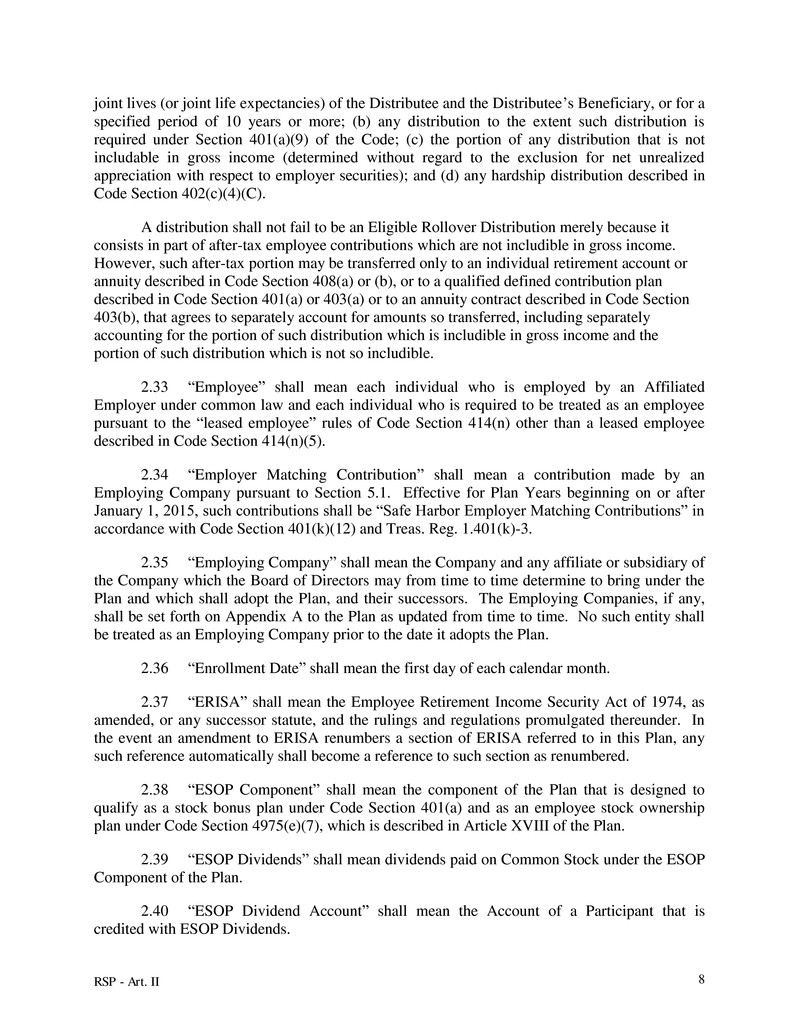
RSP - Art. II 8 joint lives (or joint life expectancies) of the Distributee and the Distributee’s Beneficiary, or for a specified period of 10 years or more; (b) any distribution to the extent such distribution is required under Section 401(a)(9) of the Code; (c) the portion of any distribution that is not includable in gross income (determined without regard to the exclusion for net unrealized appreciation with respect to employer securities); and (d) any hardship distribution described in Code Section 402(c)(4)(C). A distribution shall not fail to be an Eligible Rollover Distribution merely because it consists in part of after-tax employee contributions which are not includible in gross income. However, such after-tax portion may be transferred only to an individual retirement account or annuity described in Code Section 408(a) or (b), or to a qualified defined contribution plan described in Code Section 401(a) or 403(a) or to an annuity contract described in Code Section 403(b), that agrees to separately account for amounts so transferred, including separately accounting for the portion of such distribution which is includible in gross income and the portion of such distribution which is not so includible. 2.33 “Employee” shall mean each individual who is employed by an Affiliated Employer under common law and each individual who is required to be treated as an employee pursuant to the “leased employee” rules of Code Section 414(n) other than a leased employee described in Code Section 414(n)(5). 2.34 “Employer Matching Contribution” shall mean a contribution made by an Employing Company pursuant to Section 5.1. Effective for Plan Years beginning on or after January 1, 2015, such contributions shall be “Safe Harbor Employer Matching Contributions” in accordance with Code Section 401(k)(12) and Treas. Reg. 1.401(k)-3. 2.35 “Employing Company” shall mean the Company and any affiliate or subsidiary of the Company which the Board of Directors may from time to time determine to bring under the Plan and which shall adopt the Plan, and their successors. The Employing Companies, if any, shall be set forth on Appendix A to the Plan as updated from time to time. No such entity shall be treated as an Employing Company prior to the date it adopts the Plan. 2.36 “Enrollment Date” shall mean the first day of each calendar month. 2.37 “ERISA” shall mean the Employee Retirement Income Security Act of 1974, as amended, or any successor statute, and the rulings and regulations promulgated thereunder. In the event an amendment to ERISA renumbers a section of ERISA referred to in this Plan, any such reference automatically shall become a reference to such section as renumbered. 2.38 “ESOP Component” shall mean the component of the Plan that is designed to qualify as a stock bonus plan under Code Section 401(a) and as an employee stock ownership plan under Code Section 4975(e)(7), which is described in Article XVIII of the Plan. 2.39 “ESOP Dividends” shall mean dividends paid on Common Stock under the ESOP Component of the Plan. 2.40 “ESOP Dividend Account” shall mean the Account of a Participant that is credited with ESOP Dividends.
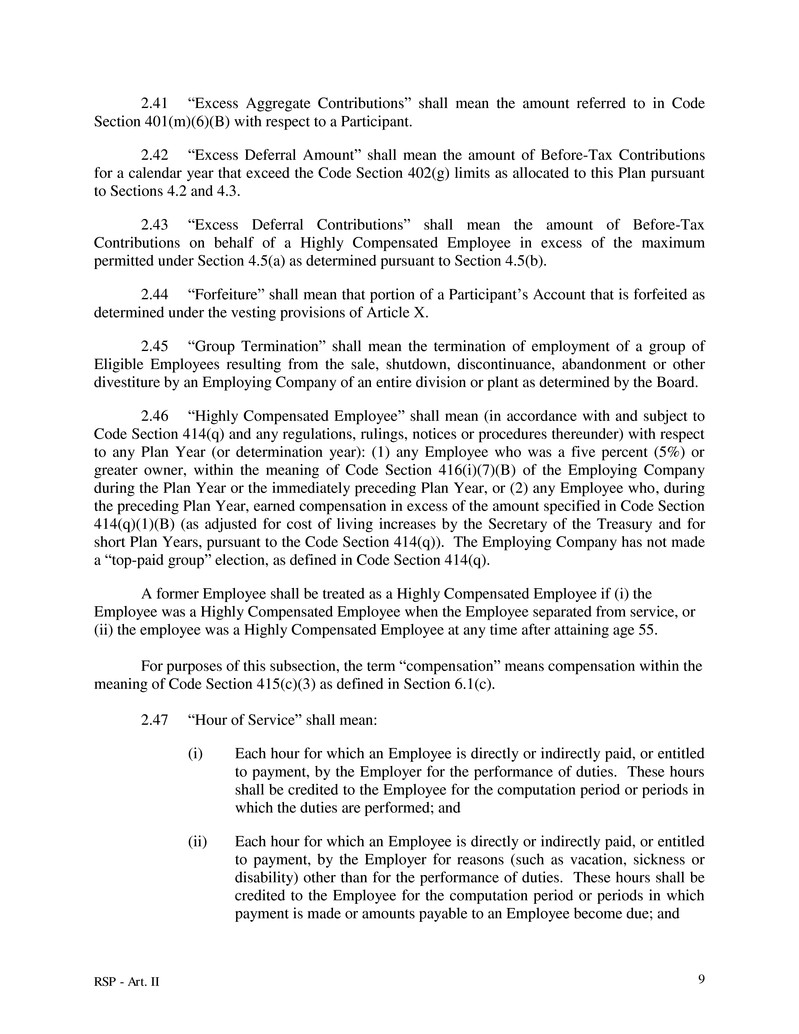
RSP - Art. II 9 2.41 “Excess Aggregate Contributions” shall mean the amount referred to in Code Section 401(m)(6)(B) with respect to a Participant. 2.42 “Excess Deferral Amount” shall mean the amount of Before-Tax Contributions for a calendar year that exceed the Code Section 402(g) limits as allocated to this Plan pursuant to Sections 4.2 and 4.3. 2.43 “Excess Deferral Contributions” shall mean the amount of Before-Tax Contributions on behalf of a Highly Compensated Employee in excess of the maximum permitted under Section 4.5(a) as determined pursuant to Section 4.5(b). 2.44 “Forfeiture” shall mean that portion of a Participant’s Account that is forfeited as determined under the vesting provisions of Article X. 2.45 “Group Termination” shall mean the termination of employment of a group of Eligible Employees resulting from the sale, shutdown, discontinuance, abandonment or other divestiture by an Employing Company of an entire division or plant as determined by the Board. 2.46 “Highly Compensated Employee” shall mean (in accordance with and subject to Code Section 414(q) and any regulations, rulings, notices or procedures thereunder) with respect to any Plan Year (or determination year): (1) any Employee who was a five percent (5%) or greater owner, within the meaning of Code Section 416(i)(7)(B) of the Employing Company during the Plan Year or the immediately preceding Plan Year, or (2) any Employee who, during the preceding Plan Year, earned compensation in excess of the amount specified in Code Section 414(q)(1)(B) (as adjusted for cost of living increases by the Secretary of the Treasury and for short Plan Years, pursuant to the Code Section 414(q)). The Employing Company has not made a “top-paid group” election, as defined in Code Section 414(q). A former Employee shall be treated as a Highly Compensated Employee if (i) the Employee was a Highly Compensated Employee when the Employee separated from service, or (ii) the employee was a Highly Compensated Employee at any time after attaining age 55. For purposes of this subsection, the term “compensation” means compensation within the meaning of Code Section 415(c)(3) as defined in Section 6.1(c). 2.47 “Hour of Service” shall mean: (i) Each hour for which an Employee is directly or indirectly paid, or entitled to payment, by the Employer for the performance of duties. These hours shall be credited to the Employee for the computation period or periods in which the duties are performed; and (ii) Each hour for which an Employee is directly or indirectly paid, or entitled to payment, by the Employer for reasons (such as vacation, sickness or disability) other than for the performance of duties. These hours shall be credited to the Employee for the computation period or periods in which payment is made or amounts payable to an Employee become due; and

RSP - Art. II 10 (iii) Each hour for which back pay, irrespective of mitigation of damage, has either been agreed to by the Employing Company or otherwise awarded. These hours shall be credited to the Employee for the computation period or periods to which the award or agreement pertains rather than the computation period in which the award, agreement or payment is made. Credit for Hours of Service shall be given for periods of absence spent in military service to the extent required by law. Credit for Hours of Service on account of any single continuous period of absence due to illness or injury during which the Employee performs no duties shall not exceed the Hours of Service required by his 12-Month Work Schedule at the time of the commencement of such period. Hours of Service shall be calculated and credited in a manner consistent with U.S. Department of Labor regulation Section 2530.200b-2(b) and (c), and shall in no event exclude any hours required to be credited under U.S. Department of Labor regulation Section 2530.200b-2(a). For any period or periods for which adequate records are not available to accurately determine the Employee’s Hours of Service, such Employee will receive credit for 190 Hours of Service for each month for which such Employee would otherwise receive credit for at least one Hour of Service. Solely for purposes of determining whether an Employee has incurred a Break in Service, an Employee who is absent from work: I. by reason of the pregnancy of the Employee; II. by reason of the birth of a child of the Employee; III. by reason of a placement of a child with the Employee in connection with the adoption of such child by the Employee; or IV. for purpose of caring for such child for a period beginning immediately following such birth or placement, shall be credited with certain Hours of Service which would otherwise have been credited to the Employee if not for such absence. The Hours of Service credited hereunder by reason of such absence shall be credited with respect to the Plan Year in which such absence begins, if such credit is necessary to prevent the Employee from incurring a Break in Service Date in such Plan Year, and otherwise with respect to the Plan Year immediately following the Plan Year in which such absence begins. In addition, the Hours of Service credited with respect to such absence shall not exceed 501, and shall be credited only to the extent that the Employee substantiates to the satisfaction of the Company that the Employee’s absence, and the length thereof, was for the reasons described in paragraphs (I) - (IV) above.
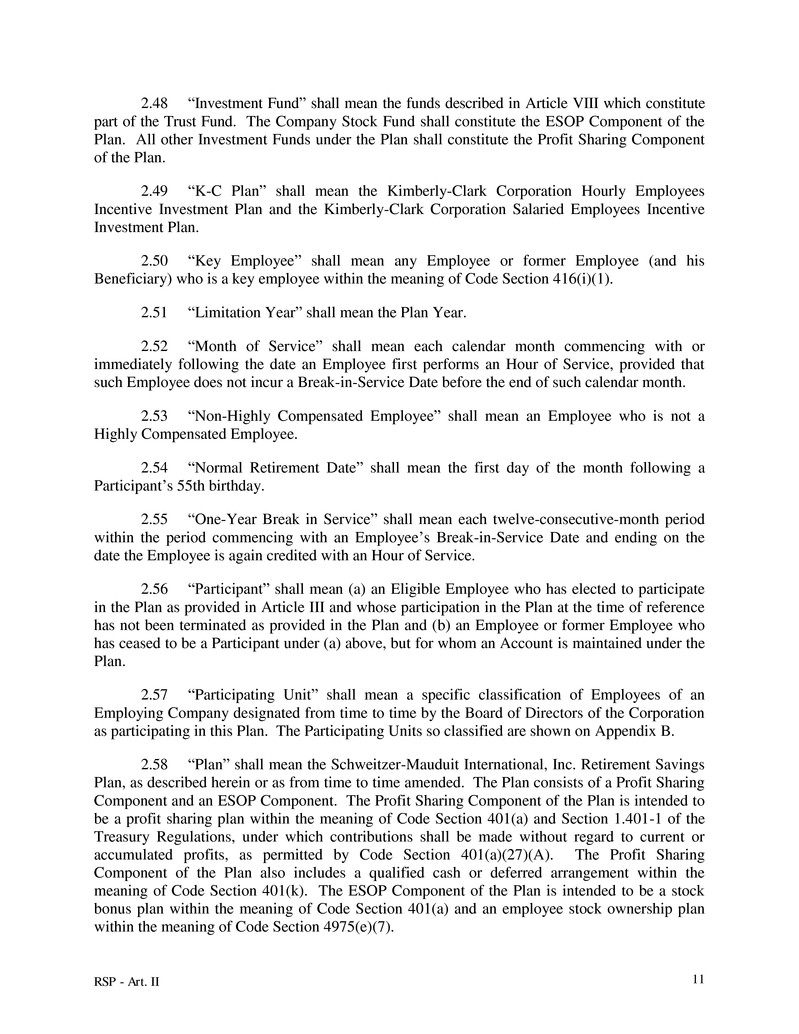
RSP - Art. II 11 2.48 “Investment Fund” shall mean the funds described in Article VIII which constitute part of the Trust Fund. The Company Stock Fund shall constitute the ESOP Component of the Plan. All other Investment Funds under the Plan shall constitute the Profit Sharing Component of the Plan. 2.49 “K-C Plan” shall mean the Kimberly-Clark Corporation Hourly Employees Incentive Investment Plan and the Kimberly-Clark Corporation Salaried Employees Incentive Investment Plan. 2.50 “Key Employee” shall mean any Employee or former Employee (and his Beneficiary) who is a key employee within the meaning of Code Section 416(i)(1). 2.51 “Limitation Year” shall mean the Plan Year. 2.52 “Month of Service” shall mean each calendar month commencing with or immediately following the date an Employee first performs an Hour of Service, provided that such Employee does not incur a Break-in-Service Date before the end of such calendar month. 2.53 “Non-Highly Compensated Employee” shall mean an Employee who is not a Highly Compensated Employee. 2.54 “Normal Retirement Date” shall mean the first day of the month following a Participant’s 55th birthday. 2.55 “One-Year Break in Service” shall mean each twelve-consecutive-month period within the period commencing with an Employee’s Break-in-Service Date and ending on the date the Employee is again credited with an Hour of Service. 2.56 “Participant” shall mean (a) an Eligible Employee who has elected to participate in the Plan as provided in Article III and whose participation in the Plan at the time of reference has not been terminated as provided in the Plan and (b) an Employee or former Employee who has ceased to be a Participant under (a) above, but for whom an Account is maintained under the Plan. 2.57 “Participating Unit” shall mean a specific classification of Employees of an Employing Company designated from time to time by the Board of Directors of the Corporation as participating in this Plan. The Participating Units so classified are shown on Appendix B. 2.58 “Plan” shall mean the Schweitzer-Mauduit International, Inc. Retirement Savings Plan, as described herein or as from time to time amended. The Plan consists of a Profit Sharing Component and an ESOP Component. The Profit Sharing Component of the Plan is intended to be a profit sharing plan within the meaning of Code Section 401(a) and Section 1.401-1 of the Treasury Regulations, under which contributions shall be made without regard to current or accumulated profits, as permitted by Code Section 401(a)(27)(A). The Profit Sharing Component of the Plan also includes a qualified cash or deferred arrangement within the meaning of Code Section 401(k). The ESOP Component of the Plan is intended to be a stock bonus plan within the meaning of Code Section 401(a) and an employee stock ownership plan within the meaning of Code Section 4975(e)(7).

RSP - Art. II 12 2.59 “Plan Year” shall mean the twelve-month period commencing January 1st and ending on the last day of December next following. 2.60 “Profit Sharing Component” shall mean the component of the Plan that (a) is not part of the ESOP Component of the Plan and (b) is designed to qualify as a profit sharing plan under Code Section 401(a) that includes a qualified cash or deferred arrangement within the meaning of Code Section 401(k). 2.61 “Record Date” shall mean the record date for purposes of dividends paid on Common Stock. 2.62 “Rollover Contribution” shall mean that portion of an eligible rollover distribution (as defined in Code Section 402(c)(4)) that a Participant elects to contribute to this Plan in accordance with the requirements of Section 4.10. 2.63 “Present Value of Accrued Retirement Income” shall mean an amount determined solely for the purpose of determining if the Plan, or any other plan included in a Required Aggregation Group of which the Plan is a part, is top heavy in accordance with Code Section 416. 2.64 “Surviving Spouse” shall mean the person to whom the Participant is legally married on the date of his death, if such spouse is then living. 2.65 “Supplemental Account” shall mean the account established and maintained to show as of any Valuation Date the total Forfeitures of all terminated or former Participants which have not yet become available for reallocation, as adjusted to reflect income, gains, losses and credits or charges applicable thereto. The Supplemental Account may be maintained as a single account under the Plan or may represent the total of separate bookkeeping accounts established in the name of each terminated or former Participant to represent his Forfeitures. 2.66 “Suspense Account” shall mean an account as described in Section 6.2. 2.67 “Top-Heavy Group” shall mean an Aggregation Group in which, as of the Determination Date, the sum of: (a) the Present Value of Accrued Retirement Income of Key Employees under all defined benefit plans included in that group, and (b) the Aggregate Accounts of Key Employees under all defined contribution plans included in the group, exceeds sixty percent (60%) of a similar sum determined for all employees. 2.68 “Total and Permanent Disability” shall mean a condition arising out of any injury or disease which the Committee determines is permanent and prevents a Participant from engaging in any occupation with the Affiliated Employers commensurate with his education, training and experience excluding:

RSP - Art. II 13 (a) any condition incurred in military service (other than temporary absence on military leave) if the Participant does not return to active employment with the Affiliated Employers at the end of his military service; (b) any condition incurred as a result of or incidental to a felonious act perpetrated by the Participant; and (c) any condition resulting from excessive use of drugs or narcotics or from willful self-inflicted injury. 2.69 “Trust” or “Trust Fund” shall mean the trust established pursuant to the Trust Agreement. 2.70 “Trust Agreement” shall mean the trust agreement between the Company and the Trustee, as described in Article XIV. 2.71 “Trustee” shall mean the person or corporation designated as trustee under the Trust Agreement, including any successor or successors. 2.72 “12-Month Work Schedule” shall mean the Hours of Service required for full performance on a 12-month basis of the job which the Employee is assigned to perform within a Plan Year. 2.73 “Valuation Date” shall mean each business day of the New York Stock Exchange. 2.74 “Year of Service” shall mean a twelve-month period of employment as an Employee, including any fractions thereof. Calculation of the twelve-month periods shall commence with the Employee’s first day of employment, which is the date on which an Employee first performs an Hour of Service, and shall terminate on his Break-in-Service Date. Thereafter, if he has more than one period of employment as an Employee, his Years of Service for any subsequent period shall commence with the Employee’s reemployment date, which is the first date following a Break-in-Service Date on which the Employee performs an Hour of Service, and shall terminate on his next Break-in-Service Date. An Employee who has a Break-in-Service Date and resumes employment with the Affiliated Employers within twelve months of his Break-in-Service Date shall receive a fractional Year of Service for the period of such absence from employment. With respect to an Employee of an Employing Company who transfers to an Employing Company from Kimberly-Clark Corporation on the effective date of the distribution of Common Stock to the shareholders of Kimberly-Clark Corporation, his credited years of service under the K- C Plan as of his date of transfer shall be treated as Years of Service. Years of service credited under the DelStar 401(k) Plan shall count for purposes of eligibility, vesting and benefits under the Plan. Notwithstanding anything in this Section to the contrary, an Employee shall not receive credit for more than one Year of Service with respect to any twelve-consecutive-month period.

RSP - Art. III 14 ARTICLE III PARTICIPATION 3.1 Eligibility Requirements. Unless otherwise specified in the Appendix B Schedules attached hereto, this Section 3.1 shall set forth the eligibility requirements for participation in the Plan. Each individual who was a participant in the Plan on December 31, 2014 and who is an Eligible Employee on January 1, 2015 shall be eligible to participate in the Plan on January 1, 2015. Each other Eligible Employee may elect to participate in the Plan as of any Enrollment Date following the date he first performs a Month of Service. An Eligible Employee shall make an election to participate by authorizing deductions from or reduction of his Compensation as contributions to the Plan in accordance with Article IV, and directing the investment of such contributions in accordance with Article VIII. Such Compensation deduction and/or reduction authorization and investment direction shall be made in accordance with the procedures established by the Committee. 3.2 Participation upon Reemployment. If an Employee terminates his employment with the Affiliated Employers after satisfying the eligibility requirements and is subsequently reemployed as an Eligible Employee, such individual may elect to participate as of the date he performs an Hour of Service upon his reemployment. If the Employee had not met the eligibility requirements before his termination, the Employee may elect to participate as of any Enrollment Date following the date such eligibility requirements are satisfied upon reemployment. 3.3 Loss of Eligible Employee Status. If a Participant loses his status as an Eligible Employee, but remains an Employee, such Participant shall be ineligible to participate and shall be deemed to have elected to suspend making After-Tax Contributions or having Before-Tax Contributions made on his behalf.
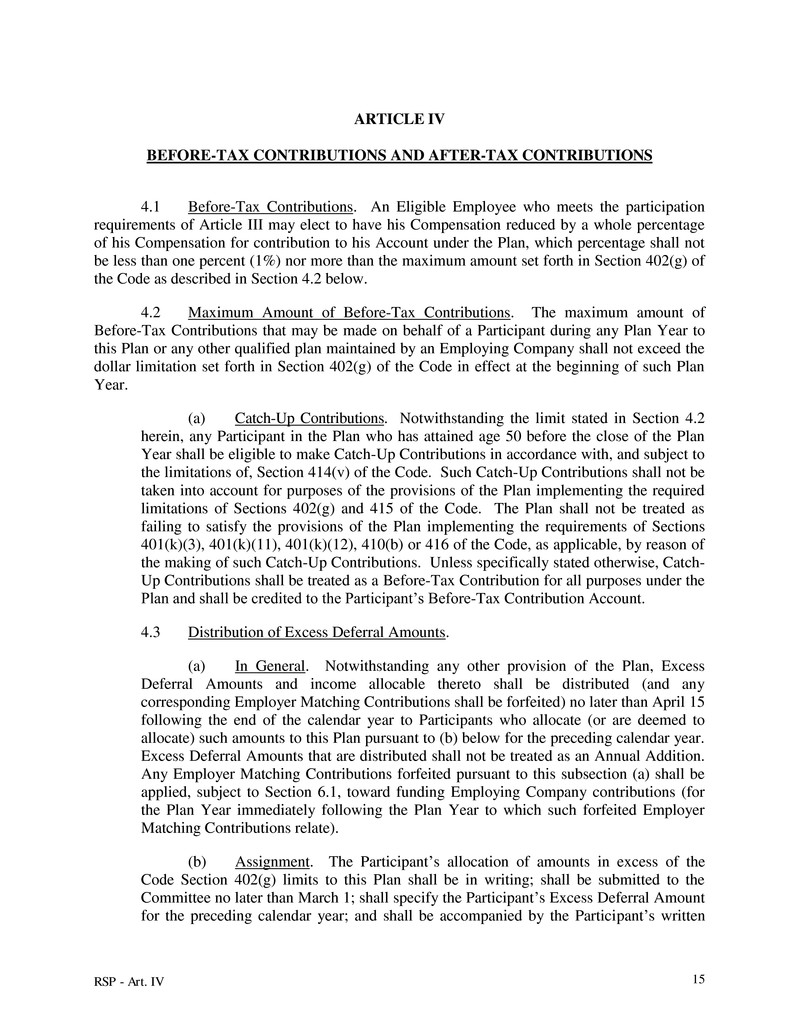
RSP - Art. IV 15 ARTICLE IV BEFORE-TAX CONTRIBUTIONS AND AFTER-TAX CONTRIBUTIONS 4.1 Before-Tax Contributions. An Eligible Employee who meets the participation requirements of Article III may elect to have his Compensation reduced by a whole percentage of his Compensation for contribution to his Account under the Plan, which percentage shall not be less than one percent (1%) nor more than the maximum amount set forth in Section 402(g) of the Code as described in Section 4.2 below. 4.2 Maximum Amount of Before-Tax Contributions. The maximum amount of Before-Tax Contributions that may be made on behalf of a Participant during any Plan Year to this Plan or any other qualified plan maintained by an Employing Company shall not exceed the dollar limitation set forth in Section 402(g) of the Code in effect at the beginning of such Plan Year. (a) Catch-Up Contributions. Notwithstanding the limit stated in Section 4.2 herein, any Participant in the Plan who has attained age 50 before the close of the Plan Year shall be eligible to make Catch-Up Contributions in accordance with, and subject to the limitations of, Section 414(v) of the Code. Such Catch-Up Contributions shall not be taken into account for purposes of the provisions of the Plan implementing the required limitations of Sections 402(g) and 415 of the Code. The Plan shall not be treated as failing to satisfy the provisions of the Plan implementing the requirements of Sections 401(k)(3), 401(k)(11), 401(k)(12), 410(b) or 416 of the Code, as applicable, by reason of the making of such Catch-Up Contributions. Unless specifically stated otherwise, Catch- Up Contributions shall be treated as a Before-Tax Contribution for all purposes under the Plan and shall be credited to the Participant’s Before-Tax Contribution Account. 4.3 Distribution of Excess Deferral Amounts. (a) In General. Notwithstanding any other provision of the Plan, Excess Deferral Amounts and income allocable thereto shall be distributed (and any corresponding Employer Matching Contributions shall be forfeited) no later than April 15 following the end of the calendar year to Participants who allocate (or are deemed to allocate) such amounts to this Plan pursuant to (b) below for the preceding calendar year. Excess Deferral Amounts that are distributed shall not be treated as an Annual Addition. Any Employer Matching Contributions forfeited pursuant to this subsection (a) shall be applied, subject to Section 6.1, toward funding Employing Company contributions (for the Plan Year immediately following the Plan Year to which such forfeited Employer Matching Contributions relate). (b) Assignment. The Participant’s allocation of amounts in excess of the Code Section 402(g) limits to this Plan shall be in writing; shall be submitted to the Committee no later than March 1; shall specify the Participant’s Excess Deferral Amount for the preceding calendar year; and shall be accompanied by the Participant’s written

RSP - Art. IV 16 statement that if such amounts are not distributed, such Excess Deferral Amount, when added to amounts deferred under other plans or arrangements described in Section 401(k), 408(k), 408(p), 402(h)(1)(B), 457, 501(c)(18), or 403(b) of the Code plus amounts includible in gross income for the taxable year under Section 402(A) of the Code exceeds the limit imposed on the Participant by Section 402(g) of the Code for the year in which the deferral occurred. A Participant is deemed to notify the Committee of any Excess Deferral Amounts that arise by taking into account only those deferrals under this Plan and any other plans of an Employing Company. (c) Determination of Income or Loss. The Excess Deferral Amount distributed to a Participant with respect to a calendar year shall be adjusted for income or loss, through the last day of the Plan Year to which the Excess Deferral Amount relates. The Committee may designate any reasonable method for computing the income or loss allocable to Excess Deferral Amounts, provided that the method does not violate Section 401(a)(4) or Section 401(k) of the Code, is used consistently for all Participants and for all corrective distributions under the Plan for the Plan Year, and is used by the Plan for allocating income or loss to Participants’ Accounts. (d) Maximum Distribution Amount. The Excess Deferral Amount, which would otherwise be distributed to the Participant, shall, if there is a loss allocable to such Excess Deferral Amount, in no event be less than the lesser of the Participant’s Account under the Plan attributable to Before-Tax Contributions or the Participant’s Before-Tax Contributions for the Plan Year. 4.4 Additional Rules Regarding Before-Tax Contributions. Salary reduction agreements shall be governed by the following: (a) A salary reduction agreement shall apply to payroll periods during which such salary reduction agreement is in effect. The Committee, in its discretion, may establish administrative procedures whereby the actual reduction in Compensation may be made to coincide with each payroll period of the Employing Company, or at such other times as the Committee may determine. (b) The Employing Company may amend or revoke its salary reduction agreement with any Participant at any time, if the Employing Company determines that such revocation or amendment is necessary to ensure that a Participant’s additions for any Plan Year will not exceed the limitations of Sections 4.2 and 6.1 of the Plan or to ensure that the Actual Deferral Percentage Test is satisfied. (c) Except as required under (b) above, and under Section 4.5(c) below, no amounts attributable to Before-Tax Contributions may be distributed to a Participant or his Beneficiary from his Account prior to the earlier of: (1) the severance from employment, death or disability of the Participant; (2) the attainment of age 59-1/2 by the Participant;

RSP - Art. IV 17 (3) the termination of the Plan without establishment of a successor plan; (4) a financial hardship of the Participant pursuant to Section 11.5 of the Plan or a military service withdrawal pursuant to Section 17.6(d) of the Plan; (5) the date of a sale by an Employing Company to an entity that is not an Affiliated Employer of substantially all of the assets (within the meaning of Code Section 409(d)(2)) with respect to a Participant who continues employment with the corporation acquiring such assets; or (6) the date of the sale by an Employing Company or an Affiliated Employer of its interest in a subsidiary (within the meaning of Code Section 409(d)(3)) to an entity which is not an Affiliated Employer with respect to the Participant who continues employment with such subsidiary. 4.5 Section 401(k) Nondiscrimination Tests. (a) Actual Deferral Percentage Test. For any Plan Year that the Plan does not meet the requirements of Section 4.11 of the Plan, the Plan shall satisfy the nondiscrimination test of Section 401(k)(3) of the Code, under which no Before-Tax Contributions shall be made that would cause the Actual Deferral Percentage for Eligible Participants who are Highly Compensated Employees to exceed (1) or (2) as follows: (1) The Average Actual Deferral Percentage for the Eligible Participants who are Highly Compensated Employees in the current Plan Year shall not exceed the Average Actual Deferral Percentage of the prior Plan Year for Eligible Participants who were Non-Highly Compensated Employees in the prior Plan Year multiplied by 1.25; or (2) The Average Actual Deferral Percentage for Eligible Participants who are Highly Compensated Employees in the current Plan Year shall not exceed the Average Actual Deferral Percentage of the prior Plan Year for Eligible Participants who were Non-Highly Compensated Employees in the prior Plan Year multiplied by two (2), provided that the Average Actual Deferral Percentage of the current Plan Year for Eligible Participants who are Highly Compensated Employees in the current Plan Year does not exceed the Average Actual Deferral Percentage of the prior Plan Year for Eligible Participants who were Non-Highly Compensated Employees in the prior Plan Year by more than two (2) percentage points. Notwithstanding the preceding, for any Plan Year that the Plan meets the safe harbor requirements of Section 401(k)(12) of the Code as described in Section 4.11 of the Plan,
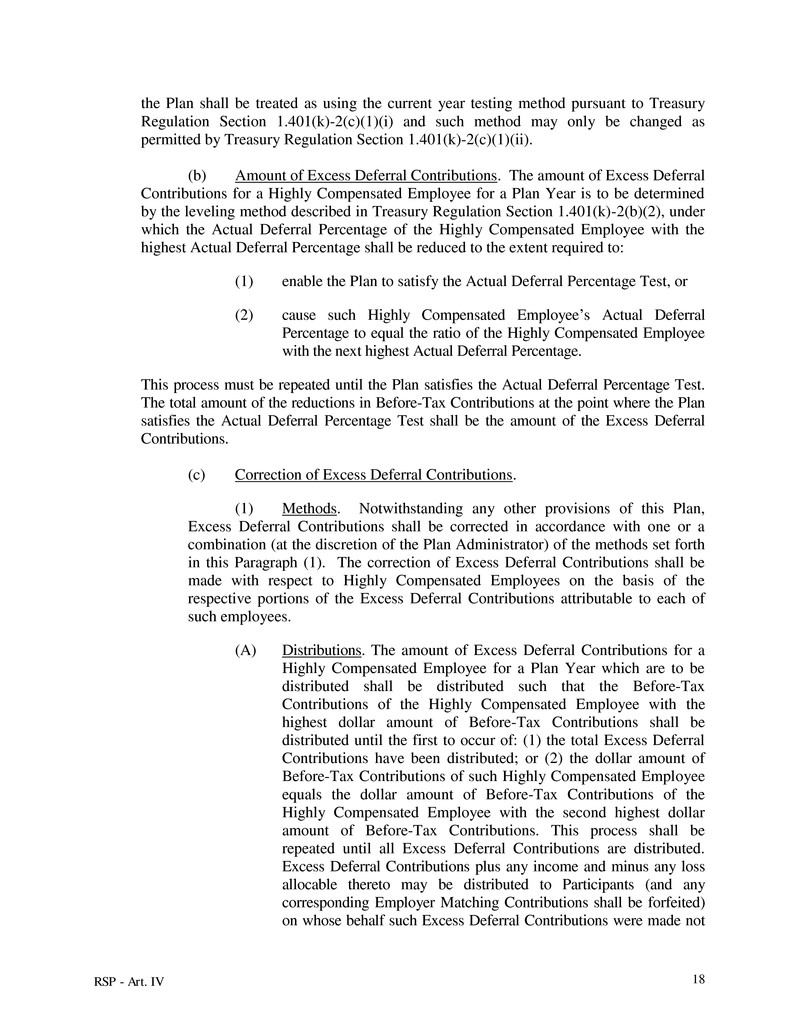
RSP - Art. IV 18 the Plan shall be treated as using the current year testing method pursuant to Treasury Regulation Section 1.401(k)-2(c)(1)(i) and such method may only be changed as permitted by Treasury Regulation Section 1.401(k)-2(c)(1)(ii). (b) Amount of Excess Deferral Contributions. The amount of Excess Deferral Contributions for a Highly Compensated Employee for a Plan Year is to be determined by the leveling method described in Treasury Regulation Section 1.401(k)-2(b)(2), under which the Actual Deferral Percentage of the Highly Compensated Employee with the highest Actual Deferral Percentage shall be reduced to the extent required to: (1) enable the Plan to satisfy the Actual Deferral Percentage Test, or (2) cause such Highly Compensated Employee’s Actual Deferral Percentage to equal the ratio of the Highly Compensated Employee with the next highest Actual Deferral Percentage. This process must be repeated until the Plan satisfies the Actual Deferral Percentage Test. The total amount of the reductions in Before-Tax Contributions at the point where the Plan satisfies the Actual Deferral Percentage Test shall be the amount of the Excess Deferral Contributions. (c) Correction of Excess Deferral Contributions. (1) Methods. Notwithstanding any other provisions of this Plan, Excess Deferral Contributions shall be corrected in accordance with one or a combination (at the discretion of the Plan Administrator) of the methods set forth in this Paragraph (1). The correction of Excess Deferral Contributions shall be made with respect to Highly Compensated Employees on the basis of the respective portions of the Excess Deferral Contributions attributable to each of such employees. (A) Distributions. The amount of Excess Deferral Contributions for a Highly Compensated Employee for a Plan Year which are to be distributed shall be distributed such that the Before-Tax Contributions of the Highly Compensated Employee with the highest dollar amount of Before-Tax Contributions shall be distributed until the first to occur of: (1) the total Excess Deferral Contributions have been distributed; or (2) the dollar amount of Before-Tax Contributions of such Highly Compensated Employee equals the dollar amount of Before-Tax Contributions of the Highly Compensated Employee with the second highest dollar amount of Before-Tax Contributions. This process shall be repeated until all Excess Deferral Contributions are distributed. Excess Deferral Contributions plus any income and minus any loss allocable thereto may be distributed to Participants (and any corresponding Employer Matching Contributions shall be forfeited) on whose behalf such Excess Deferral Contributions were made not

RSP - Art. IV 19 later than twelve (12) months following the close of the Plan Year for which such contributions were made. If such Excess Deferral Contributions are distributed more than two and one-half (2-1/2) months after the last day of the Plan Year in which such excess amounts arose, a ten percent (10%) excise tax will be imposed on the Employing Company maintaining the Plan with respect to such Excess Deferral Contributions. Any amounts forfeited pursuant to this Paragraph (A) shall be applied, subject to Section 6.1, toward funding the Employing Company contributions for the Plan Year immediately following the Plan Year to which such Employer Matching Contributions relate. (B) Employer Contributions. Qualified nonelective deferral contributions may be made, in the sole discretion of the Employing Company, in the event that the Actual Deferral Percentage Test is not satisfied. Qualified nonelective deferral contributions shall mean nonforfeitable contributions made by the Employing Company and allocated to a Participant’s subaccount for Before- Tax Contributions under the Plan that the Participant may not elect to receive in cash until distributed from the Plan. Qualified nonelective deferral contributions are not available for hardship withdrawal and are subject to the distribution restrictions on Before-Tax Contributions under this Plan. Such contributions shall be made on behalf of each Non-Highly Compensated Employee Participant in the amount necessary to satisfy the limitations of the Actual Deferral Percentage Test and shall be allocated among the Before-Tax Contribution subaccounts of such Participants in the proportion that each Non-Highly Compensated Employee Participant’s Compensation bears to the Compensation of all such Non-Highly Compensated Employee Participants. Qualified nonelective deferral contributions shall be treated as Participant Before-Tax Contributions for all purposes of this Plan and taken into account under the Actual Deferral Percentage Test, except that such contributions shall not be eligible for Employer Matching Contributions. In addition, such contributions shall meet each of those conditions set forth in Treasury Regulation Section 1.401(k)-2(a)(6). (C) Recharacterization. Excess Deferral Contributions (plus any income and minus any loss) with respect to a Participant may be recharacterized as After-Tax Contributions (and any corresponding Employer Matching Contributions shall be forfeited) in accordance with the requirements of Treasury Regulation Section 1.401(k)- 2(b)(3) and shall be included in the Actual Contribution Percentage Test; however, such amounts shall be treated as Before-Tax Contributions for all other purposes hereunder. Any amounts forfeited pursuant to this Paragraph (c) shall be applied subject to
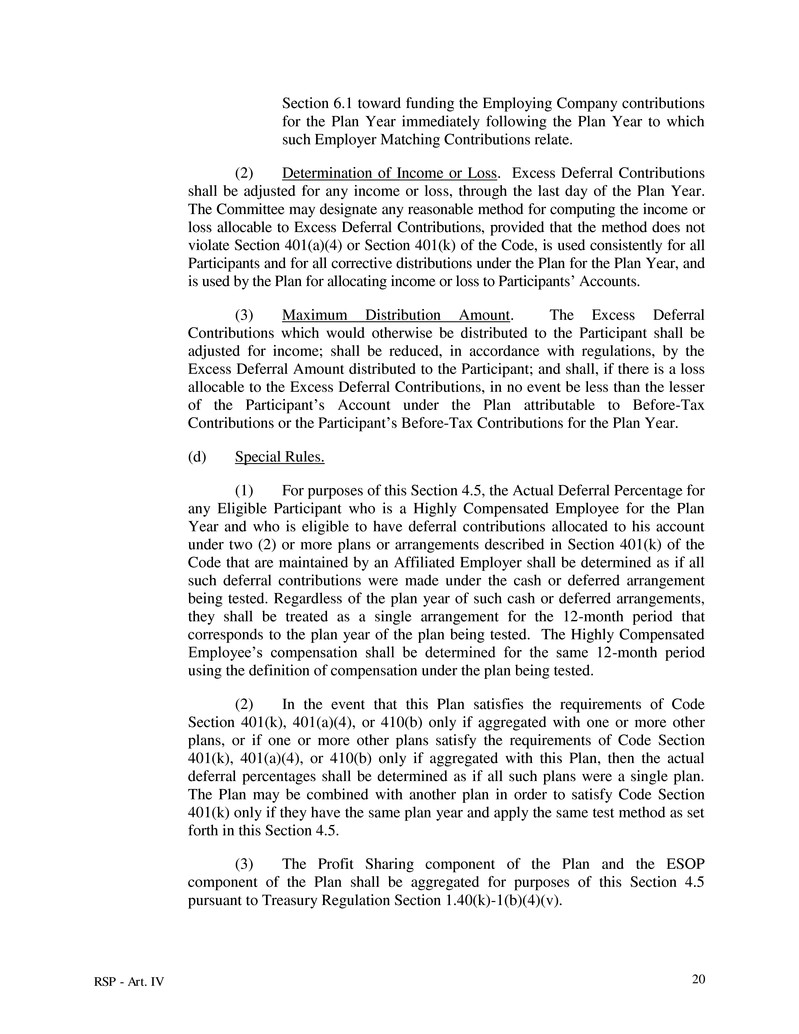
RSP - Art. IV 20 Section 6.1 toward funding the Employing Company contributions for the Plan Year immediately following the Plan Year to which such Employer Matching Contributions relate. (2) Determination of Income or Loss. Excess Deferral Contributions shall be adjusted for any income or loss, through the last day of the Plan Year. The Committee may designate any reasonable method for computing the income or loss allocable to Excess Deferral Contributions, provided that the method does not violate Section 401(a)(4) or Section 401(k) of the Code, is used consistently for all Participants and for all corrective distributions under the Plan for the Plan Year, and is used by the Plan for allocating income or loss to Participants’ Accounts. (3) Maximum Distribution Amount. The Excess Deferral Contributions which would otherwise be distributed to the Participant shall be adjusted for income; shall be reduced, in accordance with regulations, by the Excess Deferral Amount distributed to the Participant; and shall, if there is a loss allocable to the Excess Deferral Contributions, in no event be less than the lesser of the Participant’s Account under the Plan attributable to Before-Tax Contributions or the Participant’s Before-Tax Contributions for the Plan Year. (d) Special Rules. (1) For purposes of this Section 4.5, the Actual Deferral Percentage for any Eligible Participant who is a Highly Compensated Employee for the Plan Year and who is eligible to have deferral contributions allocated to his account under two (2) or more plans or arrangements described in Section 401(k) of the Code that are maintained by an Affiliated Employer shall be determined as if all such deferral contributions were made under the cash or deferred arrangement being tested. Regardless of the plan year of such cash or deferred arrangements, they shall be treated as a single arrangement for the 12-month period that corresponds to the plan year of the plan being tested. The Highly Compensated Employee’s compensation shall be determined for the same 12-month period using the definition of compensation under the plan being tested. (2) In the event that this Plan satisfies the requirements of Code Section 401(k), 401(a)(4), or 410(b) only if aggregated with one or more other plans, or if one or more other plans satisfy the requirements of Code Section 401(k), 401(a)(4), or 410(b) only if aggregated with this Plan, then the actual deferral percentages shall be determined as if all such plans were a single plan. The Plan may be combined with another plan in order to satisfy Code Section 401(k) only if they have the same plan year and apply the same test method as set forth in this Section 4.5. (3) The Profit Sharing component of the Plan and the ESOP component of the Plan shall be aggregated for purposes of this Section 4.5 pursuant to Treasury Regulation Section 1.40(k)-1(b)(4)(v).

RSP - Art. IV 21 (4) The determination and treatment of the Before-Tax Contributions and Actual Deferral Percentage of any Eligible Participant shall satisfy such other requirements as may be prescribed by the Secretary of the Treasury. 4.6 After-Tax Contributions. An Eligible Employee who meets the participation requirements of Article III may elect in accordance with the procedures established by the Committee to contribute to his Account an After-Tax Contribution consisting of any whole percentage of his Compensation, which percentage is not less than one percent (1%) nor more than ten percent (10%) of his Compensation. 4.7 Manner and Time of Payment of Before-Tax Contributions and After-Tax Contributions. Contributions made in accordance with Sections 4.1 and 4.6 will be rounded to the next higher multiple of one cent for each payroll period. They will be made only through payroll deductions and will begin with the first payroll period (or as soon as practicable thereafter) commencing after the Enrollment Date on which the Participant commences participation in the Plan. Contributions shall be remitted to the Trustee as of the earliest date on which such contributions can reasonably be segregated from each Employing Company’s general assets, but in any event not later than the fifteenth (15th) business day of the month following the month in which such amounts would otherwise have been payable to the Participant in cash. 4.8 Change in Contribution Rate. A Participant may prospectively change the percentage of his Compensation that he has authorized as the Before-Tax Contribution to be made on his behalf or his After-Tax Contribution to another permissible percentage in accordance with the procedures established by the Committee to be effective as soon as administratively feasible after such change has been requested. 4.9 Change in Contribution Amount. In the event of a change in the Compensation of a Participant, the percentage of the Before-Tax Contribution made on his behalf or his After-Tax Contribution currently in effect shall be applied as soon as practicable with respect to such changed Compensation without action by the Participant. 4.10 Rollover Contributions and Transfers from Other Plans. The Plan will only accept a Direct Rollover of an Eligible Rollover Distribution from a qualified plan described in Section 401(a) or 403(a) of the Code, excluding after-tax employee contributions, and Participant Rollover Contributions of Eligible Rollover Distributions from a qualified plan described in Section 401(a) or 403(a) of the Code. The Plan will not accept rollovers from individual retirement accounts or rollovers of amounts distributed from a designated Roth account (as defined in Code Section 402(A) as amended) or from a Roth IRA (as defined in Code Section 408(A) as amended). Notwithstanding the foregoing, an Eligible Employee who elects to rollover all or a portion of his distribution from a K-C Plan may elect to make such rollover to this Plan in cash. A Participant Rollover Contribution may be made only within sixty (60) days following the date the Eligible Employee receives the distribution. The Trustee may also receive directly from the trustee under the qualified plan of the former employer all or any portion (as designated by such Participant in writing to the Plan Administrator) of an eligible rollover distribution that would otherwise be distributable to the Participant by reason of his termination of employment with that employer.

RSP - Art. IV 22 The Plan Administrator may establish rules and procedures to implement this Section 4.10, including without limitation, such procedures as may be appropriate to verify the tax qualified status of the plan of the former employer and compliance with any applicable provisions of the Code relating to such contributions and transfers. Notwithstanding the preceding provisions of this Section 4.10, the Trustee shall not accept a transfer of an Eligible Employee’s interest in a retirement plan of a former employer if it is determined that such acceptance would render this Plan a direct or indirect transferee of a defined benefit plan, a money purchase pension plan (including a target benefit plan), a stock bonus plan, or a profit sharing plan that provides for a life annuity form of payment to the Participant unless the Trustee determines that such transfer constitutes a “direct rollover” within the meaning of Code Section 401(a)(31) and the Treasury Regulations thereunder. 4.11 Code Section 401(k)(12) Safe Harbor. (a) Rules of Application. The provisions of this Section 4.11 shall apply for all Plan Years beginning on and after January 1, 2015 unless and until this Section 4.11 is amended, and shall control over any other provisions of the Plan to the contrary. (b) Safe Harbor Employer Matching Contributions. Each Employing Company shall contribute a Safe Harbor Employer Matching Contribution on behalf of its Eligible Participants in accordance with Section 5.1 of the Plan, or as otherwise specified in Section 5.1 of the Appendix B Schedules. Such Safe Harbor Employer Matching Contribution shall meet the requirements of Code Sections 401(k)(12) and Treas. Reg. 1.401(k)-3. The allocation period for purposes of calculating the amount of Safe Harbor Matching Contributions is each payroll period. (c) Vesting and Limitation. The Safe Harbor Employer Matching Contributions shall be 100% vested in accordance with Section 10.01, and are subject to the applicable maximum limitations provided in Article VI. (d) Nondiscrimination Testing. For each Plan Year in which the Safe Harbor Employer Matching Contributions are made in accordance with this Section 4.11, the Actual Deferral Percentage test described under Section 4.5 shall be deemed satisfied. The Actual Contribution Percentage Test described under Section 5.4 shall continue to apply with respect to Safe Harbor Employer Matching Contributions and After-Tax Contributions that are made during each Plan Year. In conducting such Actual Contribution Percentage Test, the rules described in Treas. Reg. Section 1.401(m)- 2(a)(5)(iv) may be used. (e) Notice and Election Requirements. At least 30 days, but not more than 90 days, before the beginning of the Plan Year, the Committee shall furnish each Eligible Participant a notice of the Eligible Participant’s rights and obligations under the Plan with respect to the Safe Harbor Employer Matching Contribution. If an Employee becomes eligible after the 90th day before the beginning of the Plan Year and does not receive the notice for that reason, the notice must be provided no more than 90 days before the Employee becomes eligible but not later than the date the Employee becomes eligible. In addition to any other election periods provided under the Plan, each Participant may
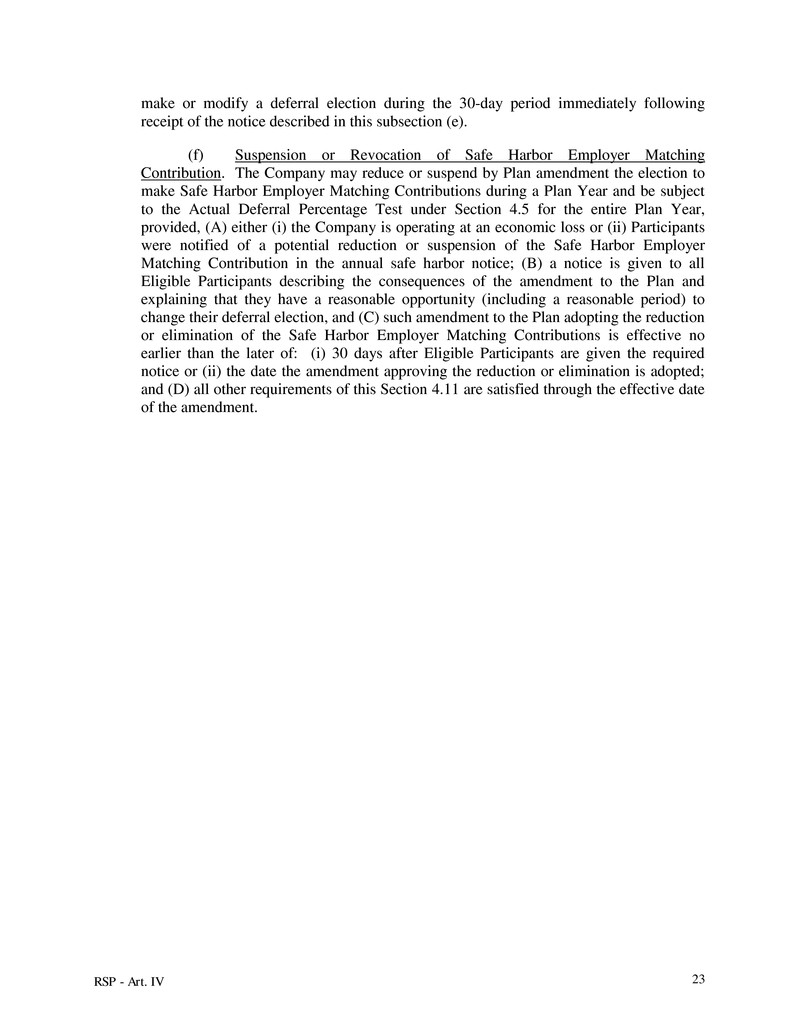
RSP - Art. IV 23 make or modify a deferral election during the 30-day period immediately following receipt of the notice described in this subsection (e). (f) Suspension or Revocation of Safe Harbor Employer Matching Contribution. The Company may reduce or suspend by Plan amendment the election to make Safe Harbor Employer Matching Contributions during a Plan Year and be subject to the Actual Deferral Percentage Test under Section 4.5 for the entire Plan Year, provided, (A) either (i) the Company is operating at an economic loss or (ii) Participants were notified of a potential reduction or suspension of the Safe Harbor Employer Matching Contribution in the annual safe harbor notice; (B) a notice is given to all Eligible Participants describing the consequences of the amendment to the Plan and explaining that they have a reasonable opportunity (including a reasonable period) to change their deferral election, and (C) such amendment to the Plan adopting the reduction or elimination of the Safe Harbor Employer Matching Contributions is effective no earlier than the later of: (i) 30 days after Eligible Participants are given the required notice or (ii) the date the amendment approving the reduction or elimination is adopted; and (D) all other requirements of this Section 4.11 are satisfied through the effective date of the amendment.

RSP - Art. V 24 ARTICLE V EMPLOYER MATCHING CONTRIBUTIONS 5.1 Amount of Employer Matching Contributions. Unless otherwise specified in the Appendix B Schedules attached hereto, the Employer Matching Contribution made on behalf of a Participant shall be made in accordance with this Section 5.1. Effective for Plan Years beginning on or after January 1, 2015, the Employing Companies shall contribute as an Employer Matching Contribution on behalf of each Participant who has elected to make Before- Tax Contributions and Catch-Up Contributions an amount equal to the whole percentages of the Participant’s aggregate Before-Tax Contributions and Catch-Up Contributions set forth below that do not exceed the lesser of (i) ten percent (10%) of the Participant’s Compensation for such Plan Year, or (ii) the limitations set forth in Code Section 402(g) and Code Section 414(v). If a Participant’s Before-Tax Contributions are limited by Code Section 402(g) or, a Participant’s Catch-Up Contributions are limited by Code Section 414(v), the Employing Company shall contribute as an Employer Matching Contribution on behalf of each Participant who has elected to make After-Tax Contributions an amount equal to the percentages of such After-Tax Contributions set forth below. Notwithstanding the preceding, in no event shall Employer Matching Contributions, with respect to any Plan Year, be made on Before-Tax Contributions, Catch-Up Contributions and After-Tax Contributions which, in the aggregate, exceeds ten percent (10%) of the Participant’s Compensation. Employee Contribution Company Match 0 – 3% 100% 4 – 8% 50% 9 – 10% 25% Effective for Plan Years beginning on or after January 1, 2015, contributions made pursuant to this Section 5.1 shall be “Safe Harbor Employer Matching Contributions” and shall meet the requirements set forth in Section 4.11 of the Plan. 5.2 Investment of Employer Matching Contributions. Employer Matching Contributions shall be made in cash and invested in accordance with the Participant’s Investment Fund elections and allocations. 5.3 Payment of Employer Matching Contributions. Except as provided herein, Employer Matching Contributions shall be remitted to the Trustee as soon as practicable.

RSP - Art. V 25 5.4 Section 401(m) Nondiscrimination Tests. (a) Actual Contribution Percentage Test. The Plan shall satisfy the nondiscrimination test of Section 401(m) of the Code, under which the Average Contribution Percentage for Eligible Participants who are Highly Compensated Employees shall not exceed (1) or (2) as follows: (1) The Average Contribution Percentage for Eligible Participants who are Highly Compensated Employees in the current Plan Year shall not exceed the Average Contribution Percentage of the prior Plan Year for Eligible Participants who were Non-Highly Compensated Employees in the prior Plan Year multiplied by 1.25%; or (2) The Average Contribution Percentage for Eligible Participants who are Highly Compensated Employees in the current Plan Year shall not exceed the Average Contribution Percentage of the prior Plan Year for Eligible Participants who were Non-Highly Compensated Employees in the prior Plan Year multiplied by two (2), provided that the Average Contribution Percentage for Eligible Participants who are Highly Compensated Employees in the current Plan Year does not exceed the Average Contribution Percentage for Eligible Participants who were Non-Highly Compensated Employees in the prior Plan Year by more than two (2) percentage points. (b) Amount of Excess Aggregate Contributions. The amount of Excess Aggregate Contributions for a Highly Compensated Employee for a Plan Year is to be determined by the leveling method described in Treasury Regulation Section 1.401(m)-2(b)(2), under which the Contribution Percentage of the Highly Compensated Employee with the highest Contribution Percentage shall be reduced to the extent required to: (1) enable the Plan to satisfy the Actual Contribution Percentage Test, or (2) cause such Highly Compensated Employee’s Contribution Percentage to equal the ratio of the Highly Compensated Employee with the next highest Contribution Percentage. This process must be repeated until the Plan satisfies the Actual Contribution Percentage Test. The total amount of the reductions in After-Tax Contributions and Employer Contributions at the point where the Plan satisfies the Actual Contribution Percentage Test shall be the amount of the Excess Aggregate Contributions. (c) Correction of Excess Aggregate Contributions. (1) In General. Notwithstanding any other provision of this Plan, Excess Aggregate Contributions, plus any income and minus any loss allocable thereto, shall be distributed (or, if forfeitable, forfeited) no later than the last day
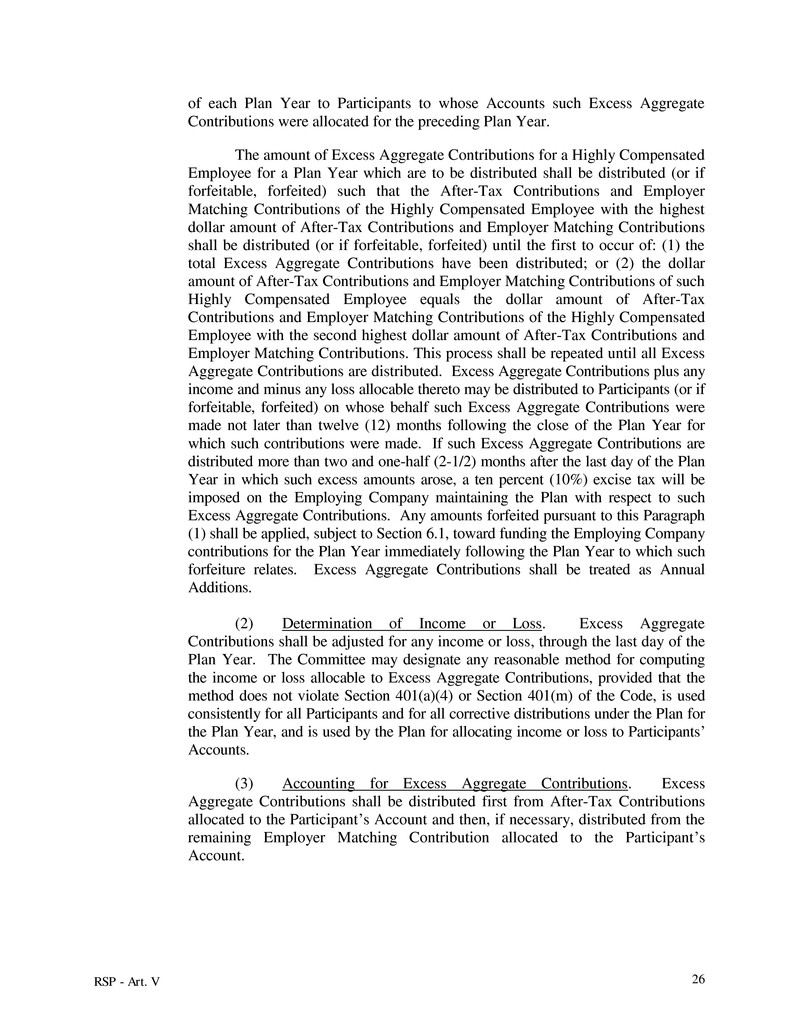
RSP - Art. V 26 of each Plan Year to Participants to whose Accounts such Excess Aggregate Contributions were allocated for the preceding Plan Year. The amount of Excess Aggregate Contributions for a Highly Compensated Employee for a Plan Year which are to be distributed shall be distributed (or if forfeitable, forfeited) such that the After-Tax Contributions and Employer Matching Contributions of the Highly Compensated Employee with the highest dollar amount of After-Tax Contributions and Employer Matching Contributions shall be distributed (or if forfeitable, forfeited) until the first to occur of: (1) the total Excess Aggregate Contributions have been distributed; or (2) the dollar amount of After-Tax Contributions and Employer Matching Contributions of such Highly Compensated Employee equals the dollar amount of After-Tax Contributions and Employer Matching Contributions of the Highly Compensated Employee with the second highest dollar amount of After-Tax Contributions and Employer Matching Contributions. This process shall be repeated until all Excess Aggregate Contributions are distributed. Excess Aggregate Contributions plus any income and minus any loss allocable thereto may be distributed to Participants (or if forfeitable, forfeited) on whose behalf such Excess Aggregate Contributions were made not later than twelve (12) months following the close of the Plan Year for which such contributions were made. If such Excess Aggregate Contributions are distributed more than two and one-half (2-1/2) months after the last day of the Plan Year in which such excess amounts arose, a ten percent (10%) excise tax will be imposed on the Employing Company maintaining the Plan with respect to such Excess Aggregate Contributions. Any amounts forfeited pursuant to this Paragraph (1) shall be applied, subject to Section 6.1, toward funding the Employing Company contributions for the Plan Year immediately following the Plan Year to which such forfeiture relates. Excess Aggregate Contributions shall be treated as Annual Additions. (2) Determination of Income or Loss. Excess Aggregate Contributions shall be adjusted for any income or loss, through the last day of the Plan Year. The Committee may designate any reasonable method for computing the income or loss allocable to Excess Aggregate Contributions, provided that the method does not violate Section 401(a)(4) or Section 401(m) of the Code, is used consistently for all Participants and for all corrective distributions under the Plan for the Plan Year, and is used by the Plan for allocating income or loss to Participants’ Accounts. (3) Accounting for Excess Aggregate Contributions. Excess Aggregate Contributions shall be distributed first from After-Tax Contributions allocated to the Participant’s Account and then, if necessary, distributed from the remaining Employer Matching Contribution allocated to the Participant’s Account.
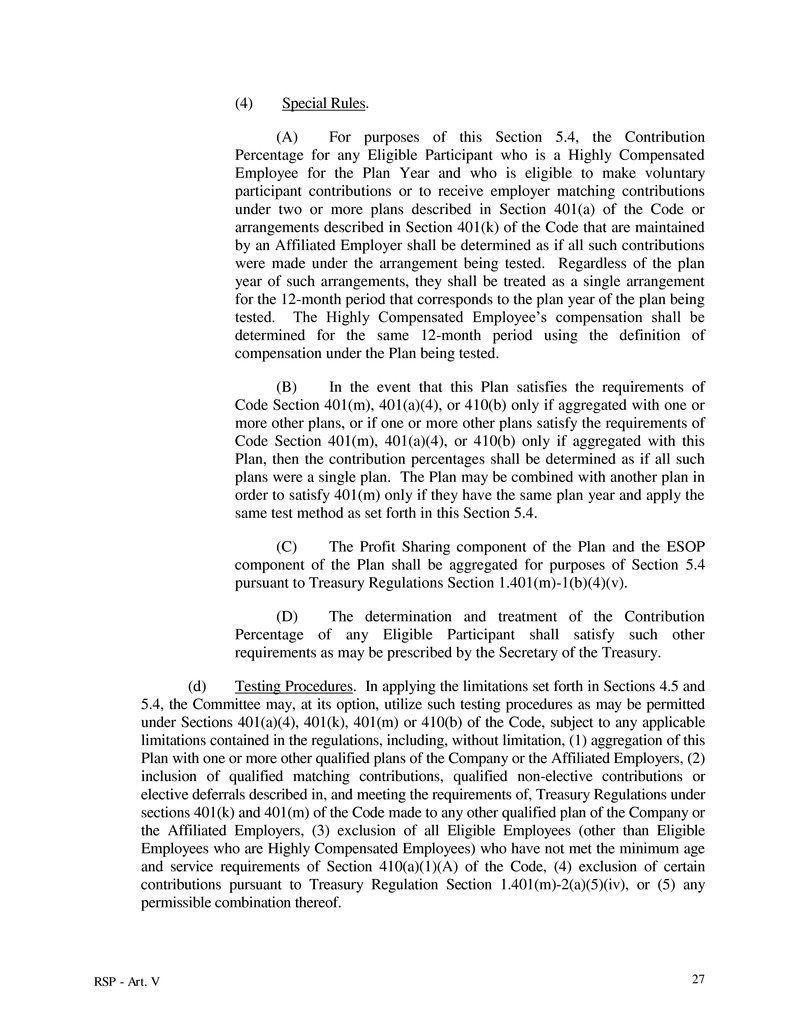
RSP - Art. V 27 (4) Special Rules. (A) For purposes of this Section 5.4, the Contribution Percentage for any Eligible Participant who is a Highly Compensated Employee for the Plan Year and who is eligible to make voluntary participant contributions or to receive employer matching contributions under two or more plans described in Section 401(a) of the Code or arrangements described in Section 401(k) of the Code that are maintained by an Affiliated Employer shall be determined as if all such contributions were made under the arrangement being tested. Regardless of the plan year of such arrangements, they shall be treated as a single arrangement for the 12-month period that corresponds to the plan year of the plan being tested. The Highly Compensated Employee’s compensation shall be determined for the same 12-month period using the definition of compensation under the Plan being tested. (B) In the event that this Plan satisfies the requirements of Code Section 401(m), 401(a)(4), or 410(b) only if aggregated with one or more other plans, or if one or more other plans satisfy the requirements of Code Section 401(m), 401(a)(4), or 410(b) only if aggregated with this Plan, then the contribution percentages shall be determined as if all such plans were a single plan. The Plan may be combined with another plan in order to satisfy 401(m) only if they have the same plan year and apply the same test method as set forth in this Section 5.4. (C) The Profit Sharing component of the Plan and the ESOP component of the Plan shall be aggregated for purposes of Section 5.4 pursuant to Treasury Regulations Section 1.401(m)-1(b)(4)(v). (D) The determination and treatment of the Contribution Percentage of any Eligible Participant shall satisfy such other requirements as may be prescribed by the Secretary of the Treasury. (d) Testing Procedures. In applying the limitations set forth in Sections 4.5 and 5.4, the Committee may, at its option, utilize such testing procedures as may be permitted under Sections 401(a)(4), 401(k), 401(m) or 410(b) of the Code, subject to any applicable limitations contained in the regulations, including, without limitation, (1) aggregation of this Plan with one or more other qualified plans of the Company or the Affiliated Employers, (2) inclusion of qualified matching contributions, qualified non-elective contributions or elective deferrals described in, and meeting the requirements of, Treasury Regulations under sections 401(k) and 401(m) of the Code made to any other qualified plan of the Company or the Affiliated Employers, (3) exclusion of all Eligible Employees (other than Eligible Employees who are Highly Compensated Employees) who have not met the minimum age and service requirements of Section 410(a)(1)(A) of the Code, (4) exclusion of certain contributions pursuant to Treasury Regulation Section 1.401(m)-2(a)(5)(iv), or (5) any permissible combination thereof.

RSP - Art. V 28 5.5 Reversion of Employing Company Contributions. Except as specifically provided in this Plan, no amounts shall revert to the Employing Company. Employing Company contributions computed in accordance with the provisions of this Plan shall revert to the Employing Company under the following circumstances: (a) In the case of an Employing Company contribution which is made by reason of a mistake of fact, such contribution upon written direction of the Employing Company shall be returned to the Employing Company within one year after the payment of the contribution. (b) If any Employing Company contribution is determined to be nondeductible under Section 404 of the Code, then such Employing Company contribution, to the extent that it is determined to be nondeductible, upon written direction of the Employing Company shall be returned to the Employing Company within one year after the disallowance of the deduction. All contributions by any Employing Company made to this Plan are hereby expressly conditioned on their deductibility for federal income tax purposes under section 404 of the Code. 5.6 Correction of Prior Incorrect Allocations and Distributions. Notwithstanding any provisions contained herein to the contrary, in the event that, as of any Valuation Date, adjustments are required in any Participants’ Accounts to correct any incorrect allocation of contributions or investment earnings or losses, or such other discrepancies in Account balances that may have occurred previously, the Employing Companies may make additional contributions to the Plan to be applied to correct such incorrect allocations or discrepancies. The additional contributions shall be allocated by the Committee to adjust such Participants’ Accounts to the value which would have existed on said Valuation Date had there been no prior incorrect allocation or discrepancies. The Committee shall also be authorized to take such other actions as it deems necessary to correct prior incorrect allocations or discrepancies in the Accounts of Participants under the Plan.
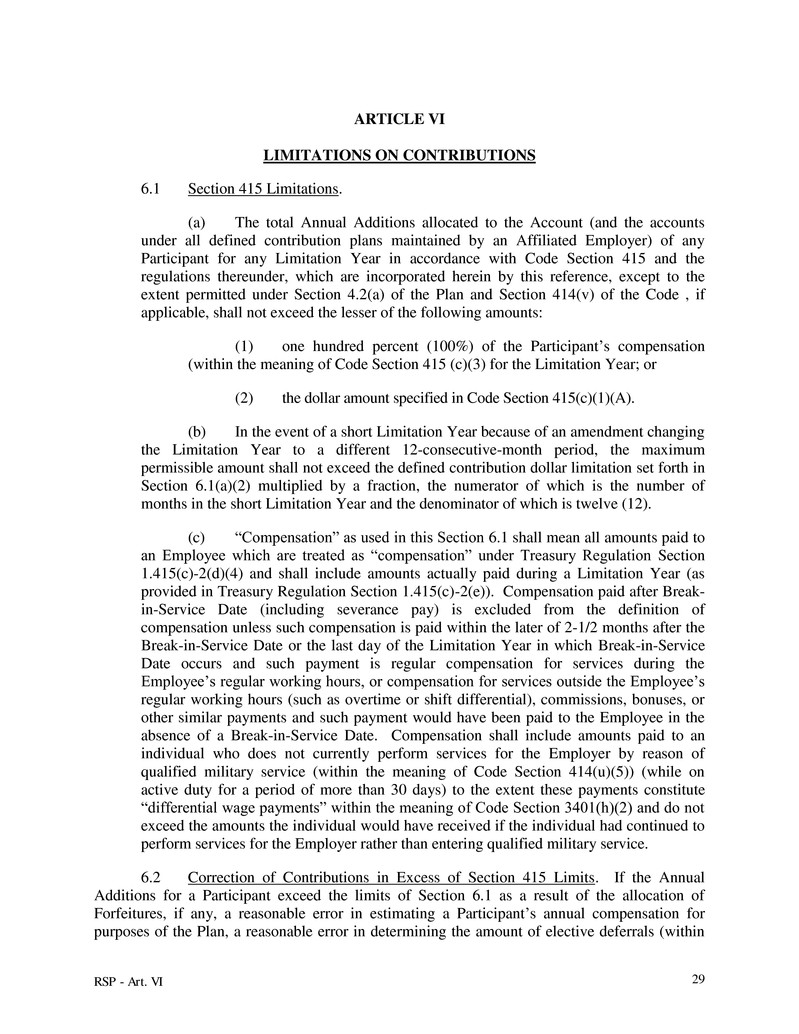
RSP - Art. VI 29 ARTICLE VI LIMITATIONS ON CONTRIBUTIONS 6.1 Section 415 Limitations. (a) The total Annual Additions allocated to the Account (and the accounts under all defined contribution plans maintained by an Affiliated Employer) of any Participant for any Limitation Year in accordance with Code Section 415 and the regulations thereunder, which are incorporated herein by this reference, except to the extent permitted under Section 4.2(a) of the Plan and Section 414(v) of the Code , if applicable, shall not exceed the lesser of the following amounts: (1) one hundred percent (100%) of the Participant’s compensation (within the meaning of Code Section 415 (c)(3) for the Limitation Year; or (2) the dollar amount specified in Code Section 415(c)(1)(A). (b) In the event of a short Limitation Year because of an amendment changing the Limitation Year to a different 12-consecutive-month period, the maximum permissible amount shall not exceed the defined contribution dollar limitation set forth in Section 6.1(a)(2) multiplied by a fraction, the numerator of which is the number of months in the short Limitation Year and the denominator of which is twelve (12). (c) “Compensation” as used in this Section 6.1 shall mean all amounts paid to an Employee which are treated as “compensation” under Treasury Regulation Section 1.415(c)-2(d)(4) and shall include amounts actually paid during a Limitation Year (as provided in Treasury Regulation Section 1.415(c)-2(e)). Compensation paid after Break- in-Service Date (including severance pay) is excluded from the definition of compensation unless such compensation is paid within the later of 2-1/2 months after the Break-in-Service Date or the last day of the Limitation Year in which Break-in-Service Date occurs and such payment is regular compensation for services during the Employee’s regular working hours, or compensation for services outside the Employee’s regular working hours (such as overtime or shift differential), commissions, bonuses, or other similar payments and such payment would have been paid to the Employee in the absence of a Break-in-Service Date. Compensation shall include amounts paid to an individual who does not currently perform services for the Employer by reason of qualified military service (within the meaning of Code Section 414(u)(5)) (while on active duty for a period of more than 30 days) to the extent these payments constitute “differential wage payments” within the meaning of Code Section 3401(h)(2) and do not exceed the amounts the individual would have received if the individual had continued to perform services for the Employer rather than entering qualified military service. 6.2 Correction of Contributions in Excess of Section 415 Limits. If the Annual Additions for a Participant exceed the limits of Section 6.1 as a result of the allocation of Forfeitures, if any, a reasonable error in estimating a Participant’s annual compensation for purposes of the Plan, a reasonable error in determining the amount of elective deferrals (within
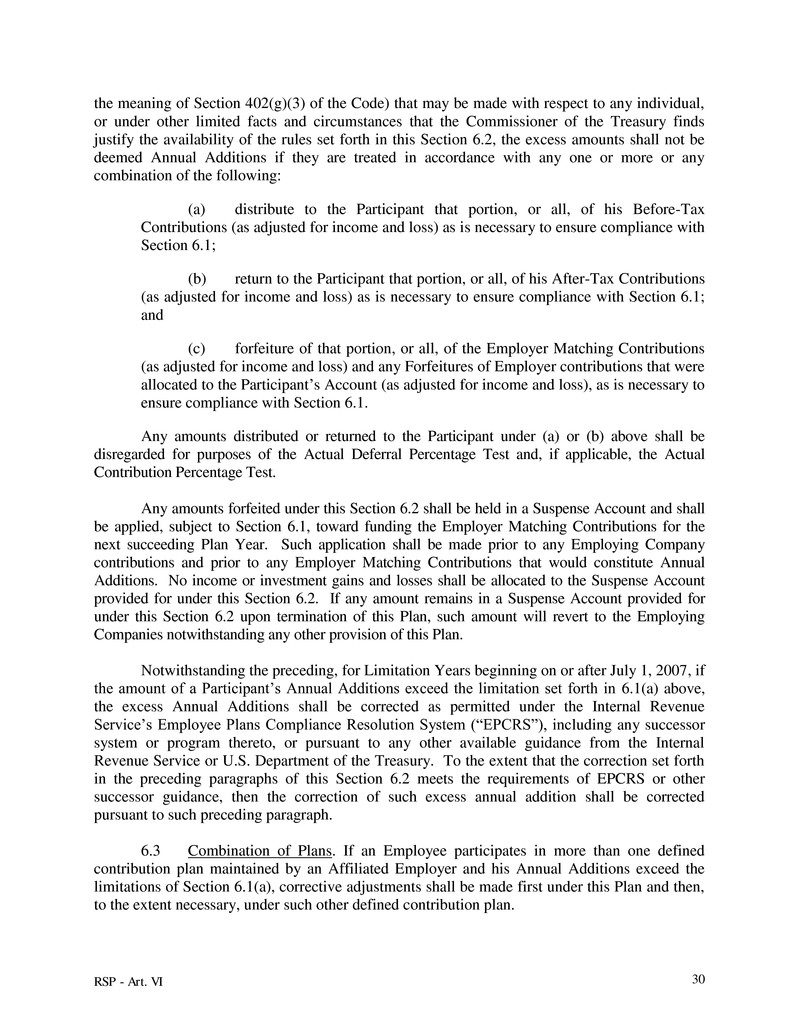
RSP - Art. VI 30 the meaning of Section 402(g)(3) of the Code) that may be made with respect to any individual, or under other limited facts and circumstances that the Commissioner of the Treasury finds justify the availability of the rules set forth in this Section 6.2, the excess amounts shall not be deemed Annual Additions if they are treated in accordance with any one or more or any combination of the following: (a) distribute to the Participant that portion, or all, of his Before-Tax Contributions (as adjusted for income and loss) as is necessary to ensure compliance with Section 6.1; (b) return to the Participant that portion, or all, of his After-Tax Contributions (as adjusted for income and loss) as is necessary to ensure compliance with Section 6.1; and (c) forfeiture of that portion, or all, of the Employer Matching Contributions (as adjusted for income and loss) and any Forfeitures of Employer contributions that were allocated to the Participant’s Account (as adjusted for income and loss), as is necessary to ensure compliance with Section 6.1. Any amounts distributed or returned to the Participant under (a) or (b) above shall be disregarded for purposes of the Actual Deferral Percentage Test and, if applicable, the Actual Contribution Percentage Test. Any amounts forfeited under this Section 6.2 shall be held in a Suspense Account and shall be applied, subject to Section 6.1, toward funding the Employer Matching Contributions for the next succeeding Plan Year. Such application shall be made prior to any Employing Company contributions and prior to any Employer Matching Contributions that would constitute Annual Additions. No income or investment gains and losses shall be allocated to the Suspense Account provided for under this Section 6.2. If any amount remains in a Suspense Account provided for under this Section 6.2 upon termination of this Plan, such amount will revert to the Employing Companies notwithstanding any other provision of this Plan. Notwithstanding the preceding, for Limitation Years beginning on or after July 1, 2007, if the amount of a Participant’s Annual Additions exceed the limitation set forth in 6.1(a) above, the excess Annual Additions shall be corrected as permitted under the Internal Revenue Service’s Employee Plans Compliance Resolution System (“EPCRS”), including any successor system or program thereto, or pursuant to any other available guidance from the Internal Revenue Service or U.S. Department of the Treasury. To the extent that the correction set forth in the preceding paragraphs of this Section 6.2 meets the requirements of EPCRS or other successor guidance, then the correction of such excess annual addition shall be corrected pursuant to such preceding paragraph. 6.3 Combination of Plans. If an Employee participates in more than one defined contribution plan maintained by an Affiliated Employer and his Annual Additions exceed the limitations of Section 6.1(a), corrective adjustments shall be made first under this Plan and then, to the extent necessary, under such other defined contribution plan.
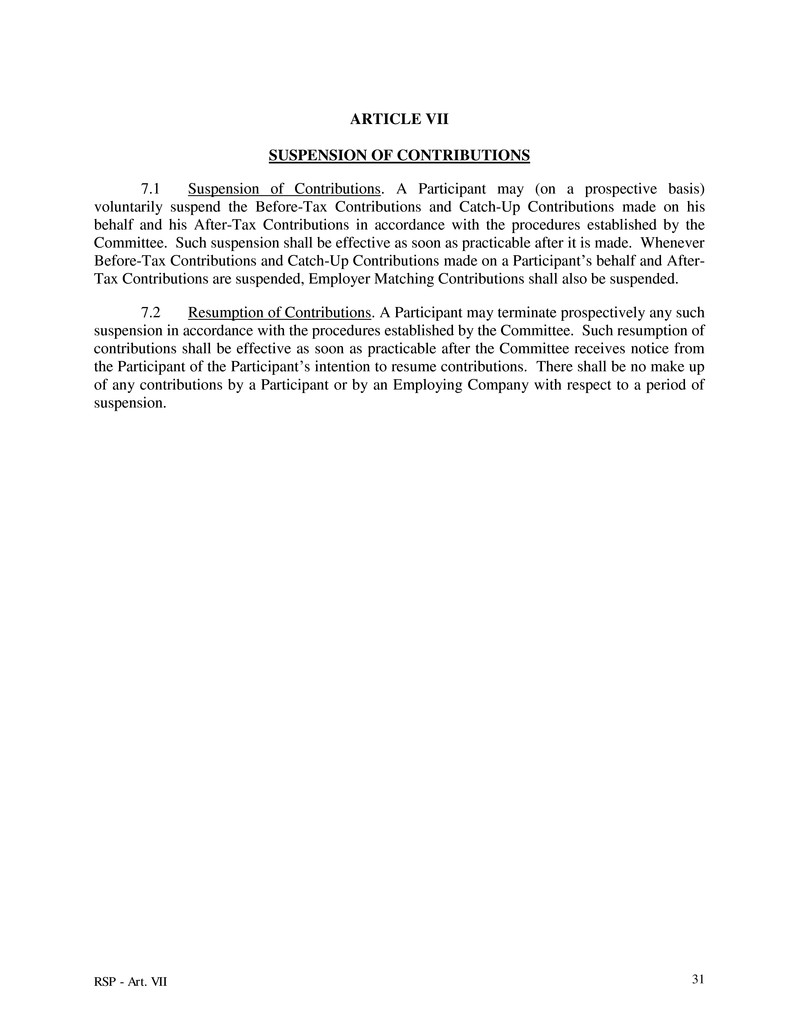
RSP - Art. VII 31 ARTICLE VII SUSPENSION OF CONTRIBUTIONS 7.1 Suspension of Contributions. A Participant may (on a prospective basis) voluntarily suspend the Before-Tax Contributions and Catch-Up Contributions made on his behalf and his After-Tax Contributions in accordance with the procedures established by the Committee. Such suspension shall be effective as soon as practicable after it is made. Whenever Before-Tax Contributions and Catch-Up Contributions made on a Participant’s behalf and After- Tax Contributions are suspended, Employer Matching Contributions shall also be suspended. 7.2 Resumption of Contributions. A Participant may terminate prospectively any such suspension in accordance with the procedures established by the Committee. Such resumption of contributions shall be effective as soon as practicable after the Committee receives notice from the Participant of the Participant’s intention to resume contributions. There shall be no make up of any contributions by a Participant or by an Employing Company with respect to a period of suspension.
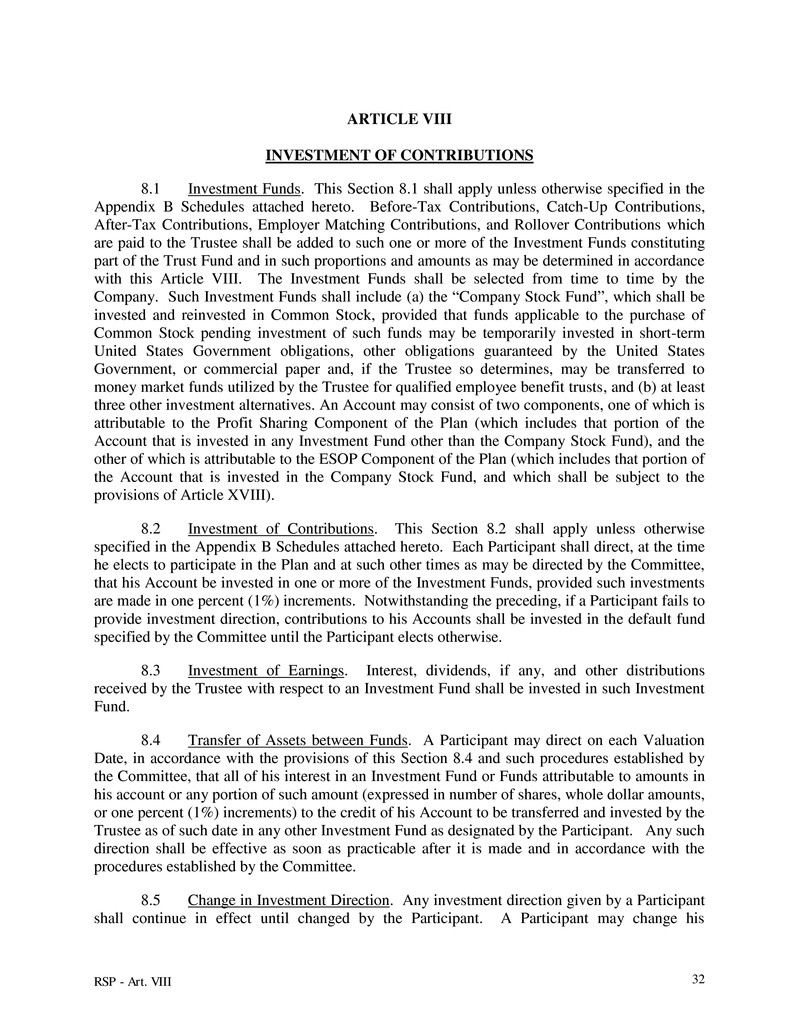
RSP - Art. VIII 32 ARTICLE VIII INVESTMENT OF CONTRIBUTIONS 8.1 Investment Funds. This Section 8.1 shall apply unless otherwise specified in the Appendix B Schedules attached hereto. Before-Tax Contributions, Catch-Up Contributions, After-Tax Contributions, Employer Matching Contributions, and Rollover Contributions which are paid to the Trustee shall be added to such one or more of the Investment Funds constituting part of the Trust Fund and in such proportions and amounts as may be determined in accordance with this Article VIII. The Investment Funds shall be selected from time to time by the Company. Such Investment Funds shall include (a) the “Company Stock Fund”, which shall be invested and reinvested in Common Stock, provided that funds applicable to the purchase of Common Stock pending investment of such funds may be temporarily invested in short-term United States Government obligations, other obligations guaranteed by the United States Government, or commercial paper and, if the Trustee so determines, may be transferred to money market funds utilized by the Trustee for qualified employee benefit trusts, and (b) at least three other investment alternatives. An Account may consist of two components, one of which is attributable to the Profit Sharing Component of the Plan (which includes that portion of the Account that is invested in any Investment Fund other than the Company Stock Fund), and the other of which is attributable to the ESOP Component of the Plan (which includes that portion of the Account that is invested in the Company Stock Fund, and which shall be subject to the provisions of Article XVIII). 8.2 Investment of Contributions. This Section 8.2 shall apply unless otherwise specified in the Appendix B Schedules attached hereto. Each Participant shall direct, at the time he elects to participate in the Plan and at such other times as may be directed by the Committee, that his Account be invested in one or more of the Investment Funds, provided such investments are made in one percent (1%) increments. Notwithstanding the preceding, if a Participant fails to provide investment direction, contributions to his Accounts shall be invested in the default fund specified by the Committee until the Participant elects otherwise. 8.3 Investment of Earnings. Interest, dividends, if any, and other distributions received by the Trustee with respect to an Investment Fund shall be invested in such Investment Fund. 8.4 Transfer of Assets between Funds. A Participant may direct on each Valuation Date, in accordance with the provisions of this Section 8.4 and such procedures established by the Committee, that all of his interest in an Investment Fund or Funds attributable to amounts in his account or any portion of such amount (expressed in number of shares, whole dollar amounts, or one percent (1%) increments) to the credit of his Account to be transferred and invested by the Trustee as of such date in any other Investment Fund as designated by the Participant. Any such direction shall be effective as soon as practicable after it is made and in accordance with the procedures established by the Committee. 8.5 Change in Investment Direction. Any investment direction given by a Participant shall continue in effect until changed by the Participant. A Participant may change his
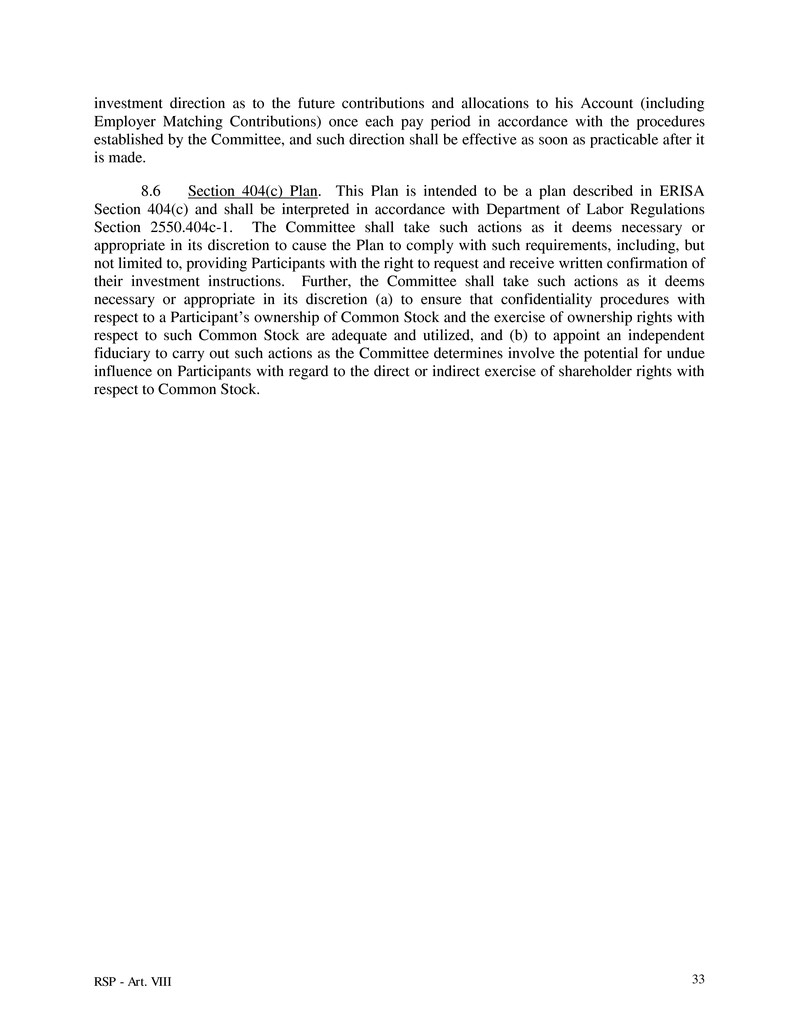
RSP - Art. VIII 33 investment direction as to the future contributions and allocations to his Account (including Employer Matching Contributions) once each pay period in accordance with the procedures established by the Committee, and such direction shall be effective as soon as practicable after it is made. 8.6 Section 404(c) Plan. This Plan is intended to be a plan described in ERISA Section 404(c) and shall be interpreted in accordance with Department of Labor Regulations Section 2550.404c-1. The Committee shall take such actions as it deems necessary or appropriate in its discretion to cause the Plan to comply with such requirements, including, but not limited to, providing Participants with the right to request and receive written confirmation of their investment instructions. Further, the Committee shall take such actions as it deems necessary or appropriate in its discretion (a) to ensure that confidentiality procedures with respect to a Participant’s ownership of Common Stock and the exercise of ownership rights with respect to such Common Stock are adequate and utilized, and (b) to appoint an independent fiduciary to carry out such actions as the Committee determines involve the potential for undue influence on Participants with regard to the direct or indirect exercise of shareholder rights with respect to Common Stock.
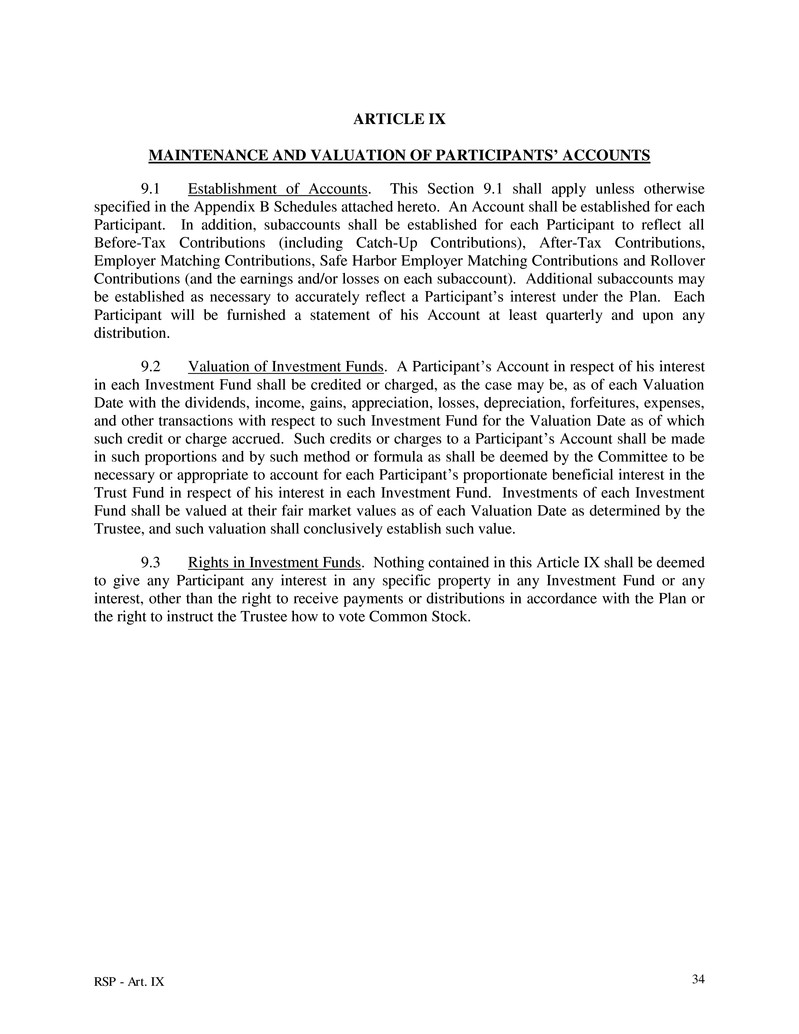
RSP - Art. IX 34 ARTICLE IX MAINTENANCE AND VALUATION OF PARTICIPANTS’ ACCOUNTS 9.1 Establishment of Accounts. This Section 9.1 shall apply unless otherwise specified in the Appendix B Schedules attached hereto. An Account shall be established for each Participant. In addition, subaccounts shall be established for each Participant to reflect all Before-Tax Contributions (including Catch-Up Contributions), After-Tax Contributions, Employer Matching Contributions, Safe Harbor Employer Matching Contributions and Rollover Contributions (and the earnings and/or losses on each subaccount). Additional subaccounts may be established as necessary to accurately reflect a Participant’s interest under the Plan. Each Participant will be furnished a statement of his Account at least quarterly and upon any distribution. 9.2 Valuation of Investment Funds. A Participant’s Account in respect of his interest in each Investment Fund shall be credited or charged, as the case may be, as of each Valuation Date with the dividends, income, gains, appreciation, losses, depreciation, forfeitures, expenses, and other transactions with respect to such Investment Fund for the Valuation Date as of which such credit or charge accrued. Such credits or charges to a Participant’s Account shall be made in such proportions and by such method or formula as shall be deemed by the Committee to be necessary or appropriate to account for each Participant’s proportionate beneficial interest in the Trust Fund in respect of his interest in each Investment Fund. Investments of each Investment Fund shall be valued at their fair market values as of each Valuation Date as determined by the Trustee, and such valuation shall conclusively establish such value. 9.3 Rights in Investment Funds. Nothing contained in this Article IX shall be deemed to give any Participant any interest in any specific property in any Investment Fund or any interest, other than the right to receive payments or distributions in accordance with the Plan or the right to instruct the Trustee how to vote Common Stock.
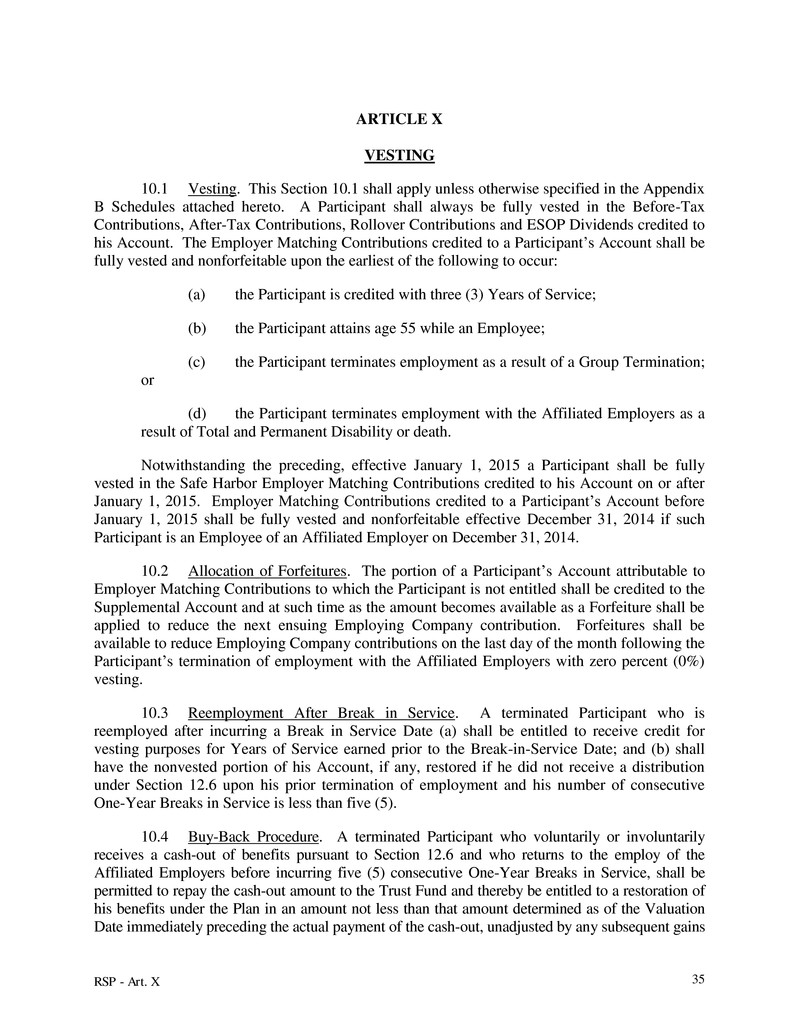
RSP - Art. X 35 ARTICLE X VESTING 10.1 Vesting. This Section 10.1 shall apply unless otherwise specified in the Appendix B Schedules attached hereto. A Participant shall always be fully vested in the Before-Tax Contributions, After-Tax Contributions, Rollover Contributions and ESOP Dividends credited to his Account. The Employer Matching Contributions credited to a Participant’s Account shall be fully vested and nonforfeitable upon the earliest of the following to occur: (a) the Participant is credited with three (3) Years of Service; (b) the Participant attains age 55 while an Employee; (c) the Participant terminates employment as a result of a Group Termination; or (d) the Participant terminates employment with the Affiliated Employers as a result of Total and Permanent Disability or death. Notwithstanding the preceding, effective January 1, 2015 a Participant shall be fully vested in the Safe Harbor Employer Matching Contributions credited to his Account on or after January 1, 2015. Employer Matching Contributions credited to a Participant’s Account before January 1, 2015 shall be fully vested and nonforfeitable effective December 31, 2014 if such Participant is an Employee of an Affiliated Employer on December 31, 2014. 10.2 Allocation of Forfeitures. The portion of a Participant’s Account attributable to Employer Matching Contributions to which the Participant is not entitled shall be credited to the Supplemental Account and at such time as the amount becomes available as a Forfeiture shall be applied to reduce the next ensuing Employing Company contribution. Forfeitures shall be available to reduce Employing Company contributions on the last day of the month following the Participant’s termination of employment with the Affiliated Employers with zero percent (0%) vesting. 10.3 Reemployment After Break in Service. A terminated Participant who is reemployed after incurring a Break in Service Date (a) shall be entitled to receive credit for vesting purposes for Years of Service earned prior to the Break-in-Service Date; and (b) shall have the nonvested portion of his Account, if any, restored if he did not receive a distribution under Section 12.6 upon his prior termination of employment and his number of consecutive One-Year Breaks in Service is less than five (5). 10.4 Buy-Back Procedure. A terminated Participant who voluntarily or involuntarily receives a cash-out of benefits pursuant to Section 12.6 and who returns to the employ of the Affiliated Employers before incurring five (5) consecutive One-Year Breaks in Service, shall be permitted to repay the cash-out amount to the Trust Fund and thereby be entitled to a restoration of his benefits under the Plan in an amount not less than that amount determined as of the Valuation Date immediately preceding the actual payment of the cash-out, unadjusted by any subsequent gains

RSP - Art. X 36 or losses. The Participant must repay the full amount distributed to him within five (5) years from the first date on which the Participant is subsequently reemployed by the Affiliated Employers. The recontributed amounts shall be invested in accordance with the Participant’s current investment election under Section 8.2. Restoration of accrued benefits to which an Employee is entitled under this Section shall be made by the end of the Plan Year following the Plan Year in which the restoration occurs, as deemed necessary and proper by the Committee.
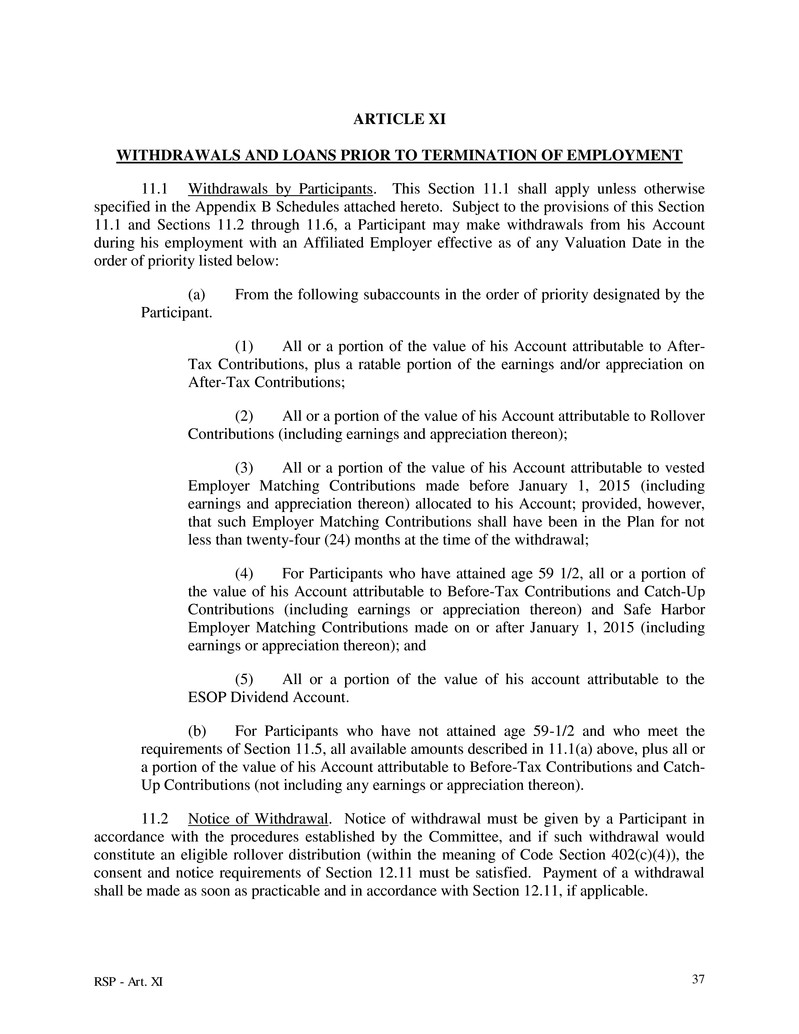
RSP - Art. XI 37 ARTICLE XI WITHDRAWALS AND LOANS PRIOR TO TERMINATION OF EMPLOYMENT 11.1 Withdrawals by Participants. This Section 11.1 shall apply unless otherwise specified in the Appendix B Schedules attached hereto. Subject to the provisions of this Section 11.1 and Sections 11.2 through 11.6, a Participant may make withdrawals from his Account during his employment with an Affiliated Employer effective as of any Valuation Date in the order of priority listed below: (a) From the following subaccounts in the order of priority designated by the Participant. (1) All or a portion of the value of his Account attributable to After- Tax Contributions, plus a ratable portion of the earnings and/or appreciation on After-Tax Contributions; (2) All or a portion of the value of his Account attributable to Rollover Contributions (including earnings and appreciation thereon); (3) All or a portion of the value of his Account attributable to vested Employer Matching Contributions made before January 1, 2015 (including earnings and appreciation thereon) allocated to his Account; provided, however, that such Employer Matching Contributions shall have been in the Plan for not less than twenty-four (24) months at the time of the withdrawal; (4) For Participants who have attained age 59 1/2, all or a portion of the value of his Account attributable to Before-Tax Contributions and Catch-Up Contributions (including earnings or appreciation thereon) and Safe Harbor Employer Matching Contributions made on or after January 1, 2015 (including earnings or appreciation thereon); and (5) All or a portion of the value of his account attributable to the ESOP Dividend Account. (b) For Participants who have not attained age 59-1/2 and who meet the requirements of Section 11.5, all available amounts described in 11.1(a) above, plus all or a portion of the value of his Account attributable to Before-Tax Contributions and Catch- Up Contributions (not including any earnings or appreciation thereon). 11.2 Notice of Withdrawal. Notice of withdrawal must be given by a Participant in accordance with the procedures established by the Committee, and if such withdrawal would constitute an eligible rollover distribution (within the meaning of Code Section 402(c)(4)), the consent and notice requirements of Section 12.11 must be satisfied. Payment of a withdrawal shall be made as soon as practicable and in accordance with Section 12.11, if applicable.

RSP - Art. XI 38 11.3 Form of Withdrawal. All distributions under this Article XI shall be made in the form of cash, provided that the person entitled to such distribution (other than a hardship distribution described in Section 11.5) may request that all or any portion of the distribution from the Company Stock Fund be distributed in the form of Common Stock, with a cash adjustment for any fractional shares. Such request must be made in accordance with such procedures as may be established by the Committee. Notwithstanding the foregoing, in no event shall distributions on account of hardship under Section 11.5 be made in the form of Common Stock. 11.4 Source of Withdrawal. Withdrawals shall be made on a pro rata basis from each of the Investment Funds in which the amount to be distributed is invested. 11.5 Requirement of Hardship. (a) A withdrawal pursuant to Section 11.1(b), in addition to the other requirements of Article XI, shall be permitted only if the Committee determines that the withdrawal is to be made on account of an immediate and heavy financial need of the Participant, the amount of the withdrawal does not exceed such financial need, and the amount of the withdrawal is not reasonably available from other resources of the Participant. (b) For purposes of this Section 11.5, the following shall be deemed to be immediate and heavy financial needs: (1) expenses for (or necessary to obtain) medical care that would be deductible under Section 213(d) of the Code (determined without regard to whether the expenses exceed 7.5% of gross income) for the Participant, the Participant’s spouse, child or Dependent; (2) costs directly related to the purchase (excluding mortgage payments) of a principal residence for the Participant; (3) payment of tuition, related educational fees, and room and board expenses, for the next twelve (12) months of post-secondary education for the Participant, the Participant’s spouse or child or Dependent; (4) payments necessary to prevent eviction of the Participant from his principal residence or foreclosure on the mortgage of the Participant’s principal residence; (5) payment of burial or funeral expenses for the Participant’s deceased parent, spouse or child or Dependent; (6) payment of expenses for the repair of damage to the Participant’s principal residence that would qualify for the casualty loss deduction under Section 165 of the Code (determined without regard to whether the loss exceeds 10% of adjusted gross income); or
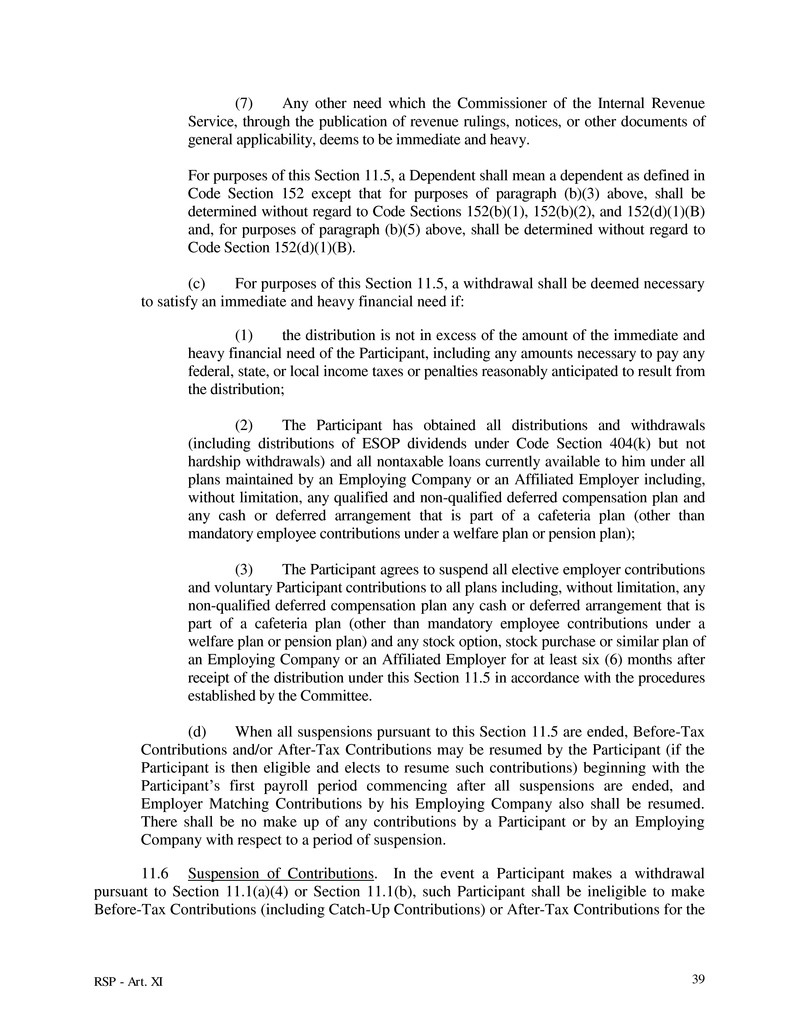
RSP - Art. XI 39 (7) Any other need which the Commissioner of the Internal Revenue Service, through the publication of revenue rulings, notices, or other documents of general applicability, deems to be immediate and heavy. For purposes of this Section 11.5, a Dependent shall mean a dependent as defined in Code Section 152 except that for purposes of paragraph (b)(3) above, shall be determined without regard to Code Sections 152(b)(1), 152(b)(2), and 152(d)(1)(B) and, for purposes of paragraph (b)(5) above, shall be determined without regard to Code Section 152(d)(1)(B). (c) For purposes of this Section 11.5, a withdrawal shall be deemed necessary to satisfy an immediate and heavy financial need if: (1) the distribution is not in excess of the amount of the immediate and heavy financial need of the Participant, including any amounts necessary to pay any federal, state, or local income taxes or penalties reasonably anticipated to result from the distribution; (2) The Participant has obtained all distributions and withdrawals (including distributions of ESOP dividends under Code Section 404(k) but not hardship withdrawals) and all nontaxable loans currently available to him under all plans maintained by an Employing Company or an Affiliated Employer including, without limitation, any qualified and non-qualified deferred compensation plan and any cash or deferred arrangement that is part of a cafeteria plan (other than mandatory employee contributions under a welfare plan or pension plan); (3) The Participant agrees to suspend all elective employer contributions and voluntary Participant contributions to all plans including, without limitation, any non-qualified deferred compensation plan any cash or deferred arrangement that is part of a cafeteria plan (other than mandatory employee contributions under a welfare plan or pension plan) and any stock option, stock purchase or similar plan of an Employing Company or an Affiliated Employer for at least six (6) months after receipt of the distribution under this Section 11.5 in accordance with the procedures established by the Committee. (d) When all suspensions pursuant to this Section 11.5 are ended, Before-Tax Contributions and/or After-Tax Contributions may be resumed by the Participant (if the Participant is then eligible and elects to resume such contributions) beginning with the Participant’s first payroll period commencing after all suspensions are ended, and Employer Matching Contributions by his Employing Company also shall be resumed. There shall be no make up of any contributions by a Participant or by an Employing Company with respect to a period of suspension. 11.6 Suspension of Contributions. In the event a Participant makes a withdrawal pursuant to Section 11.1(a)(4) or Section 11.1(b), such Participant shall be ineligible to make Before-Tax Contributions (including Catch-Up Contributions) or After-Tax Contributions for the

RSP - Art. XI 40 six-month period following the date of such withdrawal in accordance with the procedures established by the Committee. 11.7 Loans. Effective January 1, 2015, a Participant may request a loan from his Account by filing a request in accordance with procedures established by the Committee for such purpose. The Committee shall adopt such rules as it may deem necessary or appropriate to implement the provisions of this Section. (a) Funding of a Loan; Loan Accounts. Upon the approval of a loan request, the loan amount will be withdrawn from, and shall reduce, the Participant’s Account on a pro rata basis from among all sources and funds, except for such restricted investments as the Company Stock Fund and the NIPA insurance fund described in Appendix A to Schedule 4. (b) Frequency of Loans. A Participant is restricted to initiating only one loan in a 12-month period and may have only one loan outstanding at any time. (c) Loan Amount. The minimum loan amount shall be $1,000. The maximum amount of a loan shall not exceed the lesser of: (1) $50,000 reduced by the highest outstanding balance of loans during the one-year period ending on the day before the date the loan is made, or (2) 50% of the nonforfeitable amount of the Participant’s or Beneficiary’s entire balance under all Accounts. (d) Term of a Loan. The term of a loan shall be designated by the Participant but shall not exceed (5) five years. The term of a loan shall expire as of the Participant’s Break-In-Service Date. (e) Interest. A loan shall bear a reasonable rate of interest as determined as the current prime lending rate at Wells Fargo Bank, unless otherwise set forth in Loan Procedures established by the Committee. The interest rate shall be fixed for the entire term of the loan. (f) Payments. Repayment of the loan principal and payment of the interest thereon shall be made by approximately equal payments that will permit the loan to be fully amortized over the term selected by the Participant pursuant to subsection (d). Subject to Treasury regulations and Committee rules, the preceding sentence shall not be applicable with respect to a period when a Participant is on a leave of absence without Compensation for up to one year. Required payments shall be made by payroll deductions in each payroll period. If a Participant’s Compensation is insufficient to make such payments in full, the amount of the deficiency shall be paid by personal check (not less frequently than each quarter). A prepayment of the entire remaining balance of the loan and accrued interest may be made by personal check at any time without penalty. Loan repayments shall be invested in accordance with the Participant’s current investment direction pursuant to Section 8.2.

RSP - Art. XI 41 (g) Promissory Note. A loan shall be evidenced by a promissory note in such form and containing such terms as the Committee shall direct, subject to the provisions of this section. (h) Security and Default. A Participant’s obligation to repay a loan and interest thereon shall be secured by his Account. If a Participant fails to make a required payment and the Committee determines that the loan is in default, the unpaid balance of the loan and accrued interest shall be deducted from the Participant’s Account until the total amount of the unpaid balance and accrued interest has been reached. The promissory note shall then be canceled. The amount deducted from the Participant’s Account shall be treated as a distribution to the Participant. Notwithstanding the preceding, no deduction shall be made with respect to the Participant’s Accounts until an event occurs which would entitle the Participant to a distribution from such Accounts.
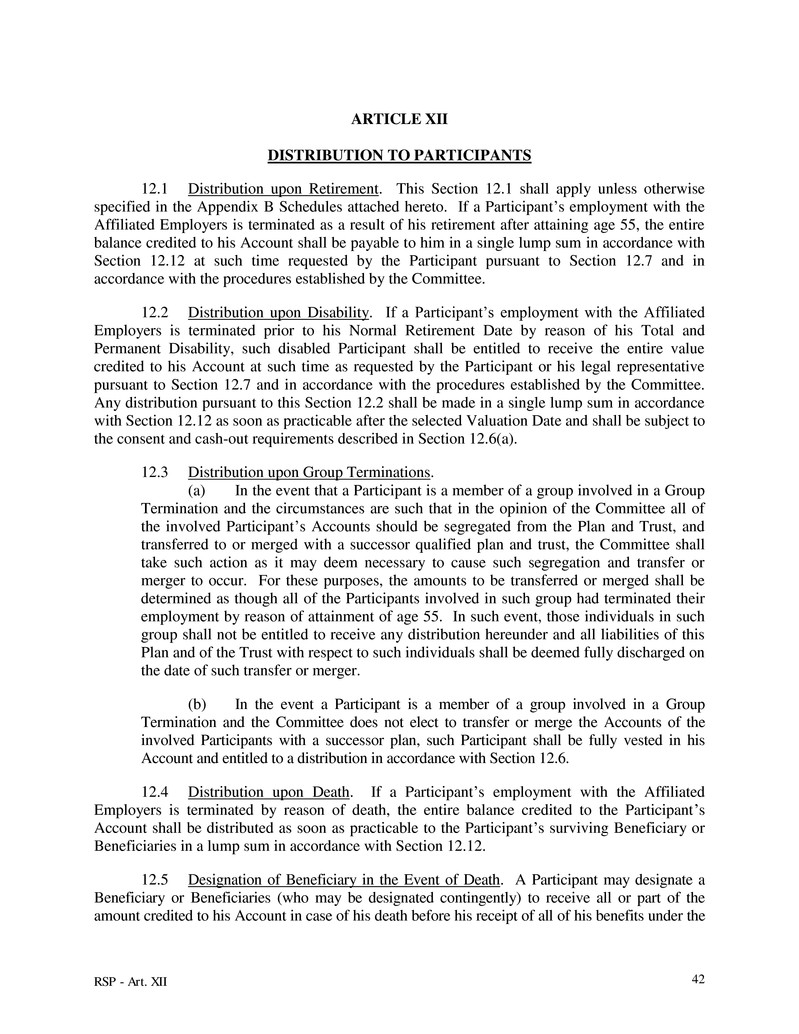
RSP - Art. XII 42 ARTICLE XII DISTRIBUTION TO PARTICIPANTS 12.1 Distribution upon Retirement. This Section 12.1 shall apply unless otherwise specified in the Appendix B Schedules attached hereto. If a Participant’s employment with the Affiliated Employers is terminated as a result of his retirement after attaining age 55, the entire balance credited to his Account shall be payable to him in a single lump sum in accordance with Section 12.12 at such time requested by the Participant pursuant to Section 12.7 and in accordance with the procedures established by the Committee. 12.2 Distribution upon Disability. If a Participant’s employment with the Affiliated Employers is terminated prior to his Normal Retirement Date by reason of his Total and Permanent Disability, such disabled Participant shall be entitled to receive the entire value credited to his Account at such time as requested by the Participant or his legal representative pursuant to Section 12.7 and in accordance with the procedures established by the Committee. Any distribution pursuant to this Section 12.2 shall be made in a single lump sum in accordance with Section 12.12 as soon as practicable after the selected Valuation Date and shall be subject to the consent and cash-out requirements described in Section 12.6(a). 12.3 Distribution upon Group Terminations. (a) In the event that a Participant is a member of a group involved in a Group Termination and the circumstances are such that in the opinion of the Committee all of the involved Participant’s Accounts should be segregated from the Plan and Trust, and transferred to or merged with a successor qualified plan and trust, the Committee shall take such action as it may deem necessary to cause such segregation and transfer or merger to occur. For these purposes, the amounts to be transferred or merged shall be determined as though all of the Participants involved in such group had terminated their employment by reason of attainment of age 55. In such event, those individuals in such group shall not be entitled to receive any distribution hereunder and all liabilities of this Plan and of the Trust with respect to such individuals shall be deemed fully discharged on the date of such transfer or merger. (b) In the event a Participant is a member of a group involved in a Group Termination and the Committee does not elect to transfer or merge the Accounts of the involved Participants with a successor plan, such Participant shall be fully vested in his Account and entitled to a distribution in accordance with Section 12.6. 12.4 Distribution upon Death. If a Participant’s employment with the Affiliated Employers is terminated by reason of death, the entire balance credited to the Participant’s Account shall be distributed as soon as practicable to the Participant’s surviving Beneficiary or Beneficiaries in a lump sum in accordance with Section 12.12. 12.5 Designation of Beneficiary in the Event of Death. A Participant may designate a Beneficiary or Beneficiaries (who may be designated contingently) to receive all or part of the amount credited to his Account in case of his death before his receipt of all of his benefits under the
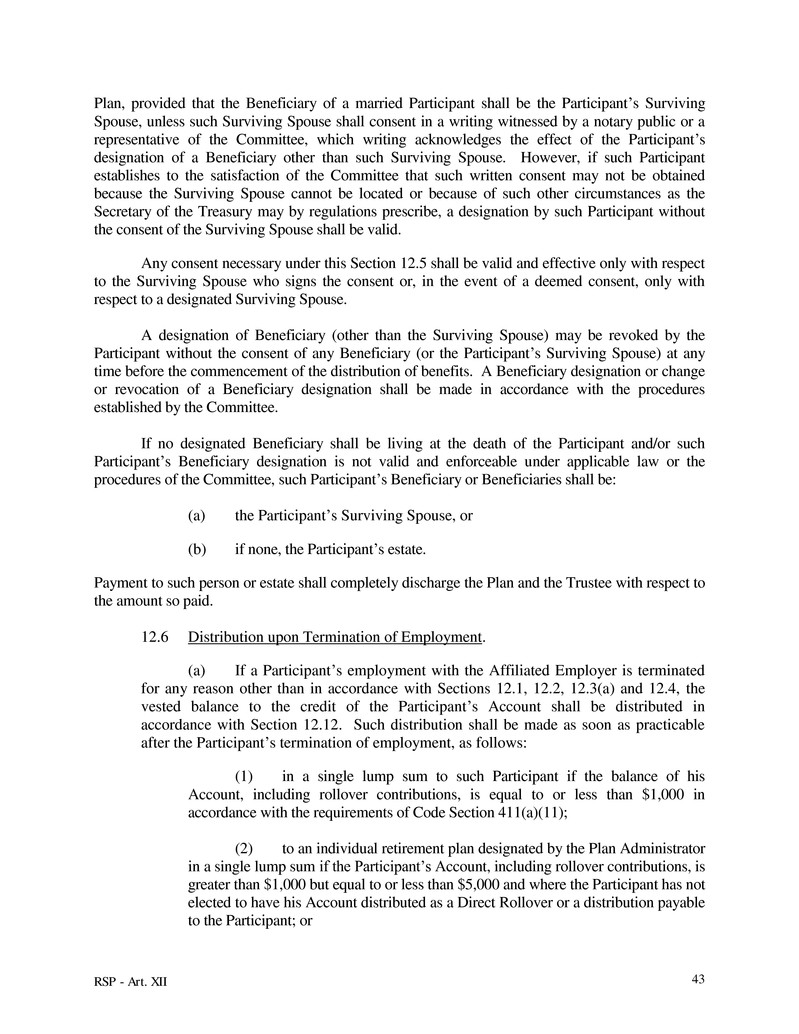
RSP - Art. XII 43 Plan, provided that the Beneficiary of a married Participant shall be the Participant’s Surviving Spouse, unless such Surviving Spouse shall consent in a writing witnessed by a notary public or a representative of the Committee, which writing acknowledges the effect of the Participant’s designation of a Beneficiary other than such Surviving Spouse. However, if such Participant establishes to the satisfaction of the Committee that such written consent may not be obtained because the Surviving Spouse cannot be located or because of such other circumstances as the Secretary of the Treasury may by regulations prescribe, a designation by such Participant without the consent of the Surviving Spouse shall be valid. Any consent necessary under this Section 12.5 shall be valid and effective only with respect to the Surviving Spouse who signs the consent or, in the event of a deemed consent, only with respect to a designated Surviving Spouse. A designation of Beneficiary (other than the Surviving Spouse) may be revoked by the Participant without the consent of any Beneficiary (or the Participant’s Surviving Spouse) at any time before the commencement of the distribution of benefits. A Beneficiary designation or change or revocation of a Beneficiary designation shall be made in accordance with the procedures established by the Committee. If no designated Beneficiary shall be living at the death of the Participant and/or such Participant’s Beneficiary designation is not valid and enforceable under applicable law or the procedures of the Committee, such Participant’s Beneficiary or Beneficiaries shall be: (a) the Participant’s Surviving Spouse, or (b) if none, the Participant’s estate. Payment to such person or estate shall completely discharge the Plan and the Trustee with respect to the amount so paid. 12.6 Distribution upon Termination of Employment. (a) If a Participant’s employment with the Affiliated Employer is terminated for any reason other than in accordance with Sections 12.1, 12.2, 12.3(a) and 12.4, the vested balance to the credit of the Participant’s Account shall be distributed in accordance with Section 12.12. Such distribution shall be made as soon as practicable after the Participant’s termination of employment, as follows: (1) in a single lump sum to such Participant if the balance of his Account, including rollover contributions, is equal to or less than $1,000 in accordance with the requirements of Code Section 411(a)(11); (2) to an individual retirement plan designated by the Plan Administrator in a single lump sum if the Participant’s Account, including rollover contributions, is greater than $1,000 but equal to or less than $5,000 and where the Participant has not elected to have his Account distributed as a Direct Rollover or a distribution payable to the Participant; or

RSP - Art. XII 44 (3) in accordance with Section 12.11, if the Participant elects to receive a distribution of the vested portion of his Account. The Committee shall not have a distribution to any Participant whose Account balance exceeds $5,000 without the written consent of the Participant. (b) A Participant who does not receive a distribution under Section 12.6(a)(1) or (2) may elect to defer the commencement of the distribution of his Account following the termination of his employment until a later Valuation Date, provided that such distribution shall commence not later than the date required under Section 12.7 of the Plan. Any deferred distribution shall commence as soon as practicable after the Valuation Date selected by the Participant. If a Participant receives a distribution under this subsection at any time when he is zero percent (0%) vested in any portion of his Account (including the portion of the Account attributable to Before-Tax Contributions under Section 4.1), such Participant shall be deemed to have received an immediate distribution of the entire nonvested portion of his Account and shall cease to be a Participant hereunder. Absent a buy-back by the Participant under Section 10.4, the actual payment of benefits under this Section 12.6 shall satisfy all obligations of the Trust to such Participant. 12.7 Commencement of Benefits. (a) Notwithstanding any other provision of the Plan, and except as further provided in Section 12.7(b) below, if the Participant does not elect to defer commencement of his benefit payments, the payment of his benefits shall begin at the Participant’s election no later than the sixtieth (60th) day after the close of the Plan Year in which the latest of the following events occurs: (1) the Participant attains the earlier of age 65 or his Normal Retirement Date, (2) the Participant’s tenth (10th) anniversary of participation under the Plan, or (3) the Participant’s separation from service with the Affiliated Employers. (b) In no event shall the distribution of amounts in a Participant’s Account commence later than the April 1 of the calendar year following the calendar year in which the Participant attains age 70-1/2, in accordance with regulations prescribed by the Secretary of the Treasury.
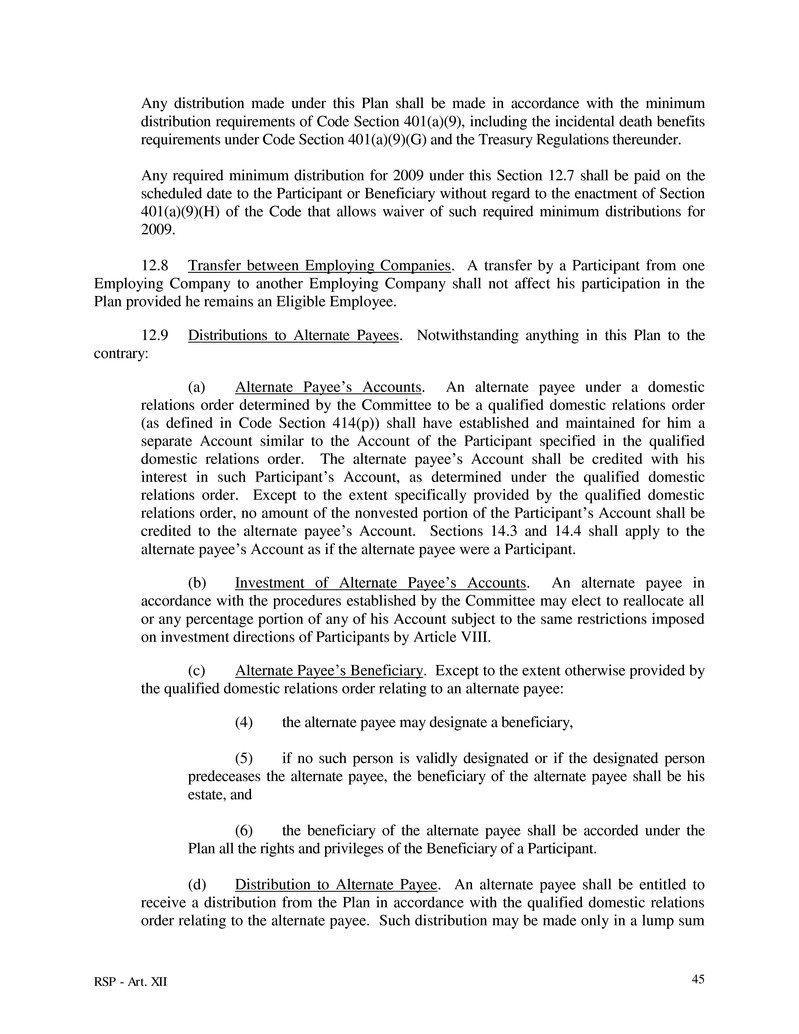
RSP - Art. XII 45 Any distribution made under this Plan shall be made in accordance with the minimum distribution requirements of Code Section 401(a)(9), including the incidental death benefits requirements under Code Section 401(a)(9)(G) and the Treasury Regulations thereunder. Any required minimum distribution for 2009 under this Section 12.7 shall be paid on the scheduled date to the Participant or Beneficiary without regard to the enactment of Section 401(a)(9)(H) of the Code that allows waiver of such required minimum distributions for 2009. 12.8 Transfer between Employing Companies. A transfer by a Participant from one Employing Company to another Employing Company shall not affect his participation in the Plan provided he remains an Eligible Employee. 12.9 Distributions to Alternate Payees. Notwithstanding anything in this Plan to the contrary: (a) Alternate Payee’s Accounts. An alternate payee under a domestic relations order determined by the Committee to be a qualified domestic relations order (as defined in Code Section 414(p)) shall have established and maintained for him a separate Account similar to the Account of the Participant specified in the qualified domestic relations order. The alternate payee’s Account shall be credited with his interest in such Participant’s Account, as determined under the qualified domestic relations order. Except to the extent specifically provided by the qualified domestic relations order, no amount of the nonvested portion of the Participant’s Account shall be credited to the alternate payee’s Account. Sections 14.3 and 14.4 shall apply to the alternate payee’s Account as if the alternate payee were a Participant. (b) Investment of Alternate Payee’s Accounts. An alternate payee in accordance with the procedures established by the Committee may elect to reallocate all or any percentage portion of any of his Account subject to the same restrictions imposed on investment directions of Participants by Article VIII. (c) Alternate Payee’s Beneficiary. Except to the extent otherwise provided by the qualified domestic relations order relating to an alternate payee: (4) the alternate payee may designate a beneficiary, (5) if no such person is validly designated or if the designated person predeceases the alternate payee, the beneficiary of the alternate payee shall be his estate, and (6) the beneficiary of the alternate payee shall be accorded under the Plan all the rights and privileges of the Beneficiary of a Participant. (d) Distribution to Alternate Payee. An alternate payee shall be entitled to receive a distribution from the Plan in accordance with the qualified domestic relations order relating to the alternate payee. Such distribution may be made only in a lump sum
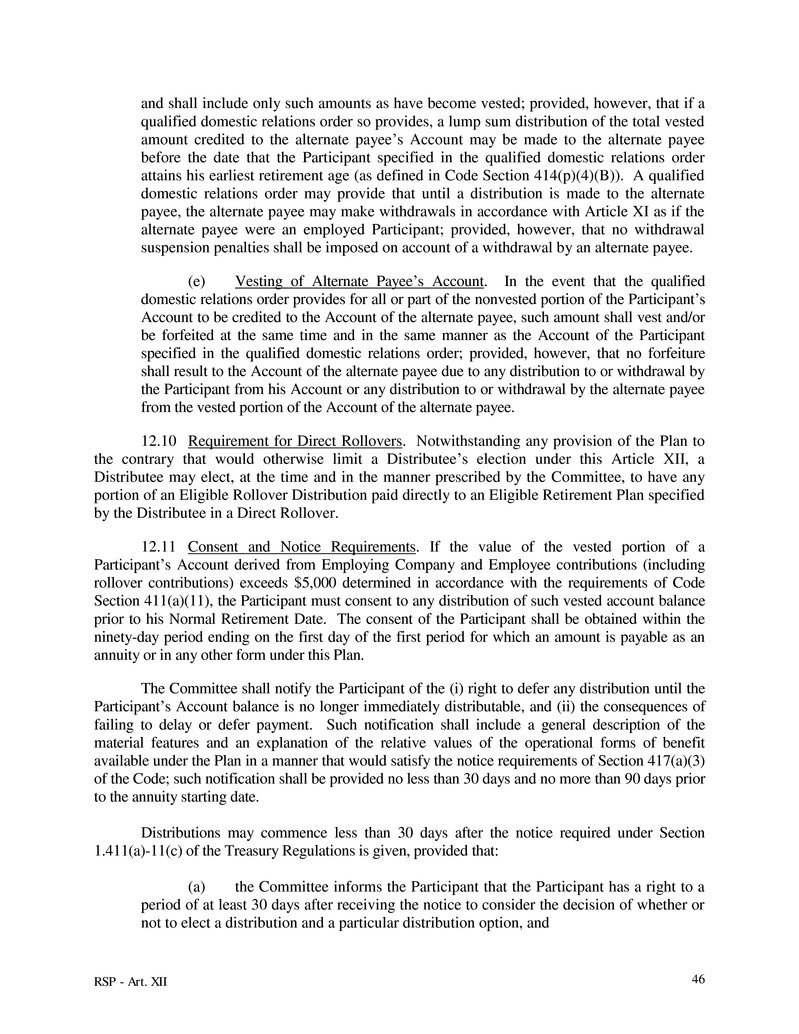
RSP - Art. XII 46 and shall include only such amounts as have become vested; provided, however, that if a qualified domestic relations order so provides, a lump sum distribution of the total vested amount credited to the alternate payee’s Account may be made to the alternate payee before the date that the Participant specified in the qualified domestic relations order attains his earliest retirement age (as defined in Code Section 414(p)(4)(B)). A qualified domestic relations order may provide that until a distribution is made to the alternate payee, the alternate payee may make withdrawals in accordance with Article XI as if the alternate payee were an employed Participant; provided, however, that no withdrawal suspension penalties shall be imposed on account of a withdrawal by an alternate payee. (e) Vesting of Alternate Payee’s Account. In the event that the qualified domestic relations order provides for all or part of the nonvested portion of the Participant’s Account to be credited to the Account of the alternate payee, such amount shall vest and/or be forfeited at the same time and in the same manner as the Account of the Participant specified in the qualified domestic relations order; provided, however, that no forfeiture shall result to the Account of the alternate payee due to any distribution to or withdrawal by the Participant from his Account or any distribution to or withdrawal by the alternate payee from the vested portion of the Account of the alternate payee. 12.10 Requirement for Direct Rollovers. Notwithstanding any provision of the Plan to the contrary that would otherwise limit a Distributee’s election under this Article XII, a Distributee may elect, at the time and in the manner prescribed by the Committee, to have any portion of an Eligible Rollover Distribution paid directly to an Eligible Retirement Plan specified by the Distributee in a Direct Rollover. 12.11 Consent and Notice Requirements. If the value of the vested portion of a Participant’s Account derived from Employing Company and Employee contributions (including rollover contributions) exceeds $5,000 determined in accordance with the requirements of Code Section 411(a)(11), the Participant must consent to any distribution of such vested account balance prior to his Normal Retirement Date. The consent of the Participant shall be obtained within the ninety-day period ending on the first day of the first period for which an amount is payable as an annuity or in any other form under this Plan. The Committee shall notify the Participant of the (i) right to defer any distribution until the Participant’s Account balance is no longer immediately distributable, and (ii) the consequences of failing to delay or defer payment. Such notification shall include a general description of the material features and an explanation of the relative values of the operational forms of benefit available under the Plan in a manner that would satisfy the notice requirements of Section 417(a)(3) of the Code; such notification shall be provided no less than 30 days and no more than 90 days prior to the annuity starting date. Distributions may commence less than 30 days after the notice required under Section 1.411(a)-11(c) of the Treasury Regulations is given, provided that: (a) the Committee informs the Participant that the Participant has a right to a period of at least 30 days after receiving the notice to consider the decision of whether or not to elect a distribution and a particular distribution option, and

RSP - Art. XII 47 (b) the Participant, after receiving the notice, affirmatively elects a distribution. 12.12 Form of Payment. All distributions under this Article XII shall be made in the form of cash, provided that the person entitled to such distribution may request that all or a portion of any distribution from the Company Stock Fund be distributed in the form of Common Stock, with a cash adjustment for any fractional shares. Such request must be made in accordance with the procedures established by the Committee. Alternatively, the Participant may direct that the distribution be made in a single lump sum to an Eligible Retirement Plan.
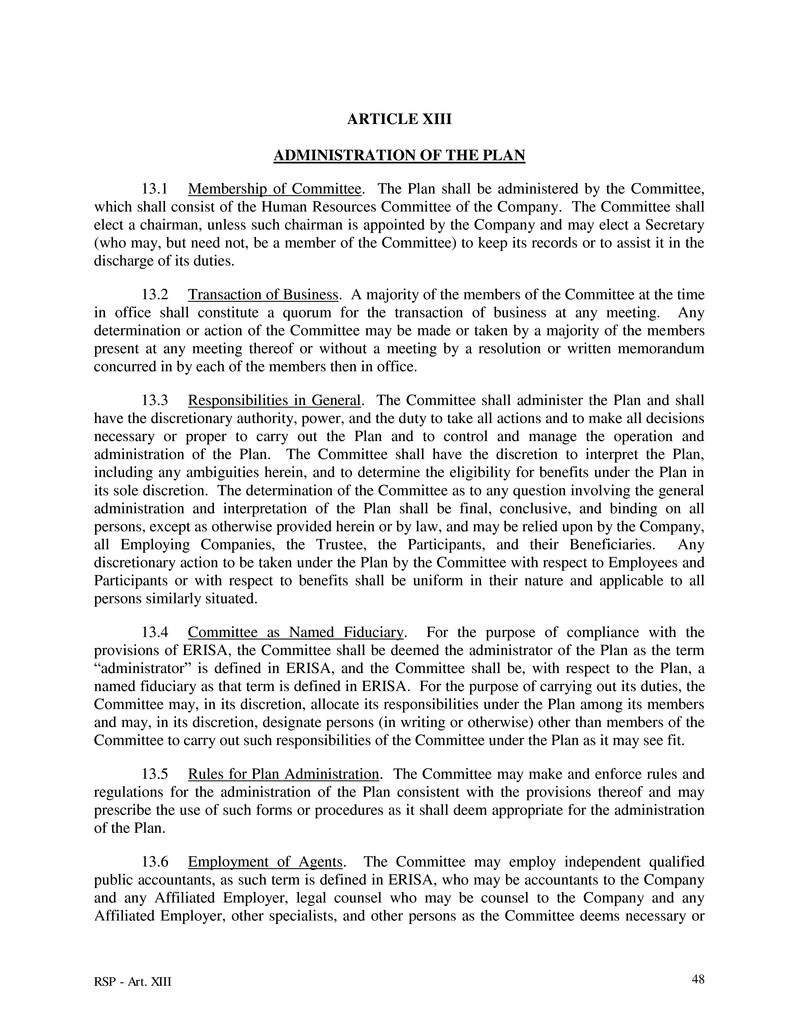
RSP - Art. XIII 48 ARTICLE XIII ADMINISTRATION OF THE PLAN 13.1 Membership of Committee. The Plan shall be administered by the Committee, which shall consist of the Human Resources Committee of the Company. The Committee shall elect a chairman, unless such chairman is appointed by the Company and may elect a Secretary (who may, but need not, be a member of the Committee) to keep its records or to assist it in the discharge of its duties. 13.2 Transaction of Business. A majority of the members of the Committee at the time in office shall constitute a quorum for the transaction of business at any meeting. Any determination or action of the Committee may be made or taken by a majority of the members present at any meeting thereof or without a meeting by a resolution or written memorandum concurred in by each of the members then in office. 13.3 Responsibilities in General. The Committee shall administer the Plan and shall have the discretionary authority, power, and the duty to take all actions and to make all decisions necessary or proper to carry out the Plan and to control and manage the operation and administration of the Plan. The Committee shall have the discretion to interpret the Plan, including any ambiguities herein, and to determine the eligibility for benefits under the Plan in its sole discretion. The determination of the Committee as to any question involving the general administration and interpretation of the Plan shall be final, conclusive, and binding on all persons, except as otherwise provided herein or by law, and may be relied upon by the Company, all Employing Companies, the Trustee, the Participants, and their Beneficiaries. Any discretionary action to be taken under the Plan by the Committee with respect to Employees and Participants or with respect to benefits shall be uniform in their nature and applicable to all persons similarly situated. 13.4 Committee as Named Fiduciary. For the purpose of compliance with the provisions of ERISA, the Committee shall be deemed the administrator of the Plan as the term “administrator” is defined in ERISA, and the Committee shall be, with respect to the Plan, a named fiduciary as that term is defined in ERISA. For the purpose of carrying out its duties, the Committee may, in its discretion, allocate its responsibilities under the Plan among its members and may, in its discretion, designate persons (in writing or otherwise) other than members of the Committee to carry out such responsibilities of the Committee under the Plan as it may see fit. 13.5 Rules for Plan Administration. The Committee may make and enforce rules and regulations for the administration of the Plan consistent with the provisions thereof and may prescribe the use of such forms or procedures as it shall deem appropriate for the administration of the Plan. 13.6 Employment of Agents. The Committee may employ independent qualified public accountants, as such term is defined in ERISA, who may be accountants to the Company and any Affiliated Employer, legal counsel who may be counsel to the Company and any Affiliated Employer, other specialists, and other persons as the Committee deems necessary or

RSP - Art. XIII 49 desirable in connection with the administration of the Plan. The Committee and any person to whom it may delegate any duty or power in connection with the administration of the Plan, the Company and the officers and directors thereof shall be entitled to rely conclusively upon and shall be fully protected in any action omitted, taken, or suffered by them in good faith in reliance upon any independent qualified public accountant, counsel, or other specialist, or other person selected by the Committee, or in reliance upon any tables, evaluations, certificates, opinions, or reports which shall be furnished by any of them or by the Trustee. 13.7 Co-Fiduciaries. It is intended that to the maximum extent permitted by ERISA, each person who is a fiduciary (as that term is defined in ERISA) with respect to the Plan shall be responsible for the proper exercise of his own powers, duties, responsibilities, and obligations under the Plan and the Trust, as shall each person designated by any fiduciary to carry out any fiduciary responsibilities with respect to the Plan or the Trust. No fiduciary or other person to whom fiduciary responsibilities are allocated shall be liable for any act or omission of any other fiduciary or of any other person delegated to carry out any fiduciary or other responsibility under the Plan or the Trust. 13.8 General Records. The Committee shall maintain or cause to be maintained an Account (and any separate subaccount) which accurately reflects the interest of each Participant, as provided for in Section 9.1, and shall maintain or cause to be maintained all necessary books of account and records with respect to the administration of the Plan. The Committee shall mail or cause to be mailed to Participants reports to be furnished to Participants in accordance with the Plan or as may be required by ERISA. Any notices, reports, or statements to be given, furnished, made, or delivered to a Participant shall be deemed duly given, furnished, made, or delivered when addressed to the Participant and delivered to the Participant in person or mailed by ordinary mail to his address last communicated to the Committee (or its delegate) or of his Employing Company. 13.9 Liability of the Committee. In administering the Plan, except as may be prohibited by ERISA, neither the Committee nor any person to whom it may delegate any duty or power in connection with administering the Plan shall be liable for any action or failure to act except for its or his own gross negligence or willful misconduct; nor for the payment of any amount under the Plan; nor for any mistake of judgment made by him or on his behalf as a member of the Committee; nor for any action, failure to act, or loss unless resulting from his own gross negligence or willful misconduct; nor for the neglect, omission, or wrongdoing of any other member of the Committee. No member of the Committee shall be personally liable under any contract, agreement, bond, or other instrument made or executed by him or on his behalf as a member of the Committee. 13.10 Reimbursement of Expenses and Compensation of Committee. Members of the Committee shall be reimbursed by the Company for expenses they may individually or collectively incur in the performance of their duties. Each member of the Committee who is a full-time employee of the Company or of any Employing Company shall serve without compensation for his services as such member; each other member of the Committee shall receive such compensation, if any, for his services as the Board of Directors may fix from time to time.

RSP - Art. XIII 50 13.11 Expenses of Plan and Trust Fund. The expenses of establishment and administration of the Plan and the Trust Fund, including all fees of auditors, and counsel, and Trustee fees shall be paid by the Trust unless otherwise paid by the Company or the Employing Companies. Notwithstanding the foregoing, the Employing Companies may be reimbursed for expenses paid on behalf of the Trust provided that a written request for reimbursement is provided to the Trustee within six months of the payment of such expense. Any expenses directly related to the investments of the Trust Fund, such as stock transfer taxes, brokerage commissions, or other charges incurred in the acquisition or disposition of such investments, shall be paid from the Trust Fund (or from the particular Investment Fund to which such fees or expenses relate) and shall be deemed to be part of the cost of such securities or deducted in computing the proceeds therefrom, as the case may be. Investment management fees for the Investment Funds shall be paid from the particular Investment Fund to which they relate. Any expenses paid by the Company pursuant to Section 13.11 shall be subject to reimbursement by other Employing Companies of their proportionate shares of such expenses as determined by the Committee. 13.12 Responsibility for Funding Policy. The Committee shall have responsibility for providing a procedure for establishing and carrying out a funding policy and method for the Plan consistent with the objectives of the Plan and the requirements of Title I of ERISA. 13.13 Management of Assets. The Committee shall not have responsibility with respect to the control or management of the assets of the Plan. The Trustee shall have the sole responsibility for the administration of the assets of the Plan as provided in the Trust Agreement, except to the extent that an investment advisor (who qualifies as an Investment Manager as that term is defined in ERISA) who may be appointed by the Committee shall have responsibility for the management of the assets of the Plan, or some part thereof (including the powers to acquire and dispose of the assets of the Plan, or some part thereof). 13.14 Notice and Claims Procedures. Consistent with the requirements of ERISA and the regulations thereunder of the Secretary of Labor from time to time in effect, the Committee shall follow the procedures as set forth below: (a) Deciding the Claim. A claim is a request for a Plan benefit made by a claimant on a form provided by the Committee. The claimant must mail or deliver the completed and executed form to the Committee for it to be considered. The Committee shall decide the claim. Except in the case of a claim as a result of Total and Permanent Disability (“disability claim” or “disability benefits”), if a claim is wholly or partially denied, the Committee shall provide the claimant with written or electronic notification of the adverse benefit determination within a reasonable period of time, but not later than 90 days after receipt of the claim by the Committee, unless the Committee determines that special circumstances require an extension of time for processing the claim. If the Committee determines that an extension of time for processing is required, written notice of the extension shall be furnished to the claimant prior to the termination of the initial 90-day period. In no event shall such extension exceed a period of 90 days from the end of such initial period. The extension notice shall indicate the special circumstances requiring an extension of time and the date by which the Committee expects to render the benefit determination.
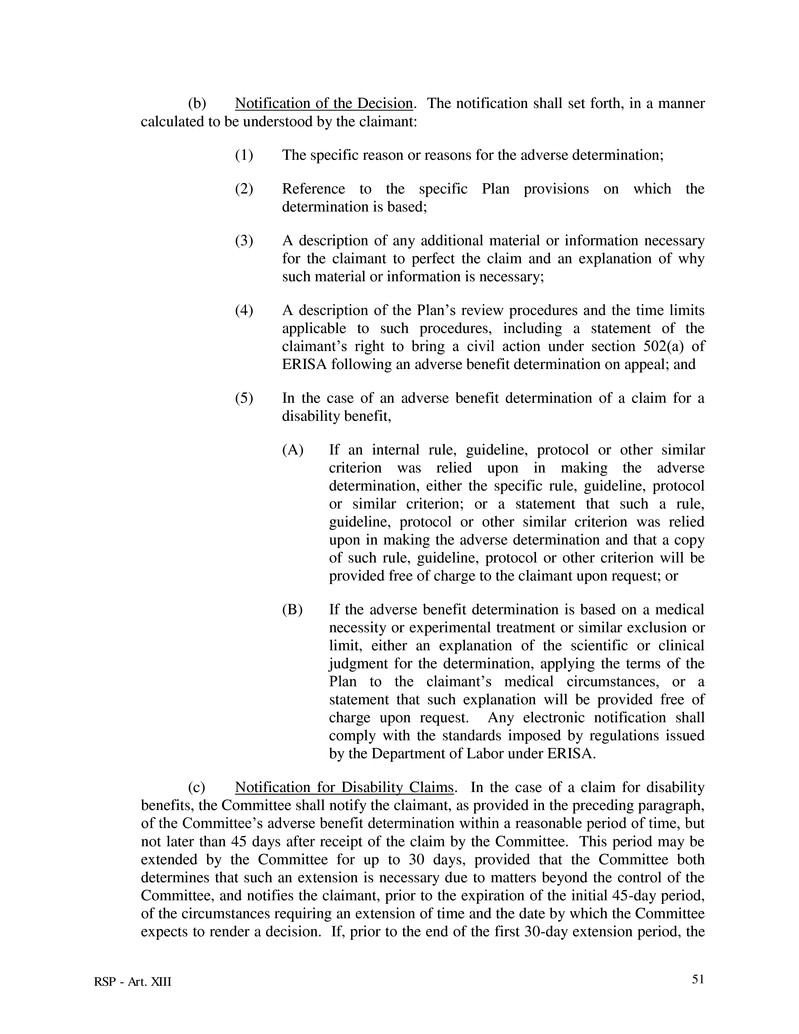
RSP - Art. XIII 51 (b) Notification of the Decision. The notification shall set forth, in a manner calculated to be understood by the claimant: (1) The specific reason or reasons for the adverse determination; (2) Reference to the specific Plan provisions on which the determination is based; (3) A description of any additional material or information necessary for the claimant to perfect the claim and an explanation of why such material or information is necessary; (4) A description of the Plan’s review procedures and the time limits applicable to such procedures, including a statement of the claimant’s right to bring a civil action under section 502(a) of ERISA following an adverse benefit determination on appeal; and (5) In the case of an adverse benefit determination of a claim for a disability benefit, (A) If an internal rule, guideline, protocol or other similar criterion was relied upon in making the adverse determination, either the specific rule, guideline, protocol or similar criterion; or a statement that such a rule, guideline, protocol or other similar criterion was relied upon in making the adverse determination and that a copy of such rule, guideline, protocol or other criterion will be provided free of charge to the claimant upon request; or (B) If the adverse benefit determination is based on a medical necessity or experimental treatment or similar exclusion or limit, either an explanation of the scientific or clinical judgment for the determination, applying the terms of the Plan to the claimant’s medical circumstances, or a statement that such explanation will be provided free of charge upon request. Any electronic notification shall comply with the standards imposed by regulations issued by the Department of Labor under ERISA. (c) Notification for Disability Claims. In the case of a claim for disability benefits, the Committee shall notify the claimant, as provided in the preceding paragraph, of the Committee’s adverse benefit determination within a reasonable period of time, but not later than 45 days after receipt of the claim by the Committee. This period may be extended by the Committee for up to 30 days, provided that the Committee both determines that such an extension is necessary due to matters beyond the control of the Committee, and notifies the claimant, prior to the expiration of the initial 45-day period, of the circumstances requiring an extension of time and the date by which the Committee expects to render a decision. If, prior to the end of the first 30-day extension period, the

RSP - Art. XIII 52 Committee determines that, due to matters beyond the control of the Plan, a decision cannot be rendered within that extension period, the period for making the determination may be extended for up to an additional 30 days, provided that the Committee notifies the claimant, prior to the expiration of the first 30-day extension period, of the circumstances requiring the extension and the date as of which the Committee expects to render a decision. The notice of extension shall specifically explain the standards on which entitlement to a benefit is based, the unresolved issues that prevent the decision on the claim, and the additional information needed to resolve those issues. The claimant should be afforded at least 45 days within which to provide the specified information. (d) Time for Deciding Claims. For purposes of subsection 13.14(a), the period of time within which a benefit determination is required to be made shall begin at the time a claim is filed in accordance with the procedures set forth in that subsection, without regard to whether all the information necessary to make a benefit determination accompanies the filing. In the event a period of time is extended as permitted by subsection 13.14(a) due to a claimant’s failure to submit information necessary to decide a claim, the period for making the benefit determination shall be tolled from the date on which the notification of the extension is sent to the claimant until the date on which the claimant responds to the request for additional information. (e) Authorized Representative. An authorized representative of the claimant may act on his or her behalf in pursuing a benefit claim or appeal of an adverse benefit determination. The Committee may require, as a prerequisite to dealing with a representative, that the claimant verify in writing authority of the representative to act on behalf of the claimant. (f) Consistency. The Committee shall conduct or have conducted on its behalf periodic reviews to verify that benefit claim determinations are made in accordance with governing Plan documents and that, where appropriate, the Plan’s provisions have been applied consistently with respect to similarly-situated claimants. (g) Deciding the Appeal. A claimant may appeal an adverse benefit determination to the Committee by mailing or delivering to the Committee a written notice of appeal. The claimant may submit written comments, documents, records, or other information relating to the claim for benefits to the Committee. The Committee shall provide to the claimant, upon request and free of charge, reasonable access to, and copies of, all documents, records, and other information relevant to the claimant’s claim for benefits. Whether a document, record or other information is relevant to a claim for benefits shall be determined in accordance with standards issued by the Department of Labor. The Committee shall decide the appeal. The Committee’s decision shall take into account all comments, documents, records, and other information submitted by the claimant relating to the claim, without regard to whether such information was submitted or considered in the initial benefit determination. The Committee will not, however, consider a claimant’s appeal unless the Committee receives it within 60 days following receipt by the claimant of a notification of an adverse benefit determination.

RSP - Art. XIII 53 (h) Disability Appeals. In the case of an appeal involving a disability benefit, the Committee will not consider the appeal unless the Committee receives it within 180 days (rather than the generally applicable 60 days) after the claimant receives written notification of the denial of his or her claim. In deciding an appeal of any adverse benefit determination involving a disability benefit where the determination is based in whole or in part on a medical judgment, including determinations with regard to whether a particular treatment, drug or other item is experimental, investigational, or not medically necessary or appropriate, the Committee shall consult with a health care professional who has appropriate training and experience in the field of medicine involved in the medical judgment. In the case of an adverse benefit determination involving a disability claim, the review on appeal shall provide for the identification of medical or vocational experts whose advice was obtained on behalf of the Plan in connection with a claimant’s adverse benefit determination, without regard to whether the advice was relied upon in making the benefit determination. Any health care professional engaged for purposes of a consultation under this section shall be an individual who is neither an individual who was consulted in connection with the adverse benefit determination that is the subject of the appeal, nor the subordinate of any such individual. (i) Time for Deciding Appeals. The Committee will decide a claimant’s appeal no later than 60 days following the Committee’s receipt of the appeal, unless the Committee determines that special circumstances require an extension of time for processing the claim. If the Committee determines that an extension of time for processing the claim is required, written notice of the extension shall be furnished to the claimant prior to the termination of the initial 60-day period. In no event shall such extension exceed a period of 60 days from the end of the initial period. The extension notice shall indicate the special circumstances requiring an extension of time and the date by which the Committee expects to render its decision. (j) Notification of the Decision on Appeal. Except in the case of a disability claim, the Committee shall provide a claimant as soon as possible, but not later than five days after the benefit determination is made, with written or electronic notification of the Committee’s decision on appeal. Any electronic notification shall comply with the standards imposed by the Department of Labor by regulations issued under ERISA. In the case of an adverse benefit determination, the notice shall set forth, in a manner calculated to be understood by the claimant: (1) The specific reason or reasons for the adverse determination; (2) Reference to the specific Plan provisions on which the benefit determination is based; (3) A statement that the claimant is entitled to receive, upon request and free of charge, reasonable access to, and copies of, all documents, records, and other information relevant to the claimant’s claim for benefits (whether a document, record or other information is relevant to a claim for benefit shall be determined
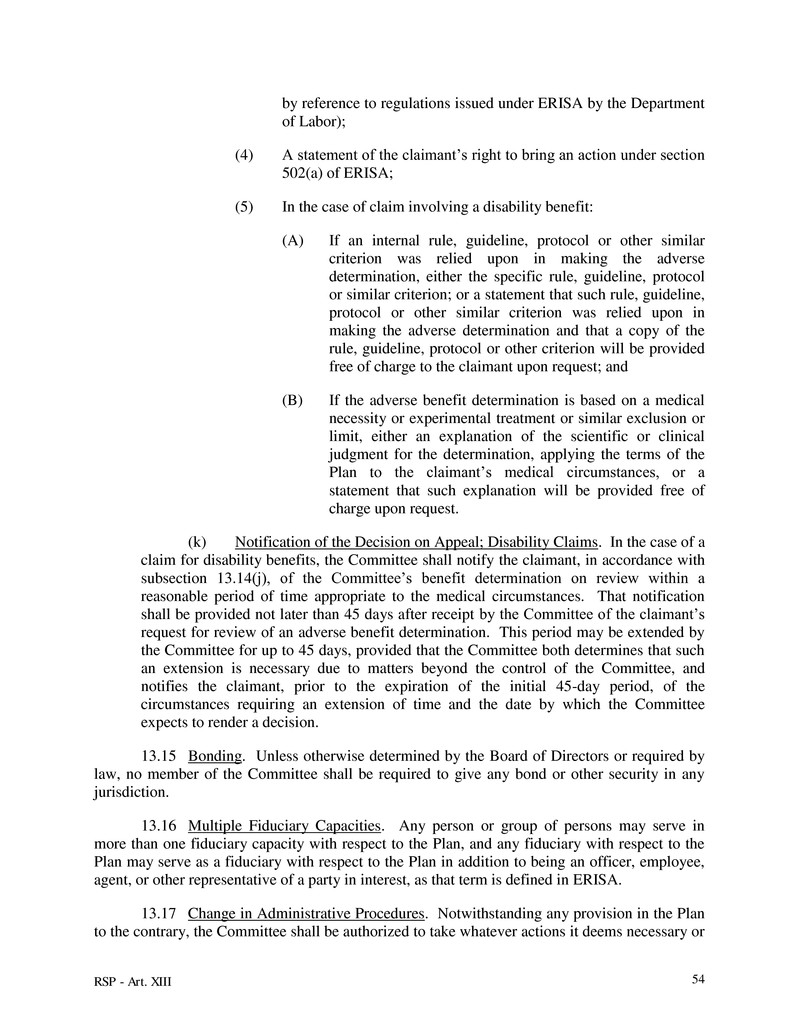
RSP - Art. XIII 54 by reference to regulations issued under ERISA by the Department of Labor); (4) A statement of the claimant’s right to bring an action under section 502(a) of ERISA; (5) In the case of claim involving a disability benefit: (A) If an internal rule, guideline, protocol or other similar criterion was relied upon in making the adverse determination, either the specific rule, guideline, protocol or similar criterion; or a statement that such rule, guideline, protocol or other similar criterion was relied upon in making the adverse determination and that a copy of the rule, guideline, protocol or other criterion will be provided free of charge to the claimant upon request; and (B) If the adverse benefit determination is based on a medical necessity or experimental treatment or similar exclusion or limit, either an explanation of the scientific or clinical judgment for the determination, applying the terms of the Plan to the claimant’s medical circumstances, or a statement that such explanation will be provided free of charge upon request. (k) Notification of the Decision on Appeal; Disability Claims. In the case of a claim for disability benefits, the Committee shall notify the claimant, in accordance with subsection 13.14(j), of the Committee’s benefit determination on review within a reasonable period of time appropriate to the medical circumstances. That notification shall be provided not later than 45 days after receipt by the Committee of the claimant’s request for review of an adverse benefit determination. This period may be extended by the Committee for up to 45 days, provided that the Committee both determines that such an extension is necessary due to matters beyond the control of the Committee, and notifies the claimant, prior to the expiration of the initial 45-day period, of the circumstances requiring an extension of time and the date by which the Committee expects to render a decision. 13.15 Bonding. Unless otherwise determined by the Board of Directors or required by law, no member of the Committee shall be required to give any bond or other security in any jurisdiction. 13.16 Multiple Fiduciary Capacities. Any person or group of persons may serve in more than one fiduciary capacity with respect to the Plan, and any fiduciary with respect to the Plan may serve as a fiduciary with respect to the Plan in addition to being an officer, employee, agent, or other representative of a party in interest, as that term is defined in ERISA. 13.17 Change in Administrative Procedures. Notwithstanding any provision in the Plan to the contrary, the Committee shall be authorized to take whatever actions it deems necessary or

RSP - Art. XIII 55 appropriate in its discretion to implement administrative procedures, including, but not limited to, suspending plan participation (to the extent permitted by applicable law,) and suspending changes in investment directions and fund transfers, even though otherwise permitted or required under the Plan. 13.18 Contributions. The Company and any Employing Company shall make such contributions to the Trust Fund as are required by the provisions of the Plan, subject to the right of the Company to terminate the Plan or the Employing Company to withdraw from the Plan. The Trustee shall not be required to determine the amount of the Employing Company’s contribution for any Plan Year or to enforce the duty of the Employing Company to make such contributions; but the Trustee shall provide the Employing Company and the Committee with such information as either of them may reasonably require in connection therewith. Any responsibility for pursuing or enforcing the duty of the Employing Company to make contributions shall rest with the Committee.

RSP - Art. XIV 56 ARTICLE XIV TRUSTEE OF THE PLAN 14.1 Trustee. The Company has entered into a Trust Agreement with the Trustee to hold the funds necessary to provide the benefits set forth in the Plan. If the Board of Directors so determines, the Company may enter into a Trust Agreement or Trust Agreements with additional trustees. Any Trust Agreement may be amended by the Company from time to time in accordance with its terms. Any Trust Agreement shall provide, among other things, that all funds received by the Trustee thereunder will be held, administered, invested, and distributed by the Trustee, and that no part of the corpus or income of the Trust held by the Trustee shall be used for or diverted to purposes other than for the exclusive benefit of Participants or their Beneficiaries, except as otherwise provided in the Plan. Any Trust Agreement may also provide that the investment and reinvestment of the Trust Fund, or any part thereof may be carried out in accordance with directions given to the Trustee by any Investment Manager or Investment Managers (as that term is defined in ERISA) who may be appointed by the Committee. The Board of Directors may remove any Trustee or any successor Trustee, and any Trustee or any successor Trustee may resign. Upon removal or resignation of a Trustee, the Board of Directors shall appoint a successor Trustee. 14.2 Purchase of Common Stock. As soon as practicable after receipt of funds applicable to the purchase of Common Stock, the Trustee shall purchase Common Stock or cause Common Stock to be purchased. Such Common Stock may be purchased on the open market or by private purchase (including private purchases directly from the Company); provided that (a) no private purchase may be made at any price greater than the last sale price or highest current independent bid price, whichever is higher, for Common Stock on the New York Stock Exchange, plus an amount equal to the commission payable in a stock exchange transaction; and (b) if such private purchase shall be a purchase of Common Stock directly from the Company, no commission shall be paid with respect thereto. The Trustee may hold in cash, and may temporarily invest in short-term United States obligations, commercial paper, or certificates of deposit, funds applicable to the purchase of Common Stock pending investment of such funds in such Common Stock. 14.3 Voting of Common Stock. Before each annual or special meeting of shareholders of the Company, there shall be sent to each Participant a copy of the proxy soliciting material for the meeting, together with a form requesting instructions to the Trustee on how to vote the shares of Common Stock credited to such Participant’s Account as of the record date of the Common Stock. If a Participant does not provide the Trustee or its designated agent with timely voting instructions for the Trustee, the Committee or its delegate may direct the Trustee how to vote such Participant’s shares. If the Committee or its delegate does not provide the Trustee or its designated agent with timely voting instructions, the Trustee, if required to do so by applicable law, may vote such Participant’s shares. The Committee or its delegate may direct the Trustee with respect to voting unallocated shares of Common Stock, if any. If the Committee or its delegate does not provide the Trustee or its designated agent with timely voting instructions, the Trustee, if required to do so by applicable law, may vote such unallocated shares. In the event of a tender or exchange offer with respect to the Common Stock, the Trustee shall vote shares of

RSP - Art. XIV 57 Common Stock for which no direction is received and unallocated shares of Common Stock in the same proportion as the vote of the Participants, unless otherwise required by applicable law. 14.4 Voting of Other Investment Fund Shares. The Committee or its delegate may direct the Trustee with respect to voting the shares in any Investment Fund other than the Company Stock Fund. To the extent an Investment Manager has been designated with respect to an Investment Fund, such Investment Manager (and not the Committee) shall direct the Trustee with respect to voting the shares in such Investment Fund. If the Investment Manager does not direct the Trustee with respect to voting such shares, the Committee may direct the Trustee with respect to voting such shares. If the Committee does not provide the Trustee or its designated agent with timely voting instructions, the Trustee, if required to do so by applicable law, may vote such shares. 14.5 Uninvested Amounts. The Trustee may keep uninvested an amount of cash sufficient in its opinion to enable it to carry out the purposes of the Plan. 14.6 Independent Accounting. The Board of Directors shall select a firm of independent public accountants to examine and report annually on the financial position and the results of operation of the Trust forming a part of the Plan.

RSP - Art. XV 58 ARTICLE XV AMENDMENT AND TERMINATION OF THE PLAN 15.1 Amendment of the Plan. The Plan may be amended or modified by the Board of Directors pursuant to its written resolutions at any time and from time to time; provided, however, that no such amendment or modification shall make it possible for any part of the corpus or income of the Trust Fund to be used for or diverted to purposes other than for the exclusive benefit of Participants or their Beneficiaries under the Plan, including such part as is required to pay taxes and administration expenses of the Plan. The Plan may also be amended or modified by the Committee (a) if such amendment or modification does not involve a substantial increase in cost to any Employing Company, or (b) as may be necessary, proper, or desirable in order to comply with laws or regulations enacted or promulgated by any federal or state governmental authority and to maintain the qualification of the Plan under Sections 401(a) and 501(a) of the Code and the applicable provisions of ERISA. No amendment to the Plan shall have the effect of decreasing a Participant’s vested interest in his Account, determined without regard to such amendment, as of the later of the date such amendment is adopted or the date it becomes effective. In addition, if the vesting schedule of the Plan is amended, any Participant who has completed at least three (3) Years of Service and whose vested interest is at any time adversely affected by such amendment may elect to have his vested interest determined without regard to such amendment during the election period defined under Section 411(a)(10) of the Code. Finally, no amendment shall eliminate an optional form of benefit in violation of Code Section 411(d)(6). 15.2 Termination of the Plan. It is the intention of the Employing Companies to continue the Plan indefinitely. However, the Board of Directors pursuant to its written resolutions may at any time and for any reason suspend or terminate the Plan or suspend or discontinue the making of contributions of all Participants and of contributions by all Employing Companies. Any Employing Company may, by action of its board of directors and approval of the Board of Directors, suspend or terminate the making of contributions of Participants in the employ of such Employing Company and of contributions by such Employing Company. In the event of termination of the Plan or partial termination or upon complete discontinuance of contributions under the Plan by all Employing Companies or by any one Employing Company, the amount to the credit of the Account of each Participant whose Employing Company shall be affected by such termination or discontinuance shall be nonforfeitable and determined as of the next Valuation Date and shall be distributed to him or his Beneficiary thereafter at such time or times and in such nondiscriminatory manner as is determined by the Committee in compliance with the restrictions on distributions set forth in Code. 15.3 Merger or Consolidation of the Plan. The Plan shall not be merged or consolidated with nor shall any assets or liabilities thereof be transferred to any other plan unless each Participant of the Plan would (if the Plan then terminated) receive a benefit immediately after the merger, consolidation, or transfer which is equal to or greater than the benefit he would

RSP - Art. XV 59 have been entitled to receive immediately prior to the merger, consolidation, or transfer (if the Plan had then terminated).

RSP - Art. XVI 60 ARTICLE XVI TOP-HEAVY REQUIREMENTS 16.1 Top-Heavy Plan Requirements. For any Plan Year the Plan shall be determined to be a top-heavy plan, the Plan shall provide the minimum allocation requirement of Section 16.3. 16.2 Determination of Top-Heavy Status. (a) The Plan shall be determined to be a top-heavy plan for any Plan Year, if, as of the Determination Date, the sum of the Aggregate Accounts of Key Employees under this Plan exceeds sixty percent (60%) of the Aggregate Accounts of all Employees entitled to participate in this Plan. (b) In the case of a Required Aggregation Group, each plan in the group will be considered a top-heavy plan if the Required Aggregation Group is a Top-Heavy Group. No plan in the Required Aggregation Group will be considered a top-heavy plan if the Aggregation Group is not a Top-Heavy Group. In the case of a Permissive Aggregation Group, only a plan that is part of the Required Aggregation Group will be considered a top-heavy plan if the Permissive Aggregation Group is a Top-Heavy Group. A plan that is not part of the Required Aggregation Group but that has nonetheless been aggregated as part of the Permissive Aggregation Group will not be considered a top-heavy plan even if the Permissive Aggregation Group is a Top-Heavy Group. (c) For purposes of this Article XVI, if any Employee is a non-Key Employee for any Plan Year, but such Employee was a Key Employee for any prior Plan Year, such Employee’s Present Value of Accrued Retirement Income and/or Aggregate Account balance shall not be taken into account for purposes of determining whether this Plan is a top-heavy plan (or whether any Aggregation Group which includes this Plan is a Top- Heavy Group). In addition, if an Employee or former Employee has not performed any services for any Employing Company maintaining the Plan at any time during the one- year period ending on the Determination Date, the Aggregate Account and/or Present Value of Accrued Retirement Income shall be excluded in determining whether this Plan is a top-heavy plan. (d) Only those plans of the Affiliated Employers in which the Determination Dates fall within the same calendar year shall be aggregated in order to determine whether such plans are top-heavy plans. 16.3 Minimum Allocation for Top-Heavy Plan Years. (a) Notwithstanding anything herein to the contrary, for any top-heavy Plan Year, the Employing Company contribution allocated to the Account of each non-Key Employee Participant shall be an amount not less than the lesser of: (1) three percent

RSP - Art. XVI 61 (3%) of such Participant’s compensation for that Plan Year, or (2) a percentage of that Participant’s compensation not to exceed the percentage at which contributions are made under the Plan for the Key Employee for whom such percentage is highest for that Plan Year. The Employer Matching Contributions shall be taken into account for purposes of this Section 16.3. (b) For purposes of the minimum allocation of Section 16.3(a), the percentage allocated to the Account of any Key Employee shall be equal to the ratio of the Employing Company contributions allocated on behalf of such Key Employee divided by the compensation of such Key Employee for that Plan Year. (c) For any top-heavy Plan Year, the minimum allocations of Section 16.3(a) shall be allocated to the Accounts of all non-Key Employees who are Participants and who are employed by the Affiliated Employers on the last day of the Plan Year. (d) Notwithstanding the foregoing, in any Plan Year in which a non-Key Employee is a Participant in both this Plan and a defined benefit plan, and both such plans are top-heavy plans, the Affiliated Employers shall not be required to provide a non-Key Employee with both the full separate minimum defined benefit and the full separate defined contribution plan allocations. Therefore, if a non-Key Employee is participating in a defined benefit plan maintained by the Affiliated Employers and the minimum benefit under Code Section 416(c)(1) is provided the non-Key Employee under such defined benefit plan, the minimum allocation provided for above shall not be applicable, and no minimum allocation shall be made on behalf of the non-Key Employee. Alternatively, the Employing Company may satisfy the minimum allocation requirement of Code Section 416(c)(2) for the non-Key Employee by providing any combination of benefits and/or contributions that satisfy the safe harbor rules of Treasury Regulation Section 1.416-1(M-12). 16.4 Minimum Vesting for Top-Heavy Years. Notwithstanding the provisions of Section 10.1(a) hereof, if a Participant’s termination of employment occurs while the Plan is a Top-Heavy Plan and such Participant is not fully vested in his Account, such Participant’s vested percentage in his Account shall be fully vested if the Participant is credited with three (3) Years of Service.

RSP - Art. XVII 62 ARTICLE XVII GENERAL PROVISIONS 17.1 Plan Not an Employment Contract. The Plan shall not be deemed to constitute a contract between an Employing Company and any Employee, nor shall anything herein contained be deemed to give any Employee any right to be retained in the employ of an Employing Company or to interfere with the right of an Employing Company to discharge any Employee at any time and to treat him without regard to the effect which such treatment might have upon him as a Participant. 17.2 No Right of Assignment or Alienation. Except as may be otherwise permitted or required by law, no right or interest in the Plan of any Participant or Beneficiary and no distribution or payment under the Plan to any Participant or Beneficiary shall be subject in any manner to anticipation, alienation, sale, transfer (except by death), assignment (either at law or in equity), pledge, encumbrance, charge, attachment, garnishment, levy, execution, or other legal or equitable process, whether voluntary or involuntary, and any attempt to so anticipate, alienate, sell, transfer, assign, pledge, encumber, charge, attach, garnish, levy, or execute or enforce any other legal or equitable process against the same shall be void, nor shall any such right, interest, distribution, or payment be in any way liable for or subject to the debts, contracts, liabilities, engagements, or torts of any person entitled to such right, interest, distribution, or payment. If any Participant or Beneficiary is adjudicated bankrupt or purports to anticipate, alienate, sell, transfer, assign, pledge, encumber, or charge any such right, interest, distribution, or payment, voluntarily or involuntarily, or if any action shall be taken which is in violation of the provisions of the immediately preceding sentence, the Committee may hold or apply or cause to be held or applied such right, interest, distribution, or payment or any part thereof to or for the benefit of such Participant or Beneficiary in such manner as is in accordance with applicable law. Notwithstanding the foregoing, a Participant’s benefits may be offset (i.e., reduced) pursuant to a judgment, order, decree issued or settlement agreement, if and to the extent that such offset is permissible or required under Code § 401(a)(13). The Committee shall establish procedures for (a) notifying Participants and alternate payees who have or may have an interest in benefits which are the subject of domestic relations orders, (b) determining whether such domestic relations orders are qualified domestic relations orders under Section 414(p) of the Code, and (c) distributing benefits which are subject to qualified domestic relations orders. 17.3 Payment to Minors and Others. If the Committee determines that any person entitled to a distribution or payment from the Trust Fund is a minor or incompetent or is unable to care for his affairs by reason of physical or mental disability, it may cause all distributions or payments thereafter becoming due to such person to be made to any other person for his benefit, without responsibility to follow the application of payments so made. Payments made pursuant to this provision shall completely discharge the Company, the Trustee, and the Committee with respect to the amounts so paid. No person shall have any rights under the Plan with respect to the Trust Fund, or against the Trustee or any Employing Company, except as specifically provided herein.

RSP - Art. XVII 63 17.4 Source of Benefits. The Trust Fund established under the Plan shall be the sole source of the payments or distributions to be made in accordance with the Plan. No person shall have any rights under the Plan with respect to the Trust Fund, or against the Trustee or any Employing Company, except as specifically provided herein. 17.5 Unclaimed Benefits. If the Committee is unable, within five (5) years after any distribution becomes payable to a Participant or Beneficiary, to make or direct payment to the person entitled thereto because the identity or whereabouts of such person cannot be ascertained, notwithstanding the mailing of due notice to such person at his last known address as indicated by the records of either the Committee or his Employing Company, then such benefit or distribution will be disposed of as follows: (a) If the whereabouts of the Participant is unknown to the Committee, distribution will be made to the Participant’s Beneficiary or Beneficiaries. Payment to such one or more persons shall completely discharge the Company, the Trustee, and the Committee with respect to the amounts so paid. (b) If none of the persons described in (a) above, can be located, then the benefit payable under the Plan shall be forfeited and shall be applied to reduce future Employer Matching Contributions. Notwithstanding the foregoing sentence, such benefit shall be reinstated if a claim is made by the Participant or Beneficiary for the forfeited benefit. 17.6 Military Leave. Notwithstanding any provision of this Plan to the contrary to the extent required by Code Sections 401(a)(37) or 414(u): (a) contributions, benefits and service credit with respect to qualified military service will be provided in accordance with Code section 414(u) with respect to employees who are reemployed with the Employer; (b) in the event a Participant who ceases to be an Employee in order to perform qualified military service dies on or after January 1, 2007 while performing qualified military service, the Participant’s Beneficiary shall be entitled to any additional benefits provided under the Plan (other than benefit accruals relating to the period of qualified military service) as if the Participant has resumed employment with the Employer and then terminated employment on account of death; (c) effective January 1, 2009, “Compensation” as defined under Article II shall include any “differential wage payment” (as defined in section 3401(h)(2) of the Code) received by a Participant performing qualified military service with respect to the Employing Company; and (d) effective January 1, 2009, a Participant who is performing service in the uniformed services described in Code section 3401(h)(2)(A) while on active duty for a period of more than 30 days may elect to receive a payment of his Before-Tax Contribution Account determined as the Valuation Date immediately preceding the distribution. A Participant who makes such an election shall be suspended from making
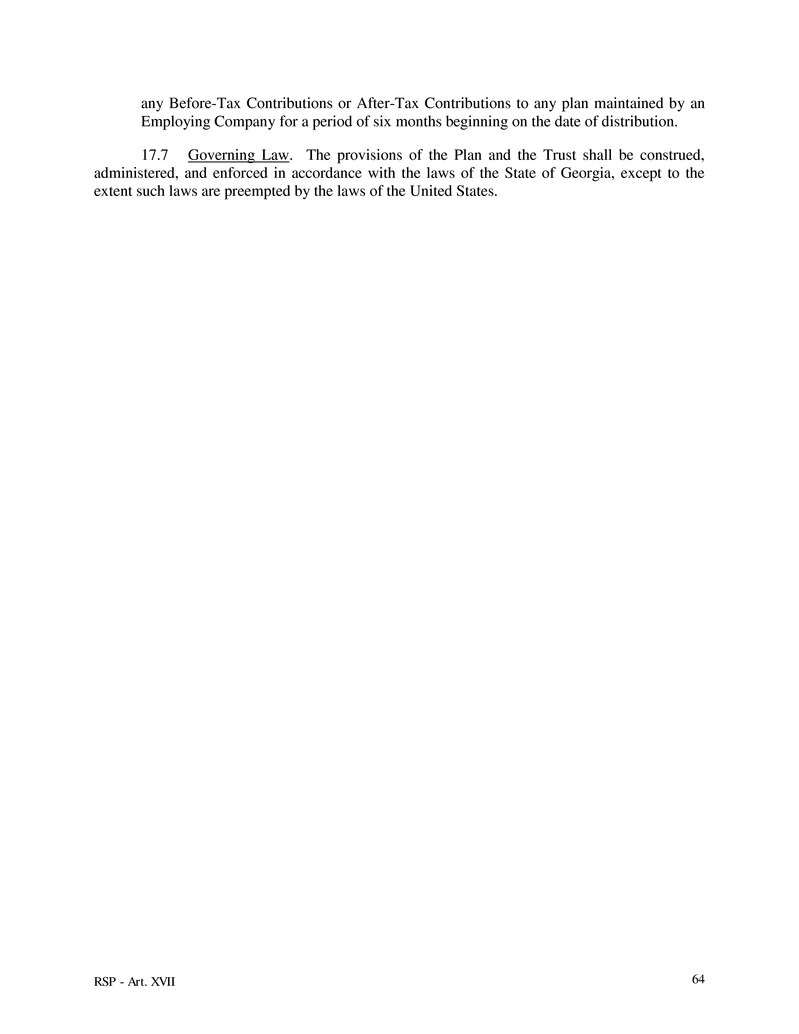
RSP - Art. XVII 64 any Before-Tax Contributions or After-Tax Contributions to any plan maintained by an Employing Company for a period of six months beginning on the date of distribution. 17.7 Governing Law. The provisions of the Plan and the Trust shall be construed, administered, and enforced in accordance with the laws of the State of Georgia, except to the extent such laws are preempted by the laws of the United States.

RSP - Art. XVIII 65 ARTICLE XVIII ESOP COMPONENT 18.1 In General: (a) On and after March 17, 2004, the Plan shall consist of two components, one of which shall be the ESOP Component, and the other of which shall be the Profit Sharing Component. Effective on March 17, 2004, (i) any amounts under the Plan that are invested in Common Stock, shall be invested in the Company Stock Fund, and (ii) the portion of any Account that is invested in the Company Stock Fund shall be provided under the ESOP Component of the Plan, and the portion of any Account that is invested in any Investment Fund other than the Company Stock Fund shall be provided under the Profit Sharing Component of the Plan. (b) The ESOP Component of the Plan is intended to qualify as a stock bonus plan under Section 401(a) of the Code and as an employee stock ownership plan under Section 4975(e)(7) of the Code. The ESOP Component is designed to invest primarily in “qualifying employer securities,” as defined in Sections 4975(e)(8) and 409(l) of the Code and Section 407(d)(5) of ERISA. The ESOP Component is described in this Article XVIII. The provisions of this Article XVIII shall supersede any contrary provisions of the Plan. 18.2 Acquisition and Disposition of Employer Securities. (a) General. Any purchase of Common Stock by the Trust Fund shall be made at a price that is not in excess of its fair value market value. The Committee shall determine the fair market value of any nonpublicly traded Common Stock based upon the value determined by an independent appraiser that has expertise in rendering such evaluations and that satisfies requirements similar to those set forth in Treasury Regulations promulgated under Code Section 170(a)(1). The Committee may direct the Trustee to buy Common Stock from, or sell Common Stock to, any person, subject to Subsection (b) below. (b) Transactions with Disqualified Persons. In the case of any transaction involving Common Stock between the Trust Fund and a Disqualified Person or any transaction involving Common Stock that is subject to Section 406(b) of ERISA, no commission shall be charged with respect to the transaction and the transaction shall be for adequate consideration (as defined in Section 3(18) of ERISA) or, in the case of an evidence of indebtedness of an Employing Company or an affiliate of an Employing Company, at a price not less favorable to the Plan than the price determined under Section 407(e)(1) of ERISA. (c) For purposes of this Article XVIII, “Disqualified Person” shall mean: (1) a fiduciary;

RSP - Art. XVIII 66 (2) a person providing services to the Plan; (3) an Employing Company any of whose Employees are covered by the Plan; (4) an employee organization any of whose members are covered by the Plan; (5) an owner, direct or indirect, of fifty percent (50%) or more of -- (A) the combined voting power of all classes of stock entitled to vote or the total value of shares of all classes of stock of a corporation, (B) the capital interest or the profits interest of a partnership, or (C) the beneficial interest of a trust or unincorporated enterprise, which is an Employing Company or an employee organization described in paragraph (3) or (4) above; (6) a member of the family of any individual described in paragraph (1), (2), (3), or (5) above; (7) a corporation, partnership, or trust or estate of which (or in which) fifty percent (50%) or more of -- (A) the combined voting power of all classes of stock entitled to vote or the total value of shares of all classes of stock of such corporation, (B) the capital interest or profits interest of such partnership, or (C) the beneficial interest of such trust or estate, is owned, directly or indirectly, or held by persons described in paragraph (1), (2), (3), (4), or (5) above; (8) an officer, director (or an individual having powers or responsibilities similar to those of officers or directors), a ten percent (10%) or more shareholder, or a highly compensated employee (earning ten percent (10%) or more of the yearly wages of an employer) of a person described in paragraph (3), (4), (5), or (7) above;

RSP - Art. XVIII 67 (9) a ten percent (10%) or more (in capital or profits) partner or joint venture of a person described in paragraph (3), (4), (5), or (7) above; For purposes of this section the term “fiduciary” means any person who exercises any discretionary authority or discretionary control respecting management of the Plan or exercises any authority or control respecting management or disposition of its assets, renders investment advice for a fee or other compensation, direct or indirect, with respect to any moneys or other property of the Plan, or has any authority or responsibility to do so, or has any discretionary authority or discretionary responsibility in the administration of the Plan. The term “fiduciary” includes any person designated under Section 405(c)(1)(B) of ERISA. For purposes of this section, the family of any individual shall include his or her spouse, ancestor, lineal descendant, and the spouse of a lineal descendant. 18.3 Timing of Distributions. If the Participant’s vested interest in the Plan exceeds $5,000 then, with the consent of the Participant and the Participant’s spouse, if applicable, the entire vested amount shall be distributed as follows: (a) If the Participant terminates employment after his Normal Retirement Date or because of death or Total and Permanent Disability, payments will commence no later than the last day of the Plan Year which follows the Plan Year in which the Participant’s employment was terminated. (b) If the Participant terminates employment for any other reason, payments will commence no later than the last day of the fifth Plan Year following the Plan Year in which the Participant’s employment was terminated. If a Participant does not consent to such a distribution, then the Participant’s vested interest in the Plan shall be distributed pursuant to Section 12.7. 18.4 Put Option on Common Stock. (a) When Put Required. If a Participant receives a distribution of Common Stock and the Common Stock is not readily tradable on an established market, then the Common Stock distributed to the Participant (or his or her Beneficiary) must be subject to a put option, as described in this Section 18.4. (b) Holder of Put. The put option shall be exercisable by the Participant, or if deceased, by the Participant’s Beneficiary, by the donees of either or by a person (including an estate or its distributee) to whom the Common Stock passes by reason of the death of the Participant or the Beneficiary. (c) Responsibility for Put. The holder of the put option shall be entitled to put the Common Stock to the Company. The Committee shall have the authority to have the Plan assume the rights and obligations of the Company at the time the put option is exercised by directing the Trustee to repurchase the Common Stock; provided, however, that under no circumstances may the put option bind the Plan. If it is known that federal or state law will be violated by the Company’s honoring the put option, the put option
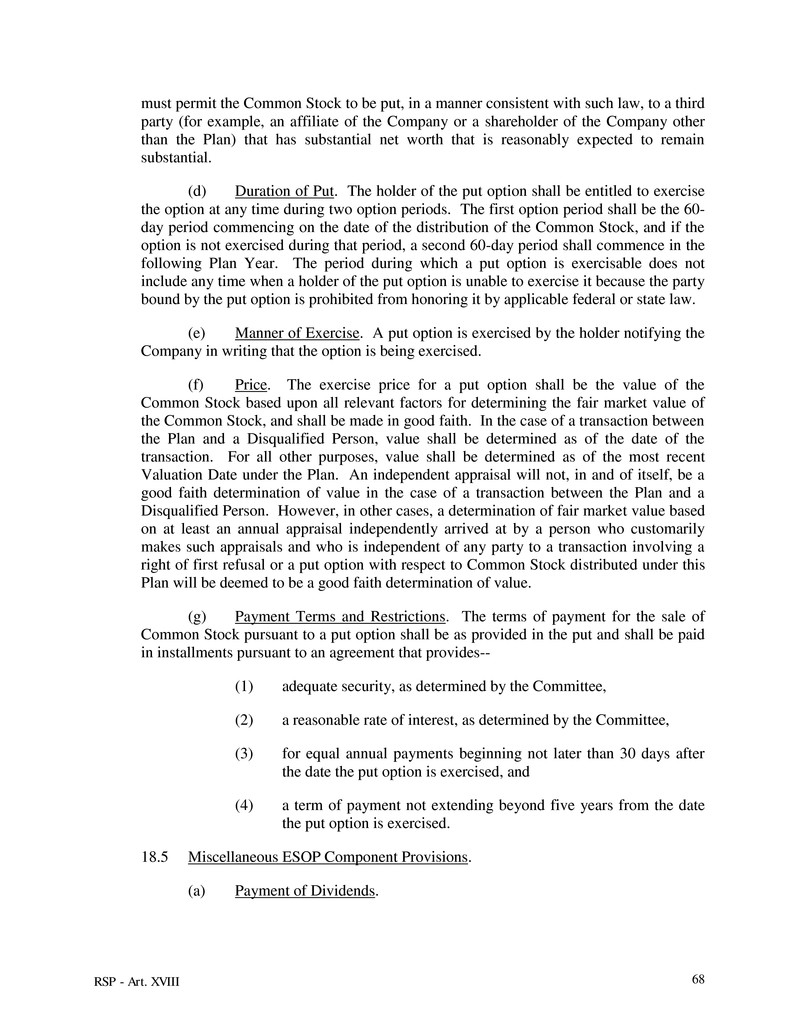
RSP - Art. XVIII 68 must permit the Common Stock to be put, in a manner consistent with such law, to a third party (for example, an affiliate of the Company or a shareholder of the Company other than the Plan) that has substantial net worth that is reasonably expected to remain substantial. (d) Duration of Put. The holder of the put option shall be entitled to exercise the option at any time during two option periods. The first option period shall be the 60- day period commencing on the date of the distribution of the Common Stock, and if the option is not exercised during that period, a second 60-day period shall commence in the following Plan Year. The period during which a put option is exercisable does not include any time when a holder of the put option is unable to exercise it because the party bound by the put option is prohibited from honoring it by applicable federal or state law. (e) Manner of Exercise. A put option is exercised by the holder notifying the Company in writing that the option is being exercised. (f) Price. The exercise price for a put option shall be the value of the Common Stock based upon all relevant factors for determining the fair market value of the Common Stock, and shall be made in good faith. In the case of a transaction between the Plan and a Disqualified Person, value shall be determined as of the date of the transaction. For all other purposes, value shall be determined as of the most recent Valuation Date under the Plan. An independent appraisal will not, in and of itself, be a good faith determination of value in the case of a transaction between the Plan and a Disqualified Person. However, in other cases, a determination of fair market value based on at least an annual appraisal independently arrived at by a person who customarily makes such appraisals and who is independent of any party to a transaction involving a right of first refusal or a put option with respect to Common Stock distributed under this Plan will be deemed to be a good faith determination of value. (g) Payment Terms and Restrictions. The terms of payment for the sale of Common Stock pursuant to a put option shall be as provided in the put and shall be paid in installments pursuant to an agreement that provides-- (1) adequate security, as determined by the Committee, (2) a reasonable rate of interest, as determined by the Committee, (3) for equal annual payments beginning not later than 30 days after the date the put option is exercised, and (4) a term of payment not extending beyond five years from the date the put option is exercised. 18.5 Miscellaneous ESOP Component Provisions. (a) Payment of Dividends.
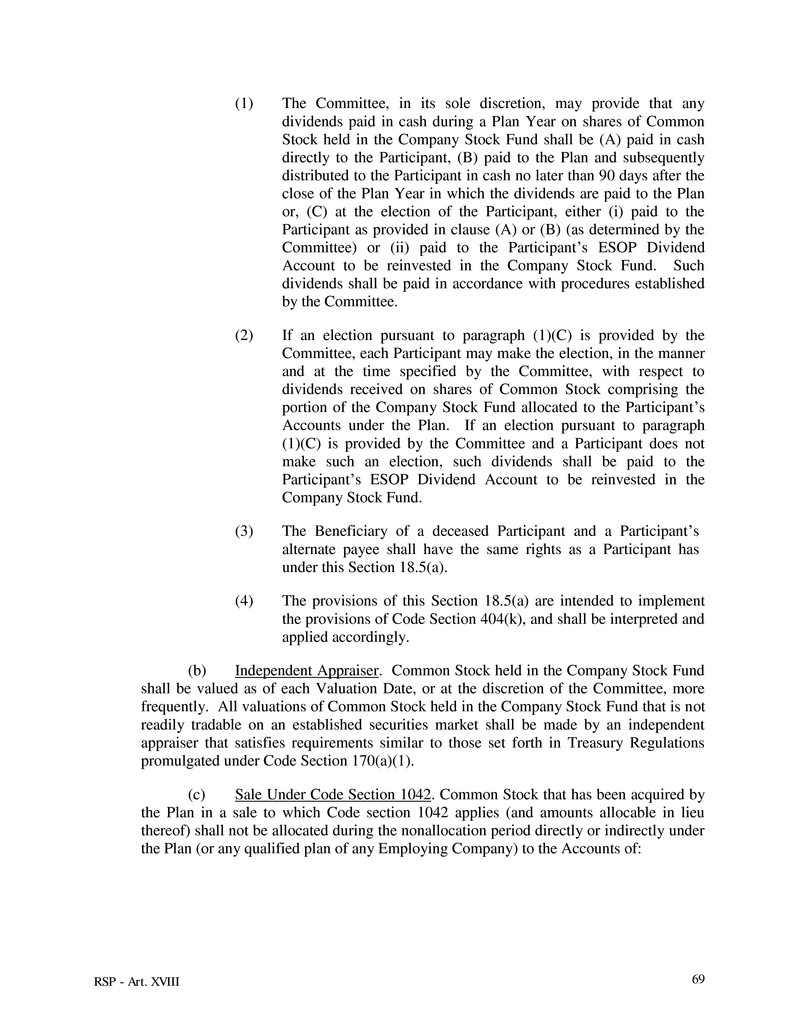
RSP - Art. XVIII 69 (1) The Committee, in its sole discretion, may provide that any dividends paid in cash during a Plan Year on shares of Common Stock held in the Company Stock Fund shall be (A) paid in cash directly to the Participant, (B) paid to the Plan and subsequently distributed to the Participant in cash no later than 90 days after the close of the Plan Year in which the dividends are paid to the Plan or, (C) at the election of the Participant, either (i) paid to the Participant as provided in clause (A) or (B) (as determined by the Committee) or (ii) paid to the Participant’s ESOP Dividend Account to be reinvested in the Company Stock Fund. Such dividends shall be paid in accordance with procedures established by the Committee. (2) If an election pursuant to paragraph (1)(C) is provided by the Committee, each Participant may make the election, in the manner and at the time specified by the Committee, with respect to dividends received on shares of Common Stock comprising the portion of the Company Stock Fund allocated to the Participant’s Accounts under the Plan. If an election pursuant to paragraph (1)(C) is provided by the Committee and a Participant does not make such an election, such dividends shall be paid to the Participant’s ESOP Dividend Account to be reinvested in the Company Stock Fund. (3) The Beneficiary of a deceased Participant and a Participant’s alternate payee shall have the same rights as a Participant has under this Section 18.5(a). (4) The provisions of this Section 18.5(a) are intended to implement the provisions of Code Section 404(k), and shall be interpreted and applied accordingly. (b) Independent Appraiser. Common Stock held in the Company Stock Fund shall be valued as of each Valuation Date, or at the discretion of the Committee, more frequently. All valuations of Common Stock held in the Company Stock Fund that is not readily tradable on an established securities market shall be made by an independent appraiser that satisfies requirements similar to those set forth in Treasury Regulations promulgated under Code Section 170(a)(1). (c) Sale Under Code Section 1042. Common Stock that has been acquired by the Plan in a sale to which Code section 1042 applies (and amounts allocable in lieu thereof) shall not be allocated during the nonallocation period directly or indirectly under the Plan (or any qualified plan of any Employing Company) to the Accounts of:
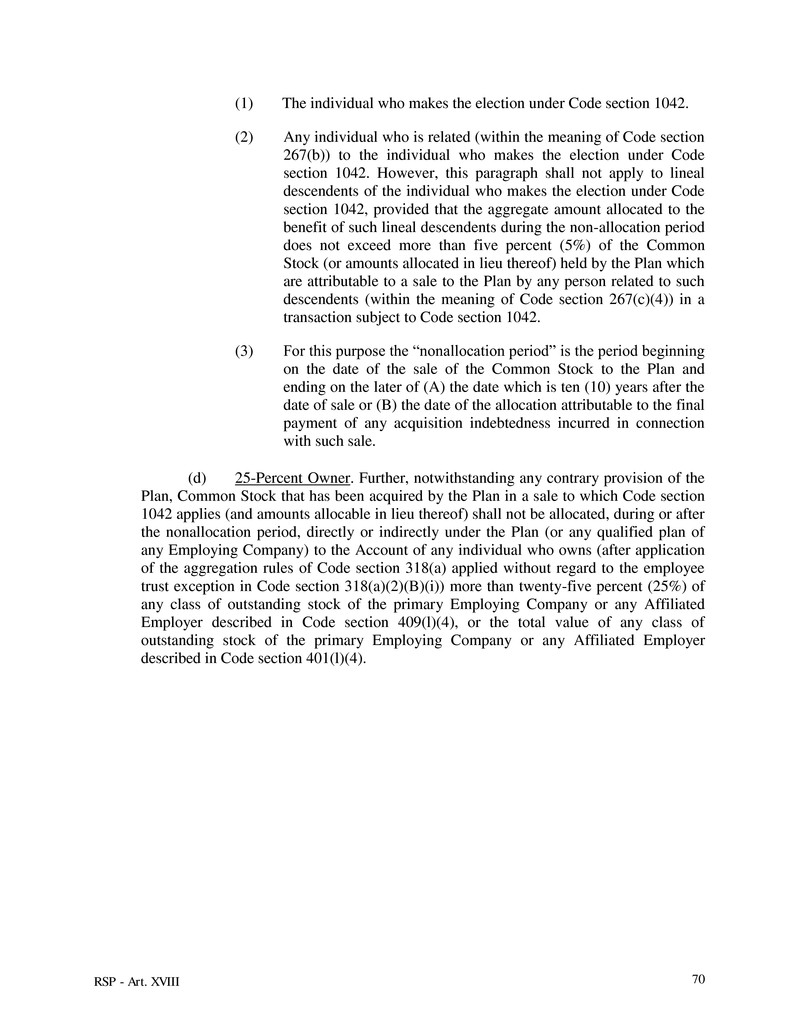
RSP - Art. XVIII 70 (1) The individual who makes the election under Code section 1042. (2) Any individual who is related (within the meaning of Code section 267(b)) to the individual who makes the election under Code section 1042. However, this paragraph shall not apply to lineal descendents of the individual who makes the election under Code section 1042, provided that the aggregate amount allocated to the benefit of such lineal descendents during the non-allocation period does not exceed more than five percent (5%) of the Common Stock (or amounts allocated in lieu thereof) held by the Plan which are attributable to a sale to the Plan by any person related to such descendents (within the meaning of Code section 267(c)(4)) in a transaction subject to Code section 1042. (3) For this purpose the “nonallocation period” is the period beginning on the date of the sale of the Common Stock to the Plan and ending on the later of (A) the date which is ten (10) years after the date of sale or (B) the date of the allocation attributable to the final payment of any acquisition indebtedness incurred in connection with such sale. (d) 25-Percent Owner. Further, notwithstanding any contrary provision of the Plan, Common Stock that has been acquired by the Plan in a sale to which Code section 1042 applies (and amounts allocable in lieu thereof) shall not be allocated, during or after the nonallocation period, directly or indirectly under the Plan (or any qualified plan of any Employing Company) to the Account of any individual who owns (after application of the aggregation rules of Code section 318(a) applied without regard to the employee trust exception in Code section 318(a)(2)(B)(i)) more than twenty-five percent (25%) of any class of outstanding stock of the primary Employing Company or any Affiliated Employer described in Code section 409(l)(4), or the total value of any class of outstanding stock of the primary Employing Company or any Affiliated Employer described in Code section 401(l)(4).

RSP - Art. XVIII 71 IN WITNESS WHEREOF, the Company has caused this Schweitzer-Mauduit International, Inc. Retirement Savings Plan to be executed on the ____day of December 2014. SCHWEITZER-MAUDUIT INTERNATIONAL, INC. By: Its: ___________________________________ Attest: By: Its: __________________________________

RSP - Appendix A 72 APPENDIX A - EMPLOYING COMPANIES Schweitzer-Mauduit International, Inc. DelStar Technologies, Inc. (effective as of January 1, 2015)
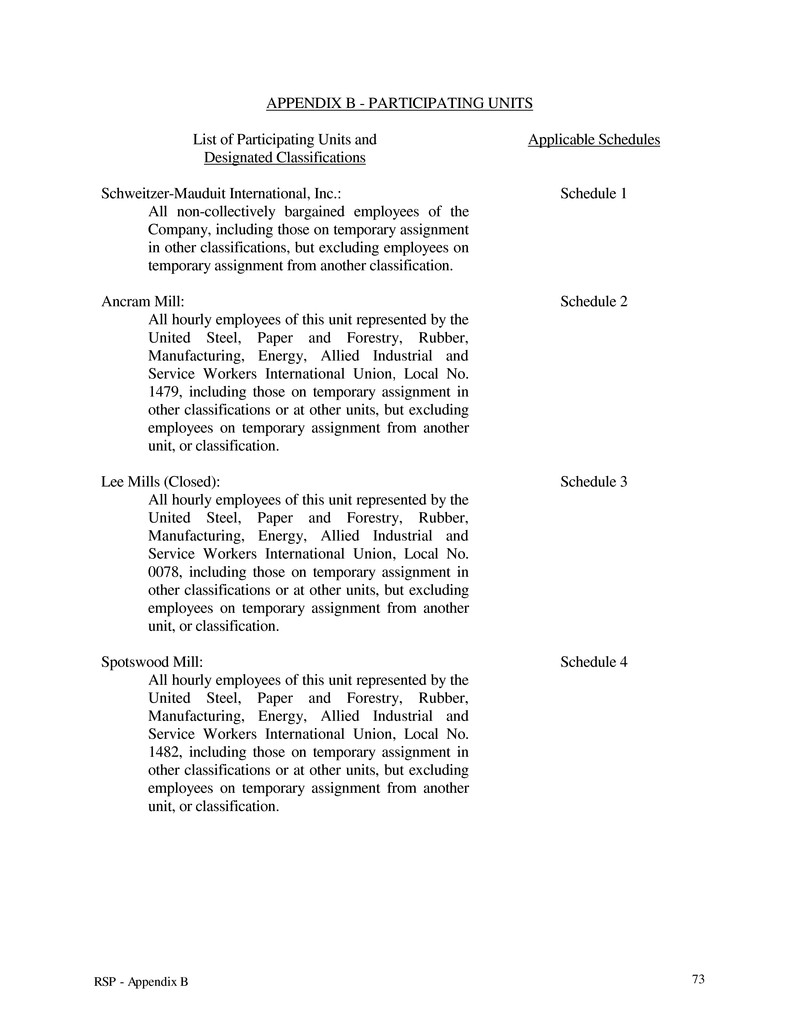
RSP - Appendix B 73 APPENDIX B - PARTICIPATING UNITS List of Participating Units and Designated Classifications Applicable Schedules Schweitzer-Mauduit International, Inc.: All non-collectively bargained employees of the Company, including those on temporary assignment in other classifications, but excluding employees on temporary assignment from another classification. Schedule 1 Ancram Mill: All hourly employees of this unit represented by the United Steel, Paper and Forestry, Rubber, Manufacturing, Energy, Allied Industrial and Service Workers International Union, Local No. 1479, including those on temporary assignment in other classifications or at other units, but excluding employees on temporary assignment from another unit, or classification. Schedule 2 Lee Mills (Closed): All hourly employees of this unit represented by the United Steel, Paper and Forestry, Rubber, Manufacturing, Energy, Allied Industrial and Service Workers International Union, Local No. 0078, including those on temporary assignment in other classifications or at other units, but excluding employees on temporary assignment from another unit, or classification. Schedule 3 Spotswood Mill: All hourly employees of this unit represented by the United Steel, Paper and Forestry, Rubber, Manufacturing, Energy, Allied Industrial and Service Workers International Union, Local No. 1482, including those on temporary assignment in other classifications or at other units, but excluding employees on temporary assignment from another unit, or classification. Schedule 4

RSP - Schedule 1 1 Schweitzer-Mauduit International, Inc. Retirement Savings Plan Schedule 1 (Non-Collectively Bargained Employees) The Plan shall apply with full force and effect to Employee’s covered by this Schedule 1.

RSP - Schedule 2 1 SCHWEITZER-MAUDUIT INTERNATIONAL, INC. RETIREMENT SAVINGS PLAN SCHEDULE 2 (Ancram Mill) With respect to the Participating Unit under this Schedule, consisting of all hourly employees of this unit represented by the United Steel, Paper and Forestry, Rubber, Manufacturing, Energy, Allied Industrial and Service Workers International Union, Local No. 1479, the Plan shall apply with full force and effect except as otherwise specified in this Schedule. Notwithstanding the preceding, Section 5.4, (Section 401(m) Nondiscrimination Tests) and Article XVI (Top- Heavy Requirements) of the Plan shall not apply to the Participating Unit under this Schedule.
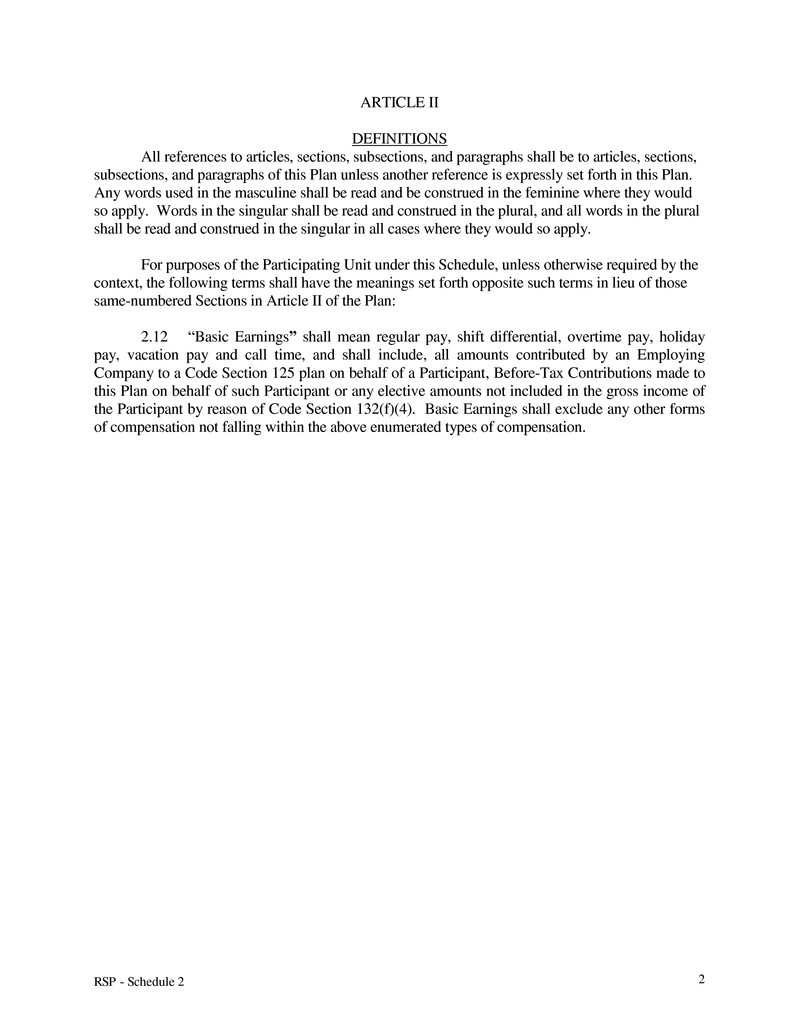
RSP - Schedule 2 2 ARTICLE II DEFINITIONS All references to articles, sections, subsections, and paragraphs shall be to articles, sections, subsections, and paragraphs of this Plan unless another reference is expressly set forth in this Plan. Any words used in the masculine shall be read and be construed in the feminine where they would so apply. Words in the singular shall be read and construed in the plural, and all words in the plural shall be read and construed in the singular in all cases where they would so apply. For purposes of the Participating Unit under this Schedule, unless otherwise required by the context, the following terms shall have the meanings set forth opposite such terms in lieu of those same-numbered Sections in Article II of the Plan: 2.12 “Basic Earnings” shall mean regular pay, shift differential, overtime pay, holiday pay, vacation pay and call time, and shall include, all amounts contributed by an Employing Company to a Code Section 125 plan on behalf of a Participant, Before-Tax Contributions made to this Plan on behalf of such Participant or any elective amounts not included in the gross income of the Participant by reason of Code Section 132(f)(4). Basic Earnings shall exclude any other forms of compensation not falling within the above enumerated types of compensation.
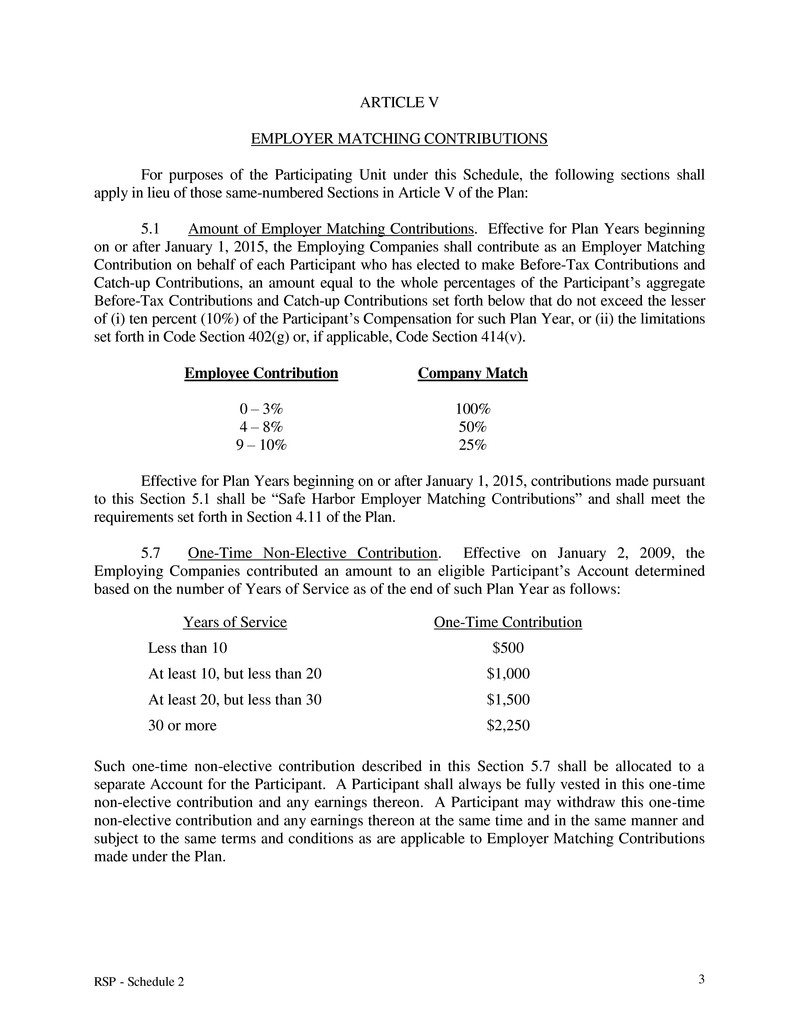
RSP - Schedule 2 3 ARTICLE V EMPLOYER MATCHING CONTRIBUTIONS For purposes of the Participating Unit under this Schedule, the following sections shall apply in lieu of those same-numbered Sections in Article V of the Plan: 5.1 Amount of Employer Matching Contributions. Effective for Plan Years beginning on or after January 1, 2015, the Employing Companies shall contribute as an Employer Matching Contribution on behalf of each Participant who has elected to make Before-Tax Contributions and Catch-up Contributions, an amount equal to the whole percentages of the Participant’s aggregate Before-Tax Contributions and Catch-up Contributions set forth below that do not exceed the lesser of (i) ten percent (10%) of the Participant’s Compensation for such Plan Year, or (ii) the limitations set forth in Code Section 402(g) or, if applicable, Code Section 414(v). Employee Contribution Company Match 0 – 3% 100% 4 – 8% 50% 9 – 10% 25% Effective for Plan Years beginning on or after January 1, 2015, contributions made pursuant to this Section 5.1 shall be “Safe Harbor Employer Matching Contributions” and shall meet the requirements set forth in Section 4.11 of the Plan. 5.7 One-Time Non-Elective Contribution. Effective on January 2, 2009, the Employing Companies contributed an amount to an eligible Participant’s Account determined based on the number of Years of Service as of the end of such Plan Year as follows: Years of Service One-Time Contribution Less than 10 $500 At least 10, but less than 20 $1,000 At least 20, but less than 30 $1,500 30 or more $2,250 Such one-time non-elective contribution described in this Section 5.7 shall be allocated to a separate Account for the Participant. A Participant shall always be fully vested in this one-time non-elective contribution and any earnings thereon. A Participant may withdraw this one-time non-elective contribution and any earnings thereon at the same time and in the same manner and subject to the same terms and conditions as are applicable to Employer Matching Contributions made under the Plan.
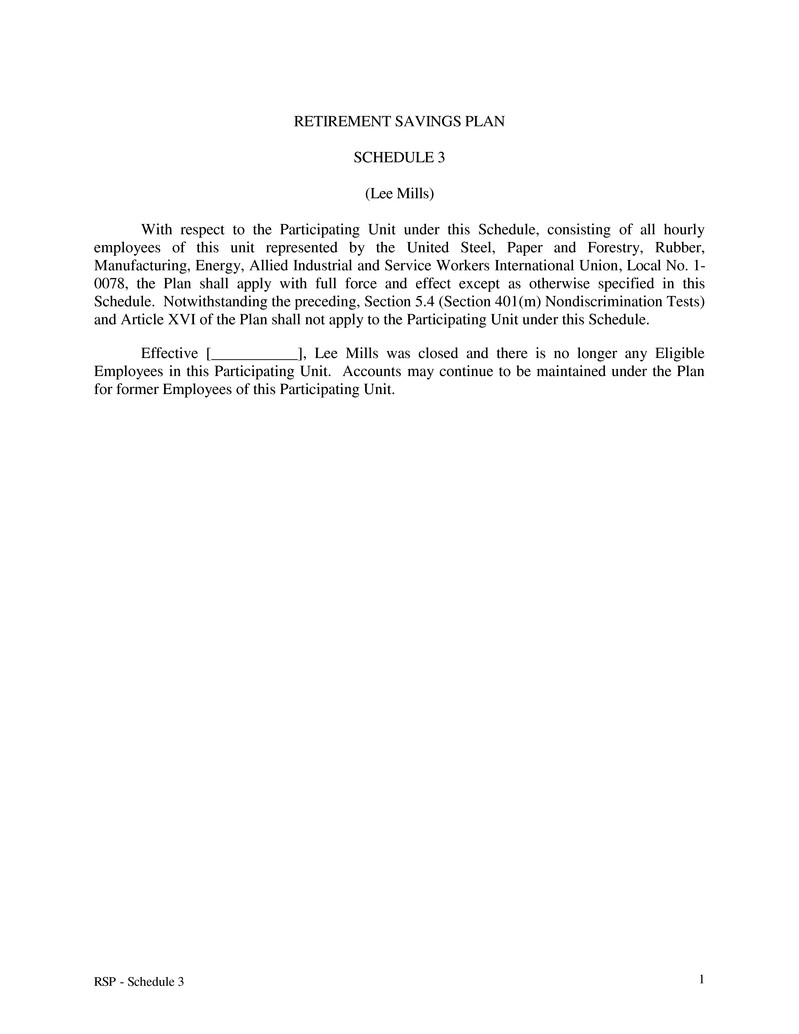
RSP - Schedule 3 1 RETIREMENT SAVINGS PLAN SCHEDULE 3 (Lee Mills) With respect to the Participating Unit under this Schedule, consisting of all hourly employees of this unit represented by the United Steel, Paper and Forestry, Rubber, Manufacturing, Energy, Allied Industrial and Service Workers International Union, Local No. 1- 0078, the Plan shall apply with full force and effect except as otherwise specified in this Schedule. Notwithstanding the preceding, Section 5.4 (Section 401(m) Nondiscrimination Tests) and Article XVI of the Plan shall not apply to the Participating Unit under this Schedule. Effective [___________], Lee Mills was closed and there is no longer any Eligible Employees in this Participating Unit. Accounts may continue to be maintained under the Plan for former Employees of this Participating Unit.
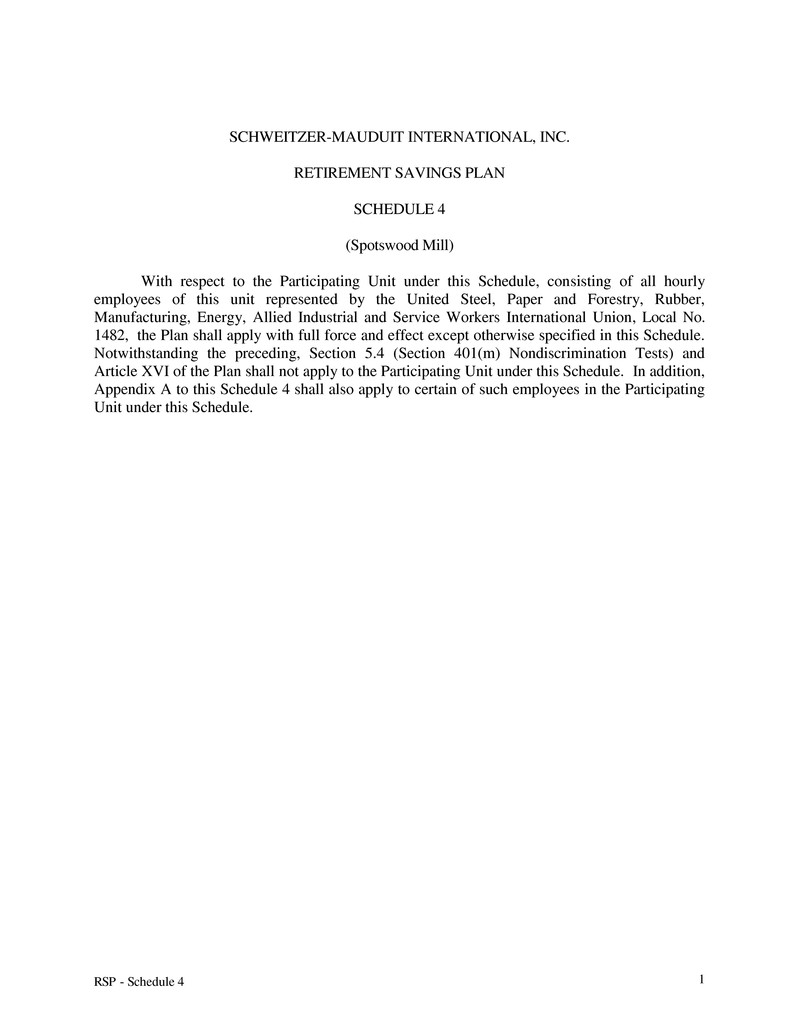
RSP - Schedule 4 1 SCHWEITZER-MAUDUIT INTERNATIONAL, INC. RETIREMENT SAVINGS PLAN SCHEDULE 4 (Spotswood Mill) With respect to the Participating Unit under this Schedule, consisting of all hourly employees of this unit represented by the United Steel, Paper and Forestry, Rubber, Manufacturing, Energy, Allied Industrial and Service Workers International Union, Local No. 1482, the Plan shall apply with full force and effect except otherwise specified in this Schedule. Notwithstanding the preceding, Section 5.4 (Section 401(m) Nondiscrimination Tests) and Article XVI of the Plan shall not apply to the Participating Unit under this Schedule. In addition, Appendix A to this Schedule 4 shall also apply to certain of such employees in the Participating Unit under this Schedule.
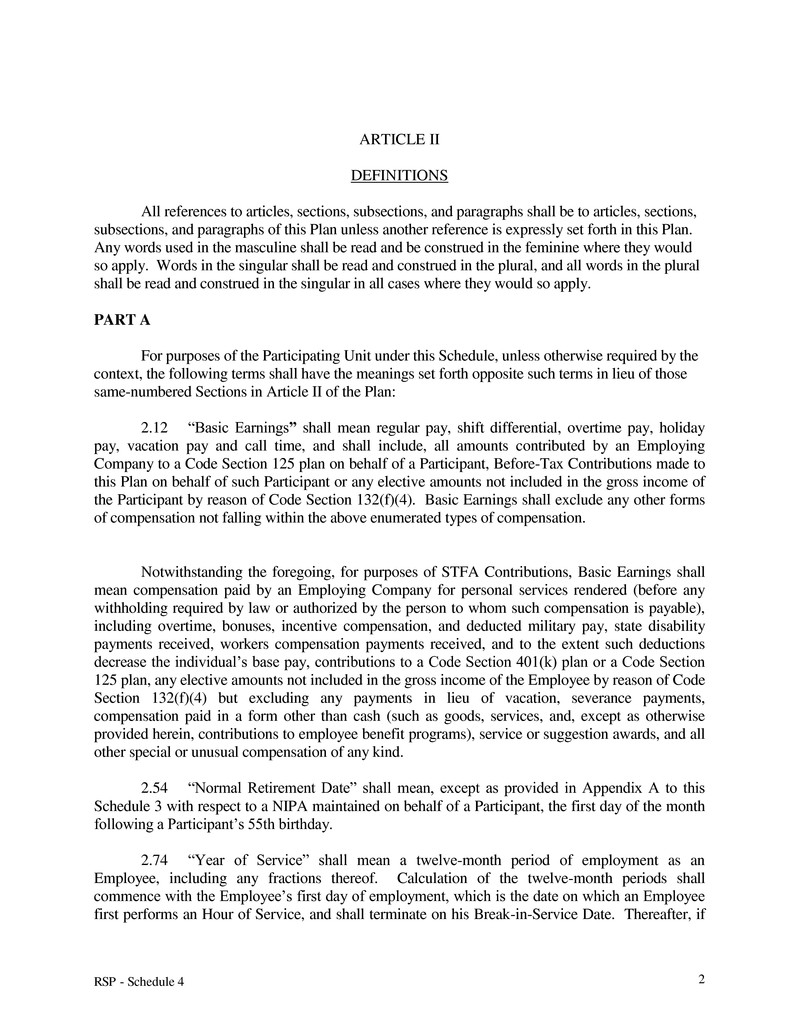
RSP - Schedule 4 2 ARTICLE II DEFINITIONS All references to articles, sections, subsections, and paragraphs shall be to articles, sections, subsections, and paragraphs of this Plan unless another reference is expressly set forth in this Plan. Any words used in the masculine shall be read and be construed in the feminine where they would so apply. Words in the singular shall be read and construed in the plural, and all words in the plural shall be read and construed in the singular in all cases where they would so apply. PART A For purposes of the Participating Unit under this Schedule, unless otherwise required by the context, the following terms shall have the meanings set forth opposite such terms in lieu of those same-numbered Sections in Article II of the Plan: 2.12 “Basic Earnings” shall mean regular pay, shift differential, overtime pay, holiday pay, vacation pay and call time, and shall include, all amounts contributed by an Employing Company to a Code Section 125 plan on behalf of a Participant, Before-Tax Contributions made to this Plan on behalf of such Participant or any elective amounts not included in the gross income of the Participant by reason of Code Section 132(f)(4). Basic Earnings shall exclude any other forms of compensation not falling within the above enumerated types of compensation. Notwithstanding the foregoing, for purposes of STFA Contributions, Basic Earnings shall mean compensation paid by an Employing Company for personal services rendered (before any withholding required by law or authorized by the person to whom such compensation is payable), including overtime, bonuses, incentive compensation, and deducted military pay, state disability payments received, workers compensation payments received, and to the extent such deductions decrease the individual’s base pay, contributions to a Code Section 401(k) plan or a Code Section 125 plan, any elective amounts not included in the gross income of the Employee by reason of Code Section 132(f)(4) but excluding any payments in lieu of vacation, severance payments, compensation paid in a form other than cash (such as goods, services, and, except as otherwise provided herein, contributions to employee benefit programs), service or suggestion awards, and all other special or unusual compensation of any kind. 2.54 “Normal Retirement Date” shall mean, except as provided in Appendix A to this Schedule 3 with respect to a NIPA maintained on behalf of a Participant, the first day of the month following a Participant’s 55th birthday. 2.74 “Year of Service” shall mean a twelve-month period of employment as an Employee, including any fractions thereof. Calculation of the twelve-month periods shall commence with the Employee’s first day of employment, which is the date on which an Employee first performs an Hour of Service, and shall terminate on his Break-in-Service Date. Thereafter, if
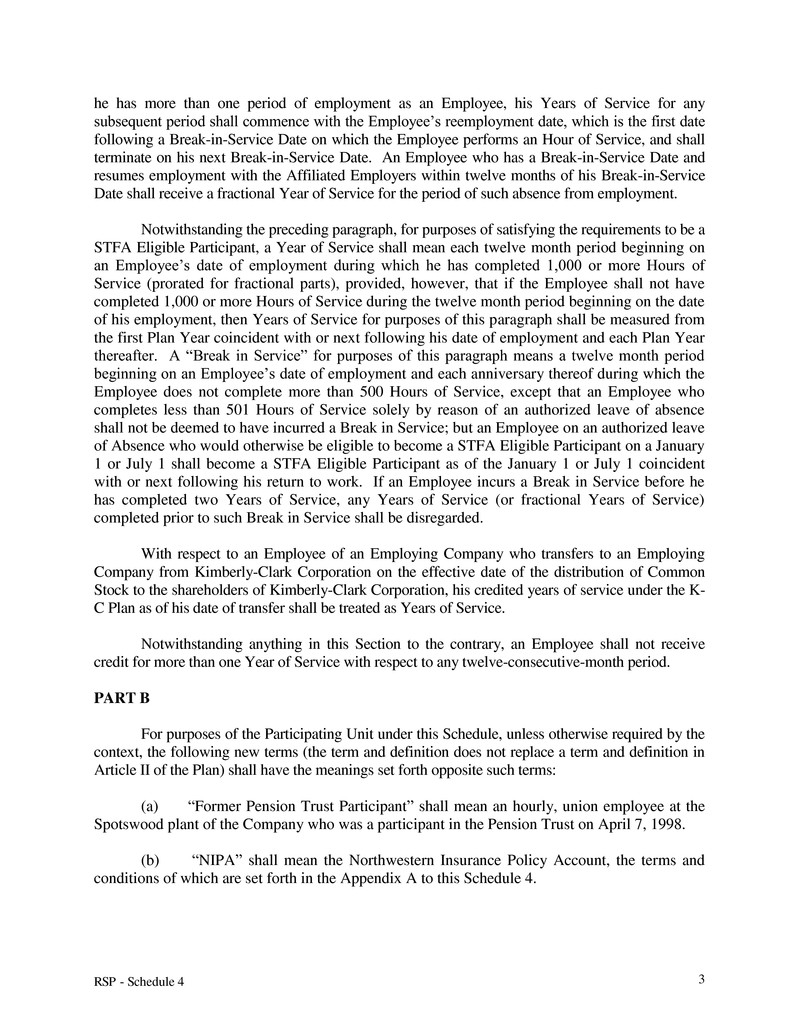
RSP - Schedule 4 3 he has more than one period of employment as an Employee, his Years of Service for any subsequent period shall commence with the Employee’s reemployment date, which is the first date following a Break-in-Service Date on which the Employee performs an Hour of Service, and shall terminate on his next Break-in-Service Date. An Employee who has a Break-in-Service Date and resumes employment with the Affiliated Employers within twelve months of his Break-in-Service Date shall receive a fractional Year of Service for the period of such absence from employment. Notwithstanding the preceding paragraph, for purposes of satisfying the requirements to be a STFA Eligible Participant, a Year of Service shall mean each twelve month period beginning on an Employee’s date of employment during which he has completed 1,000 or more Hours of Service (prorated for fractional parts), provided, however, that if the Employee shall not have completed 1,000 or more Hours of Service during the twelve month period beginning on the date of his employment, then Years of Service for purposes of this paragraph shall be measured from the first Plan Year coincident with or next following his date of employment and each Plan Year thereafter. A “Break in Service” for purposes of this paragraph means a twelve month period beginning on an Employee’s date of employment and each anniversary thereof during which the Employee does not complete more than 500 Hours of Service, except that an Employee who completes less than 501 Hours of Service solely by reason of an authorized leave of absence shall not be deemed to have incurred a Break in Service; but an Employee on an authorized leave of Absence who would otherwise be eligible to become a STFA Eligible Participant on a January 1 or July 1 shall become a STFA Eligible Participant as of the January 1 or July 1 coincident with or next following his return to work. If an Employee incurs a Break in Service before he has completed two Years of Service, any Years of Service (or fractional Years of Service) completed prior to such Break in Service shall be disregarded. With respect to an Employee of an Employing Company who transfers to an Employing Company from Kimberly-Clark Corporation on the effective date of the distribution of Common Stock to the shareholders of Kimberly-Clark Corporation, his credited years of service under the K- C Plan as of his date of transfer shall be treated as Years of Service. Notwithstanding anything in this Section to the contrary, an Employee shall not receive credit for more than one Year of Service with respect to any twelve-consecutive-month period. PART B For purposes of the Participating Unit under this Schedule, unless otherwise required by the context, the following new terms (the term and definition does not replace a term and definition in Article II of the Plan) shall have the meanings set forth opposite such terms: (a) “Former Pension Trust Participant” shall mean an hourly, union employee at the Spotswood plant of the Company who was a participant in the Pension Trust on April 7, 1998. (b) “NIPA” shall mean the Northwestern Insurance Policy Account, the terms and conditions of which are set forth in the Appendix A to this Schedule 4.

RSP - Schedule 4 4 (c) “NIPA Contribution” shall mean a contribution made to the NIPA pursuant to the Appendix A of this Schedule 4 during the Plan Year. (d) “NIPA Eligible Participant” shall mean a Former Pension Trust Participant who elected to have his Policies and/or Contracts (as defined in Appendix A to this Schedule 4) under the Pension Trust rolled over to this Plan and who has never elected to receive a STFA Contribution under Section 5.7. (e) “STFA” shall mean the Schweitzer Trust Fund Account. (f) “STFA Contribution” shall mean a contribution made to the STFA pursuant to Section 5.4 during the Plan Year. (g) “STFA Eligible Participant” shall mean: (a) each former pension trust participant; and (b) each other Participant (1) hired after April 1, 1998 and before June 16, 2002, and (2) who is an Employee on the January 1 or July 1 which is coincident with or next follows the date such Employee completes two Years of Service. A STFA Eligible Participant includes any Participant who is a NIPA Eligible Participant.
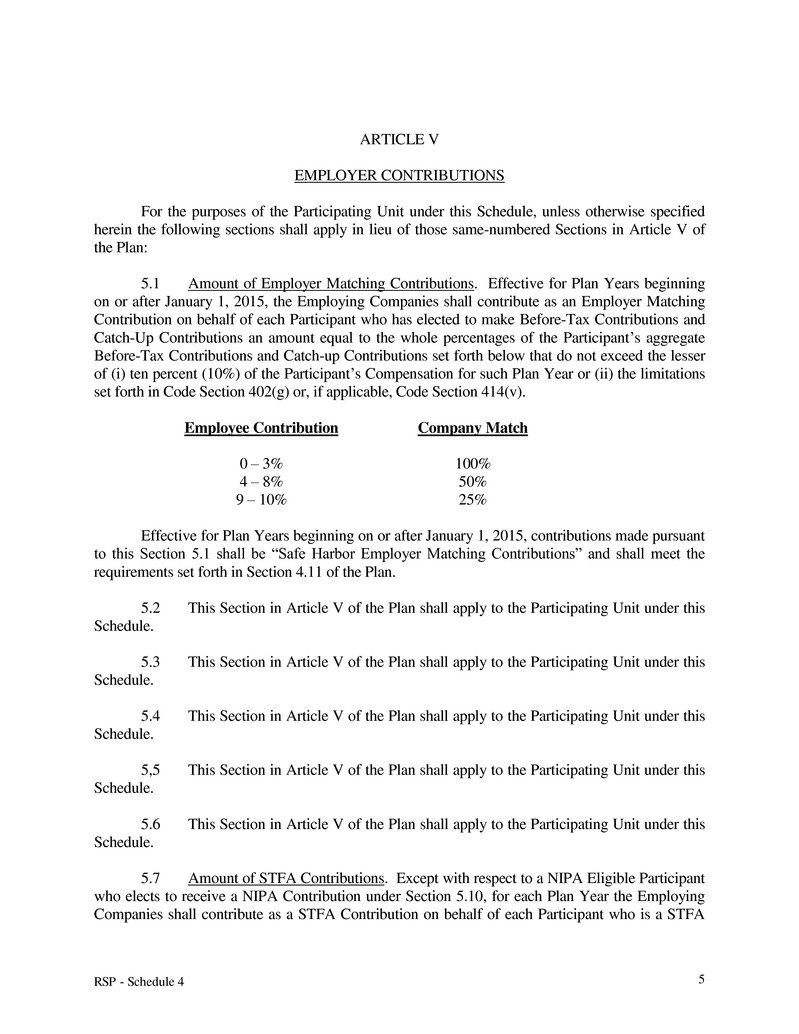
RSP - Schedule 4 5 ARTICLE V EMPLOYER CONTRIBUTIONS For the purposes of the Participating Unit under this Schedule, unless otherwise specified herein the following sections shall apply in lieu of those same-numbered Sections in Article V of the Plan: 5.1 Amount of Employer Matching Contributions. Effective for Plan Years beginning on or after January 1, 2015, the Employing Companies shall contribute as an Employer Matching Contribution on behalf of each Participant who has elected to make Before-Tax Contributions and Catch-Up Contributions an amount equal to the whole percentages of the Participant’s aggregate Before-Tax Contributions and Catch-up Contributions set forth below that do not exceed the lesser of (i) ten percent (10%) of the Participant’s Compensation for such Plan Year or (ii) the limitations set forth in Code Section 402(g) or, if applicable, Code Section 414(v). Employee Contribution Company Match 0 – 3% 100% 4 – 8% 50% 9 – 10% 25% Effective for Plan Years beginning on or after January 1, 2015, contributions made pursuant to this Section 5.1 shall be “Safe Harbor Employer Matching Contributions” and shall meet the requirements set forth in Section 4.11 of the Plan. 5.2 This Section in Article V of the Plan shall apply to the Participating Unit under this Schedule. 5.3 This Section in Article V of the Plan shall apply to the Participating Unit under this Schedule. 5.4 This Section in Article V of the Plan shall apply to the Participating Unit under this Schedule. 5,5 This Section in Article V of the Plan shall apply to the Participating Unit under this Schedule. 5.6 This Section in Article V of the Plan shall apply to the Participating Unit under this Schedule. 5.7 Amount of STFA Contributions. Except with respect to a NIPA Eligible Participant who elects to receive a NIPA Contribution under Section 5.10, for each Plan Year the Employing Companies shall contribute as a STFA Contribution on behalf of each Participant who is a STFA
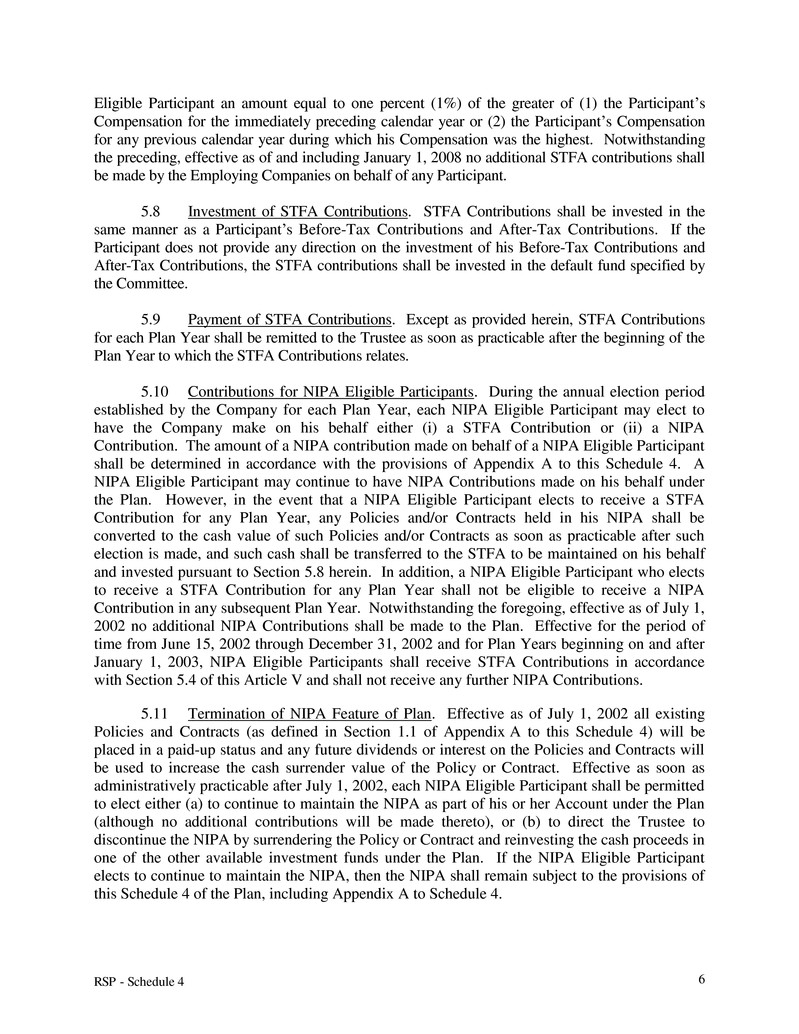
RSP - Schedule 4 6 Eligible Participant an amount equal to one percent (1%) of the greater of (1) the Participant’s Compensation for the immediately preceding calendar year or (2) the Participant’s Compensation for any previous calendar year during which his Compensation was the highest. Notwithstanding the preceding, effective as of and including January 1, 2008 no additional STFA contributions shall be made by the Employing Companies on behalf of any Participant. 5.8 Investment of STFA Contributions. STFA Contributions shall be invested in the same manner as a Participant’s Before-Tax Contributions and After-Tax Contributions. If the Participant does not provide any direction on the investment of his Before-Tax Contributions and After-Tax Contributions, the STFA contributions shall be invested in the default fund specified by the Committee. 5.9 Payment of STFA Contributions. Except as provided herein, STFA Contributions for each Plan Year shall be remitted to the Trustee as soon as practicable after the beginning of the Plan Year to which the STFA Contributions relates. 5.10 Contributions for NIPA Eligible Participants. During the annual election period established by the Company for each Plan Year, each NIPA Eligible Participant may elect to have the Company make on his behalf either (i) a STFA Contribution or (ii) a NIPA Contribution. The amount of a NIPA contribution made on behalf of a NIPA Eligible Participant shall be determined in accordance with the provisions of Appendix A to this Schedule 4. A NIPA Eligible Participant may continue to have NIPA Contributions made on his behalf under the Plan. However, in the event that a NIPA Eligible Participant elects to receive a STFA Contribution for any Plan Year, any Policies and/or Contracts held in his NIPA shall be converted to the cash value of such Policies and/or Contracts as soon as practicable after such election is made, and such cash shall be transferred to the STFA to be maintained on his behalf and invested pursuant to Section 5.8 herein. In addition, a NIPA Eligible Participant who elects to receive a STFA Contribution for any Plan Year shall not be eligible to receive a NIPA Contribution in any subsequent Plan Year. Notwithstanding the foregoing, effective as of July 1, 2002 no additional NIPA Contributions shall be made to the Plan. Effective for the period of time from June 15, 2002 through December 31, 2002 and for Plan Years beginning on and after January 1, 2003, NIPA Eligible Participants shall receive STFA Contributions in accordance with Section 5.4 of this Article V and shall not receive any further NIPA Contributions. 5.11 Termination of NIPA Feature of Plan. Effective as of July 1, 2002 all existing Policies and Contracts (as defined in Section 1.1 of Appendix A to this Schedule 4) will be placed in a paid-up status and any future dividends or interest on the Policies and Contracts will be used to increase the cash surrender value of the Policy or Contract. Effective as soon as administratively practicable after July 1, 2002, each NIPA Eligible Participant shall be permitted to elect either (a) to continue to maintain the NIPA as part of his or her Account under the Plan (although no additional contributions will be made thereto), or (b) to direct the Trustee to discontinue the NIPA by surrendering the Policy or Contract and reinvesting the cash proceeds in one of the other available investment funds under the Plan. If the NIPA Eligible Participant elects to continue to maintain the NIPA, then the NIPA shall remain subject to the provisions of this Schedule 4 of the Plan, including Appendix A to Schedule 4.
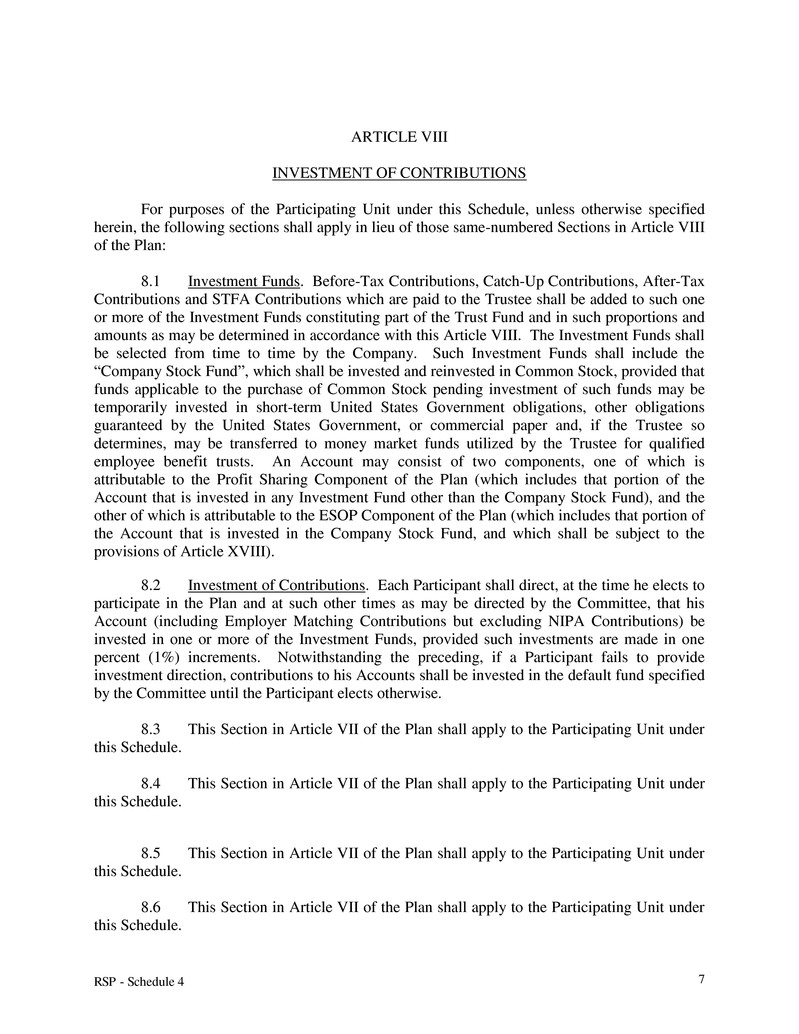
RSP - Schedule 4 7 ARTICLE VIII INVESTMENT OF CONTRIBUTIONS For purposes of the Participating Unit under this Schedule, unless otherwise specified herein, the following sections shall apply in lieu of those same-numbered Sections in Article VIII of the Plan: 8.1 Investment Funds. Before-Tax Contributions, Catch-Up Contributions, After-Tax Contributions and STFA Contributions which are paid to the Trustee shall be added to such one or more of the Investment Funds constituting part of the Trust Fund and in such proportions and amounts as may be determined in accordance with this Article VIII. The Investment Funds shall be selected from time to time by the Company. Such Investment Funds shall include the “Company Stock Fund”, which shall be invested and reinvested in Common Stock, provided that funds applicable to the purchase of Common Stock pending investment of such funds may be temporarily invested in short-term United States Government obligations, other obligations guaranteed by the United States Government, or commercial paper and, if the Trustee so determines, may be transferred to money market funds utilized by the Trustee for qualified employee benefit trusts. An Account may consist of two components, one of which is attributable to the Profit Sharing Component of the Plan (which includes that portion of the Account that is invested in any Investment Fund other than the Company Stock Fund), and the other of which is attributable to the ESOP Component of the Plan (which includes that portion of the Account that is invested in the Company Stock Fund, and which shall be subject to the provisions of Article XVIII). 8.2 Investment of Contributions. Each Participant shall direct, at the time he elects to participate in the Plan and at such other times as may be directed by the Committee, that his Account (including Employer Matching Contributions but excluding NIPA Contributions) be invested in one or more of the Investment Funds, provided such investments are made in one percent (1%) increments. Notwithstanding the preceding, if a Participant fails to provide investment direction, contributions to his Accounts shall be invested in the default fund specified by the Committee until the Participant elects otherwise. 8.3 This Section in Article VII of the Plan shall apply to the Participating Unit under this Schedule. 8.4 This Section in Article VII of the Plan shall apply to the Participating Unit under this Schedule. 8.5 This Section in Article VII of the Plan shall apply to the Participating Unit under this Schedule. 8.6 This Section in Article VII of the Plan shall apply to the Participating Unit under this Schedule.

RSP - Schedule 4 8 8.7 NIPA Contributions. A NIPA Contribution made on behalf of a NIPA Eligible Participant shall be invested in accordance with the provisions of Appendix A to this Schedule 4.
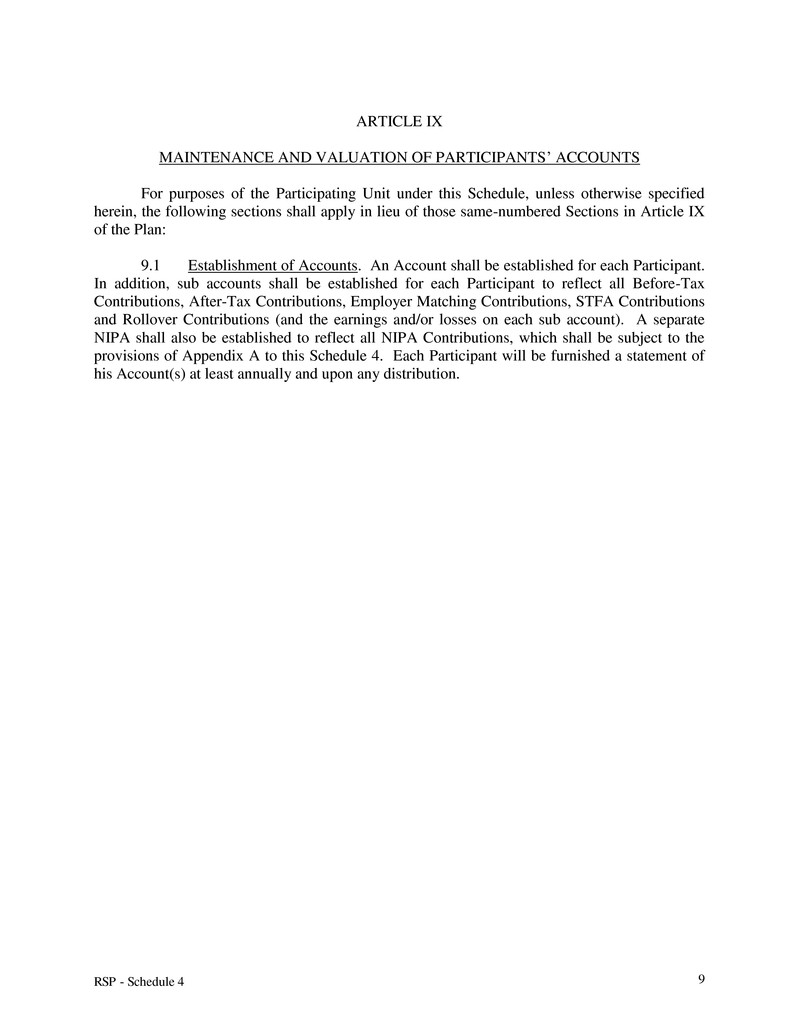
RSP - Schedule 4 9 ARTICLE IX MAINTENANCE AND VALUATION OF PARTICIPANTS’ ACCOUNTS For purposes of the Participating Unit under this Schedule, unless otherwise specified herein, the following sections shall apply in lieu of those same-numbered Sections in Article IX of the Plan: 9.1 Establishment of Accounts. An Account shall be established for each Participant. In addition, sub accounts shall be established for each Participant to reflect all Before-Tax Contributions, After-Tax Contributions, Employer Matching Contributions, STFA Contributions and Rollover Contributions (and the earnings and/or losses on each sub account). A separate NIPA shall also be established to reflect all NIPA Contributions, which shall be subject to the provisions of Appendix A to this Schedule 4. Each Participant will be furnished a statement of his Account(s) at least annually and upon any distribution.

RSP - Schedule 4 10 ARTICLE X VESTING For purposes of the Participating Unit under this Schedule, unless otherwise specified herein, the following sections shall apply in lieu of those same-numbered Sections in Article X of the Plan: 10.1 Vesting. A Participant shall always be fully vested in the Before-Tax Contributions, After-Tax Contributions, STFA Contributions, NIPA Contributions, Rollover Contributions and ESOP Dividends credited to his Account. The Employer Matching Contributions credited to a Participant’s Account shall be fully vested and nonforfeitable upon the earliest of the following to occur: (a) the Participant is credited with three (3) Years of Service; (b) the Participant attains age 55 while an Employee; (c) the Participant terminates employment as a result of a Group Termination; or (d) the Participant terminates employment with the Affiliated Employers as a result of Total and Permanent Disability or death. Notwithstanding the preceding, effective January 1, 2015 a Participant shall be fully vested in the Safe Harbor Employer Matching Contributions credited to his Account on or after January 1, 2015. Employer Matching Contributions credited to a Participant’s Account before January 1, 2015 shall be fully vested and nonforfeitable effective December 31, 2014 if such Participant is an Employee of an Affiliated Employer on December 31, 2014.
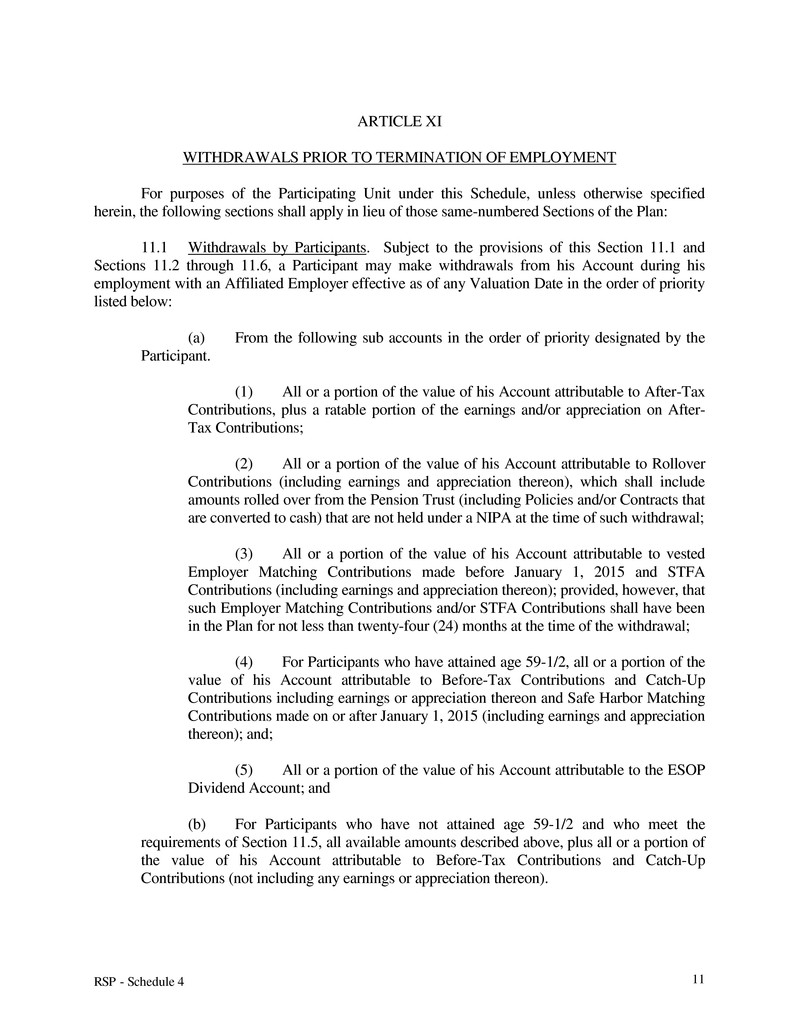
RSP - Schedule 4 11 ARTICLE XI WITHDRAWALS PRIOR TO TERMINATION OF EMPLOYMENT For purposes of the Participating Unit under this Schedule, unless otherwise specified herein, the following sections shall apply in lieu of those same-numbered Sections of the Plan: 11.1 Withdrawals by Participants. Subject to the provisions of this Section 11.1 and Sections 11.2 through 11.6, a Participant may make withdrawals from his Account during his employment with an Affiliated Employer effective as of any Valuation Date in the order of priority listed below: (a) From the following sub accounts in the order of priority designated by the Participant. (1) All or a portion of the value of his Account attributable to After-Tax Contributions, plus a ratable portion of the earnings and/or appreciation on After- Tax Contributions; (2) All or a portion of the value of his Account attributable to Rollover Contributions (including earnings and appreciation thereon), which shall include amounts rolled over from the Pension Trust (including Policies and/or Contracts that are converted to cash) that are not held under a NIPA at the time of such withdrawal; (3) All or a portion of the value of his Account attributable to vested Employer Matching Contributions made before January 1, 2015 and STFA Contributions (including earnings and appreciation thereon); provided, however, that such Employer Matching Contributions and/or STFA Contributions shall have been in the Plan for not less than twenty-four (24) months at the time of the withdrawal; (4) For Participants who have attained age 59-1/2, all or a portion of the value of his Account attributable to Before-Tax Contributions and Catch-Up Contributions including earnings or appreciation thereon and Safe Harbor Matching Contributions made on or after January 1, 2015 (including earnings and appreciation thereon); and; (5) All or a portion of the value of his Account attributable to the ESOP Dividend Account; and (b) For Participants who have not attained age 59-1/2 and who meet the requirements of Section 11.5, all available amounts described above, plus all or a portion of the value of his Account attributable to Before-Tax Contributions and Catch-Up Contributions (not including any earnings or appreciation thereon).
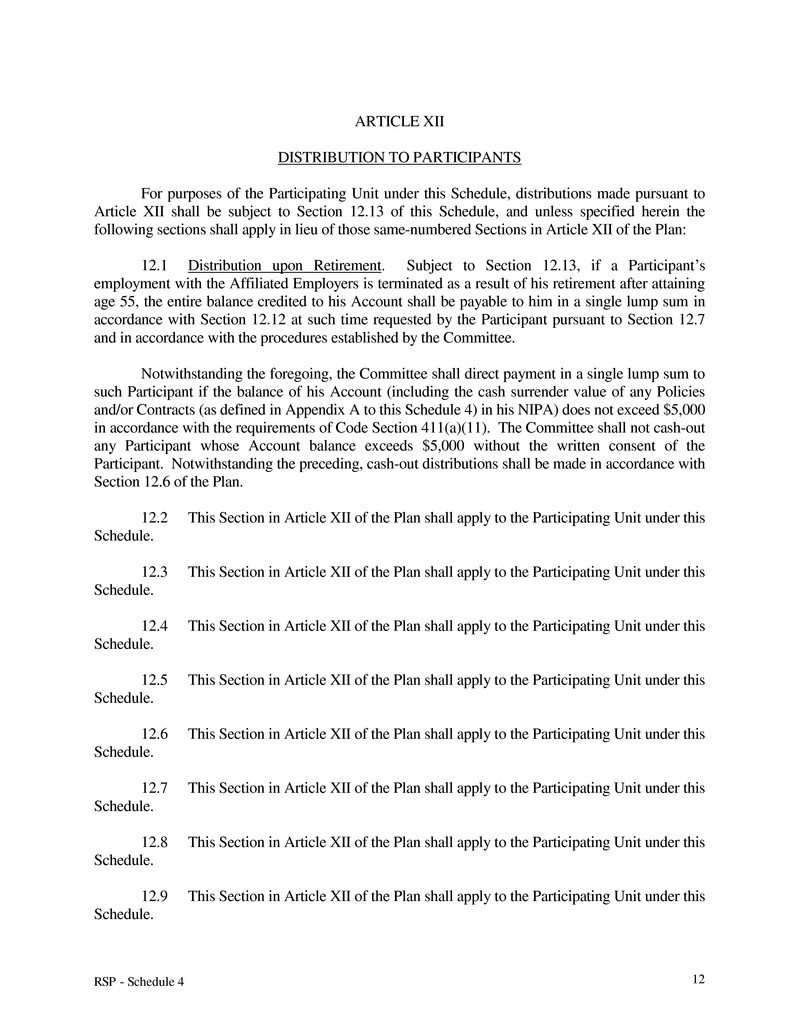
RSP - Schedule 4 12 ARTICLE XII DISTRIBUTION TO PARTICIPANTS For purposes of the Participating Unit under this Schedule, distributions made pursuant to Article XII shall be subject to Section 12.13 of this Schedule, and unless specified herein the following sections shall apply in lieu of those same-numbered Sections in Article XII of the Plan: 12.1 Distribution upon Retirement. Subject to Section 12.13, if a Participant’s employment with the Affiliated Employers is terminated as a result of his retirement after attaining age 55, the entire balance credited to his Account shall be payable to him in a single lump sum in accordance with Section 12.12 at such time requested by the Participant pursuant to Section 12.7 and in accordance with the procedures established by the Committee. Notwithstanding the foregoing, the Committee shall direct payment in a single lump sum to such Participant if the balance of his Account (including the cash surrender value of any Policies and/or Contracts (as defined in Appendix A to this Schedule 4) in his NIPA) does not exceed $5,000 in accordance with the requirements of Code Section 411(a)(11). The Committee shall not cash-out any Participant whose Account balance exceeds $5,000 without the written consent of the Participant. Notwithstanding the preceding, cash-out distributions shall be made in accordance with Section 12.6 of the Plan. 12.2 This Section in Article XII of the Plan shall apply to the Participating Unit under this Schedule. 12.3 This Section in Article XII of the Plan shall apply to the Participating Unit under this Schedule. 12.4 This Section in Article XII of the Plan shall apply to the Participating Unit under this Schedule. 12.5 This Section in Article XII of the Plan shall apply to the Participating Unit under this Schedule. 12.6 This Section in Article XII of the Plan shall apply to the Participating Unit under this Schedule. 12.7 This Section in Article XII of the Plan shall apply to the Participating Unit under this Schedule. 12.8 This Section in Article XII of the Plan shall apply to the Participating Unit under this Schedule. 12.9 This Section in Article XII of the Plan shall apply to the Participating Unit under this Schedule.
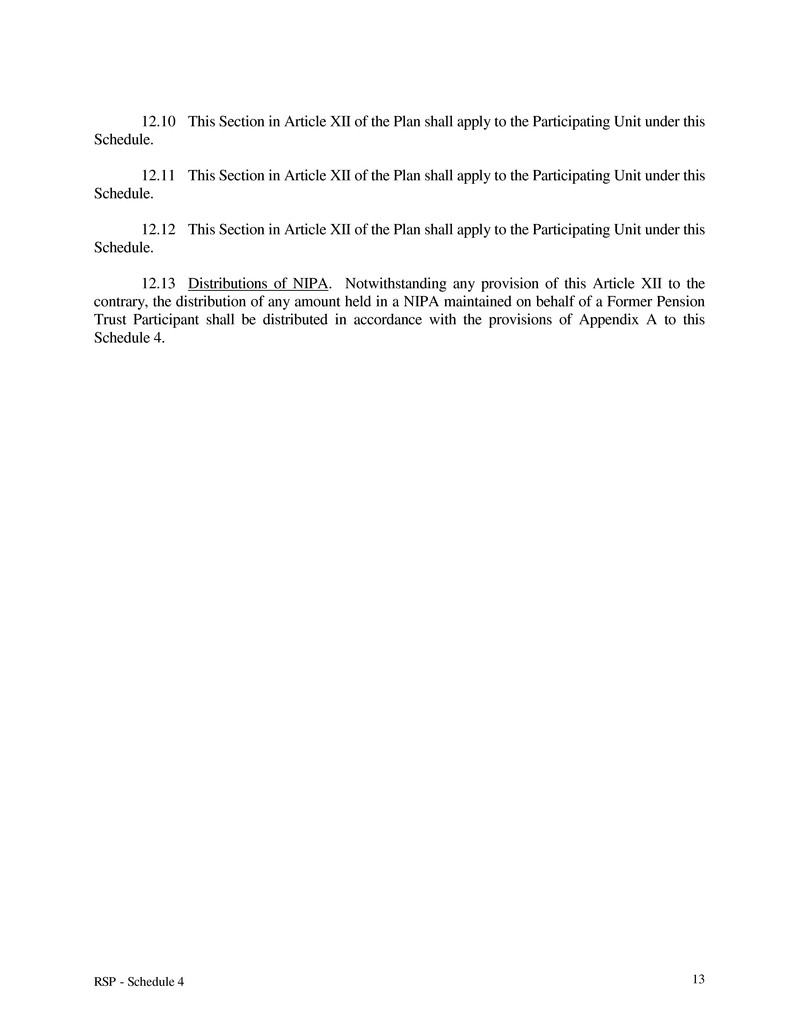
RSP - Schedule 4 13 12.10 This Section in Article XII of the Plan shall apply to the Participating Unit under this Schedule. 12.11 This Section in Article XII of the Plan shall apply to the Participating Unit under this Schedule. 12.12 This Section in Article XII of the Plan shall apply to the Participating Unit under this Schedule. 12.13 Distributions of NIPA. Notwithstanding any provision of this Article XII to the contrary, the distribution of any amount held in a NIPA maintained on behalf of a Former Pension Trust Participant shall be distributed in accordance with the provisions of Appendix A to this Schedule 4.

RSP - Schedule 4 14 APPENDIX A TO SCHEDULE 4 SCHWEITZER-MAUDUIT INTERNATIONAL, INC. RETIREMENT SAVINGS PLAN DEFINITIONS 1.1 Where the following words and phrases appear in this Appendix A, they shall have the respective meanings set forth in the following sections of this Article, unless the context clearly indicates to the contrary. (a) “Insurer” shall mean any legal reserve life insurance company licensed to do business in the state where a Policy or Contract under this Plan is issued. (b) “Accrued Benefit” shall mean the cash surrender values of any Policies or Contracts on the life of the Participant. (c) “NIPA Normal Retirement Date” shall mean the Participant’s 65th birthday. (d) “Anniversary Date” shall mean December 23rd in each year after 1976. (e) “Policy” or “Contract” shall mean a Special Retirement Endowment or similar policy and/or Retirement Annuity or similar contract, on a Participant’s life, and shall provide for the payment of a single life income payable for the lifetime of the Participant with a guarantee of 120 monthly payments. (f) “Insured” shall mean a person on whose life a Policy or Contract has been issued under this Appendix A. (g) “Actuarial (or Actuarially) Equivalent” shall mean equality in value of the aggregate amounts expected to be received under different forms of payment as determined by the Insurer with respect to its policies and annuities, or based on actuarial assumptions approved from time to time by the Company.
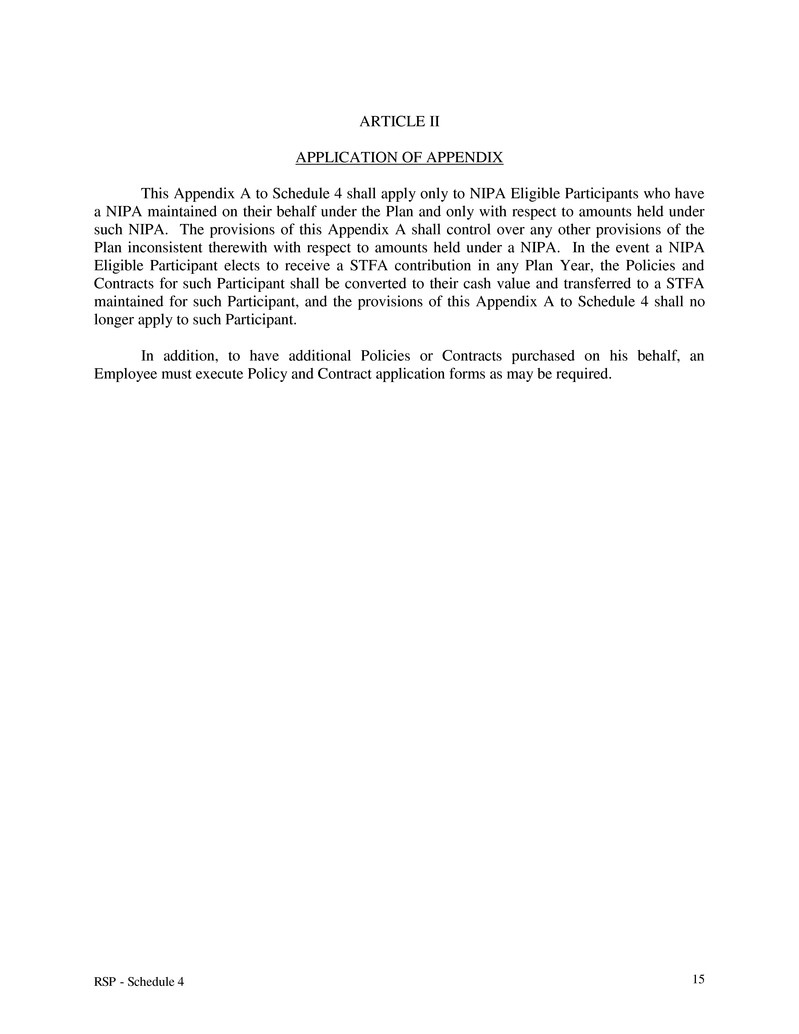
RSP - Schedule 4 15 ARTICLE II APPLICATION OF APPENDIX This Appendix A to Schedule 4 shall apply only to NIPA Eligible Participants who have a NIPA maintained on their behalf under the Plan and only with respect to amounts held under such NIPA. The provisions of this Appendix A shall control over any other provisions of the Plan inconsistent therewith with respect to amounts held under a NIPA. In the event a NIPA Eligible Participant elects to receive a STFA contribution in any Plan Year, the Policies and Contracts for such Participant shall be converted to their cash value and transferred to a STFA maintained for such Participant, and the provisions of this Appendix A to Schedule 4 shall no longer apply to such Participant. In addition, to have additional Policies or Contracts purchased on his behalf, an Employee must execute Policy and Contract application forms as may be required.
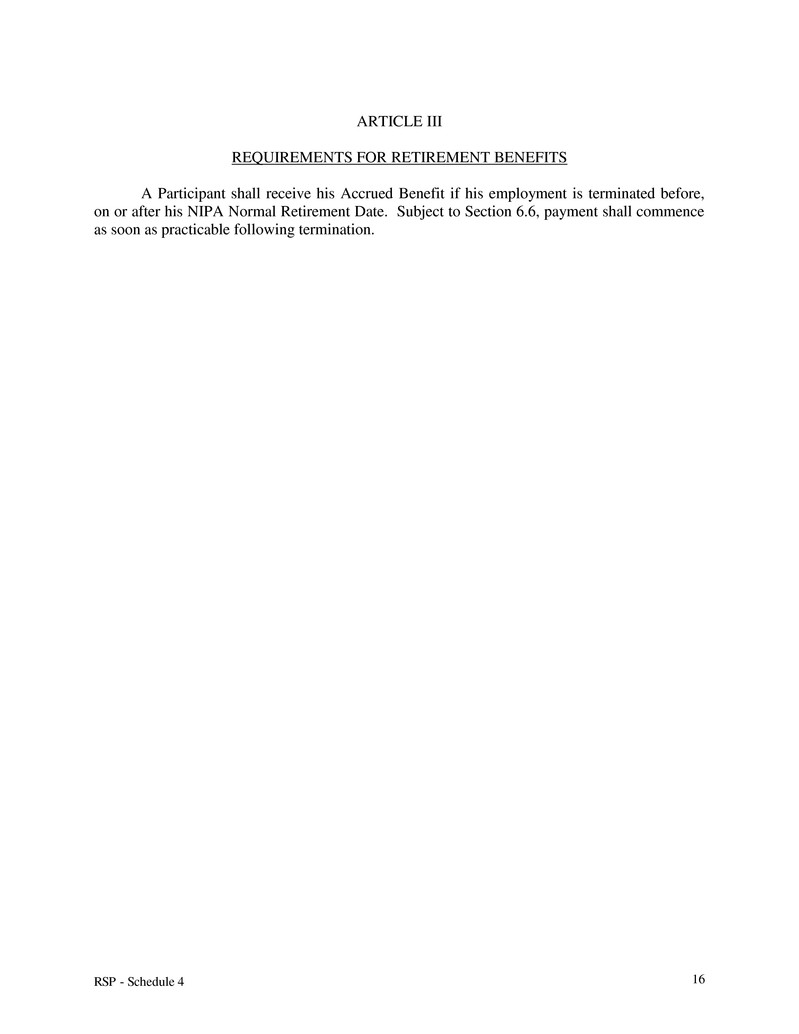
RSP - Schedule 4 16 ARTICLE III REQUIREMENTS FOR RETIREMENT BENEFITS A Participant shall receive his Accrued Benefit if his employment is terminated before, on or after his NIPA Normal Retirement Date. Subject to Section 6.6, payment shall commence as soon as practicable following termination.

RSP - Schedule 4 17 ARTICLE IV CONTRIBUTIONS 4.1 Amount and Time of Company’s Contribution. During the continuance of the Appendix A, for any NIPA Eligible Participant who elects to receive a NIPA Contribution, the annual contribution with respect to such Participant shall be equal to the net premium payable during that year under all Policies and Contracts on the life of such Participant required hereunder. In determining a Participant’s “Estimated Annual Compensation” the amount of a Participant’s “bonus” shall be excluded. For Participants age 65 and over, where no premium is due because the Participant’s Policies or Contracts have “matured,” the annual contribution shall be five percent (5%) of such Participant’s “Estimated Annual Compensation.” For any year, a Participant’s Estimated Annual Compensation shall equal the product of the number of payroll dates in such year and such Participant’s actual compensation for such year as of the Computation Date divided by the number of payroll dates in such year as of the Computation Date. For purposes of this Section 4.1, the term Computation Date shall mean a date, within five weeks of the end of the year, on which the Estimated Annual Compensation of a Participant is determined. A Participant’s actual compensation may be used to determine the annual contribution with respect to such Participant, provided, however that such record of actual compensation is submitted by the Participant no later than the date the application is executed by the Participant. Notwithstanding any other provision herein, effective as of July 1, 2002 no additional NIPA Contributions shall be made to the Plan. 4.2 Minimum Contributions. Notwithstanding anything hereinabove to the contrary, the Company shall contribute for each Participant an amount sufficient to pay the premium or premiums on Policies and/or Contracts which shall provide a guaranteed monthly life income of $10 upon attaining Normal Retirement Age, or, if later, the maturity date of the Policy or Contract. 4.3 Compensation Limit. (a) Compensation Limit. In addition to other applicable limitations which may be set forth in this Appendix A and notwithstanding any other contrary provision of the Appendix A, Estimated Annual Compensation taken into account under this Appendix A for Plan Years beginning on or after January 1, 1994, shall not exceed $150,000, and for Plan Years beginning after December 31, 2001, exceed $200,000, adjusted for changes in the cost of living as provided in Code Sections 401(a) (17)(B) and 415(d).
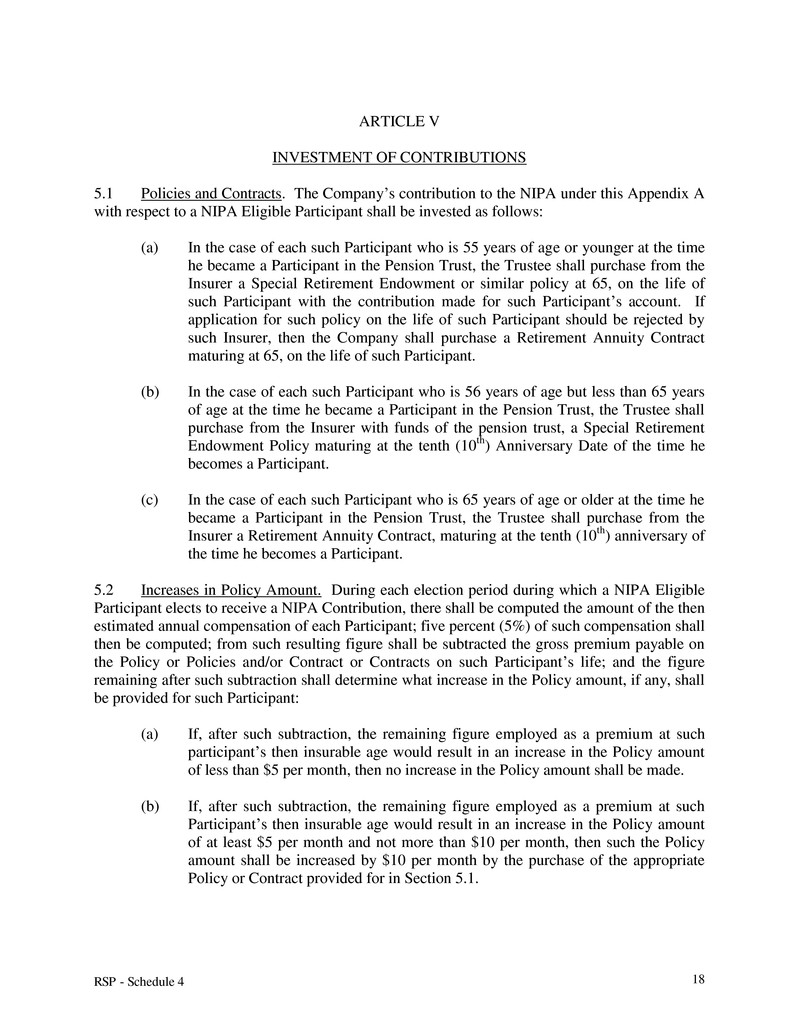
RSP - Schedule 4 18 ARTICLE V INVESTMENT OF CONTRIBUTIONS 5.1 Policies and Contracts. The Company’s contribution to the NIPA under this Appendix A with respect to a NIPA Eligible Participant shall be invested as follows: (a) In the case of each such Participant who is 55 years of age or younger at the time he became a Participant in the Pension Trust, the Trustee shall purchase from the Insurer a Special Retirement Endowment or similar policy at 65, on the life of such Participant with the contribution made for such Participant’s account. If application for such policy on the life of such Participant should be rejected by such Insurer, then the Company shall purchase a Retirement Annuity Contract maturing at 65, on the life of such Participant. (b) In the case of each such Participant who is 56 years of age but less than 65 years of age at the time he became a Participant in the Pension Trust, the Trustee shall purchase from the Insurer with funds of the pension trust, a Special Retirement Endowment Policy maturing at the tenth (10th) Anniversary Date of the time he becomes a Participant. (c) In the case of each such Participant who is 65 years of age or older at the time he became a Participant in the Pension Trust, the Trustee shall purchase from the Insurer a Retirement Annuity Contract, maturing at the tenth (10th) anniversary of the time he becomes a Participant. 5.2 Increases in Policy Amount. During each election period during which a NIPA Eligible Participant elects to receive a NIPA Contribution, there shall be computed the amount of the then estimated annual compensation of each Participant; five percent (5%) of such compensation shall then be computed; from such resulting figure shall be subtracted the gross premium payable on the Policy or Policies and/or Contract or Contracts on such Participant’s life; and the figure remaining after such subtraction shall determine what increase in the Policy amount, if any, shall be provided for such Participant: (a) If, after such subtraction, the remaining figure employed as a premium at such participant’s then insurable age would result in an increase in the Policy amount of less than $5 per month, then no increase in the Policy amount shall be made. (b) If, after such subtraction, the remaining figure employed as a premium at such Participant’s then insurable age would result in an increase in the Policy amount of at least $5 per month and not more than $10 per month, then such the Policy amount shall be increased by $10 per month by the purchase of the appropriate Policy or Contract provided for in Section 5.1.
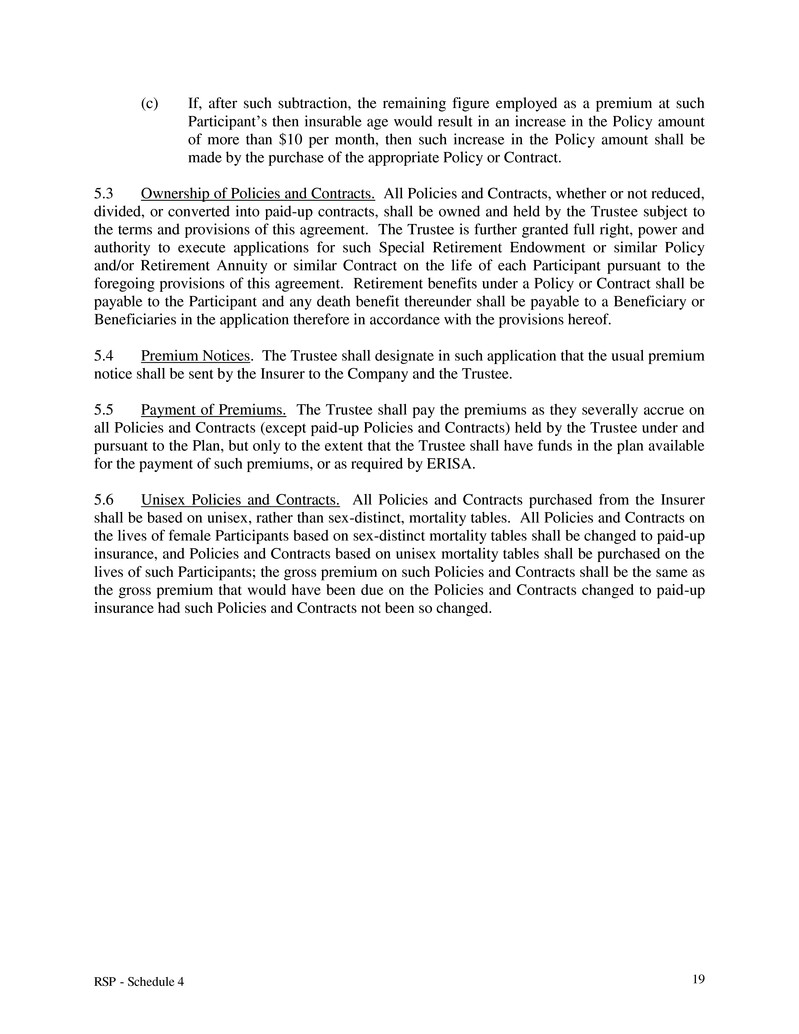
RSP - Schedule 4 19 (c) If, after such subtraction, the remaining figure employed as a premium at such Participant’s then insurable age would result in an increase in the Policy amount of more than $10 per month, then such increase in the Policy amount shall be made by the purchase of the appropriate Policy or Contract. 5.3 Ownership of Policies and Contracts. All Policies and Contracts, whether or not reduced, divided, or converted into paid-up contracts, shall be owned and held by the Trustee subject to the terms and provisions of this agreement. The Trustee is further granted full right, power and authority to execute applications for such Special Retirement Endowment or similar Policy and/or Retirement Annuity or similar Contract on the life of each Participant pursuant to the foregoing provisions of this agreement. Retirement benefits under a Policy or Contract shall be payable to the Participant and any death benefit thereunder shall be payable to a Beneficiary or Beneficiaries in the application therefore in accordance with the provisions hereof. 5.4 Premium Notices. The Trustee shall designate in such application that the usual premium notice shall be sent by the Insurer to the Company and the Trustee. 5.5 Payment of Premiums. The Trustee shall pay the premiums as they severally accrue on all Policies and Contracts (except paid-up Policies and Contracts) held by the Trustee under and pursuant to the Plan, but only to the extent that the Trustee shall have funds in the plan available for the payment of such premiums, or as required by ERISA. 5.6 Unisex Policies and Contracts. All Policies and Contracts purchased from the Insurer shall be based on unisex, rather than sex-distinct, mortality tables. All Policies and Contracts on the lives of female Participants based on sex-distinct mortality tables shall be changed to paid-up insurance, and Policies and Contracts based on unisex mortality tables shall be purchased on the lives of such Participants; the gross premium on such Policies and Contracts shall be the same as the gross premium that would have been due on the Policies and Contracts changed to paid-up insurance had such Policies and Contracts not been so changed.
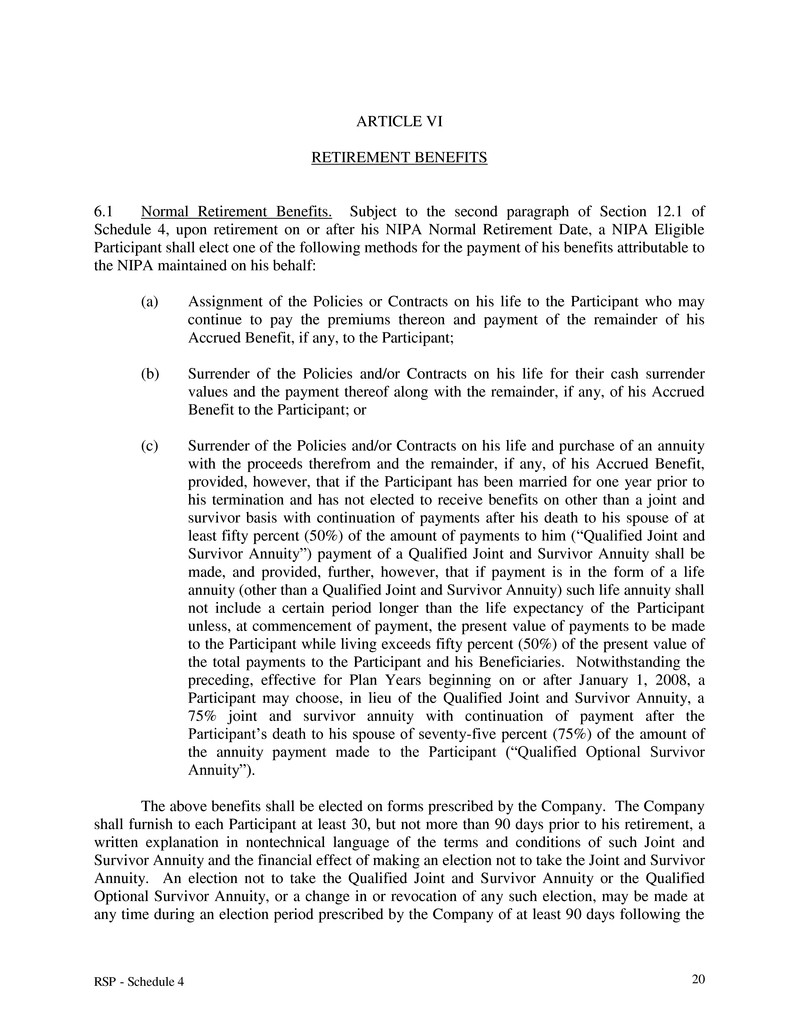
RSP - Schedule 4 20 ARTICLE VI RETIREMENT BENEFITS 6.1 Normal Retirement Benefits. Subject to the second paragraph of Section 12.1 of Schedule 4, upon retirement on or after his NIPA Normal Retirement Date, a NIPA Eligible Participant shall elect one of the following methods for the payment of his benefits attributable to the NIPA maintained on his behalf: (a) Assignment of the Policies or Contracts on his life to the Participant who may continue to pay the premiums thereon and payment of the remainder of his Accrued Benefit, if any, to the Participant; (b) Surrender of the Policies and/or Contracts on his life for their cash surrender values and the payment thereof along with the remainder, if any, of his Accrued Benefit to the Participant; or (c) Surrender of the Policies and/or Contracts on his life and purchase of an annuity with the proceeds therefrom and the remainder, if any, of his Accrued Benefit, provided, however, that if the Participant has been married for one year prior to his termination and has not elected to receive benefits on other than a joint and survivor basis with continuation of payments after his death to his spouse of at least fifty percent (50%) of the amount of payments to him (“Qualified Joint and Survivor Annuity”) payment of a Qualified Joint and Survivor Annuity shall be made, and provided, further, however, that if payment is in the form of a life annuity (other than a Qualified Joint and Survivor Annuity) such life annuity shall not include a certain period longer than the life expectancy of the Participant unless, at commencement of payment, the present value of payments to be made to the Participant while living exceeds fifty percent (50%) of the present value of the total payments to the Participant and his Beneficiaries. Notwithstanding the preceding, effective for Plan Years beginning on or after January 1, 2008, a Participant may choose, in lieu of the Qualified Joint and Survivor Annuity, a 75% joint and survivor annuity with continuation of payment after the Participant’s death to his spouse of seventy-five percent (75%) of the amount of the annuity payment made to the Participant (“Qualified Optional Survivor Annuity”). The above benefits shall be elected on forms prescribed by the Company. The Company shall furnish to each Participant at least 30, but not more than 90 days prior to his retirement, a written explanation in nontechnical language of the terms and conditions of such Joint and Survivor Annuity and the financial effect of making an election not to take the Joint and Survivor Annuity. An election not to take the Qualified Joint and Survivor Annuity or the Qualified Optional Survivor Annuity, or a change in or revocation of any such election, may be made at any time during an election period prescribed by the Company of at least 90 days following the

RSP - Schedule 4 21 date the information referred to in the preceding sentence is furnished to such Participant and ending when payment of the Participant’s benefit commences. The foregoing provisions of this Section 6.1 notwithstanding, in the case of any married Participant who elects the method of payment described in subsection 6.1(c), no election to receive benefits as an annuity on other than a Qualified Joint and Survivor Annuity basis or a Qualified Optional Survivor Annuity shall be valid unless (i) such Participant’s spouse consents in writing to the election of an annuity on such other basis and acknowledges the effect of such election, and (ii) such consent is witnessed by a notary public. No such spousal consent need be furnished with respect to an election, however, if the Trustees are satisfied that such Participant’s spouse cannot be located, or that such consent is unobtainable for any other reason provided under the regulations of the Internal Revenue Service. The foregoing provisions of this Section 6.1 notwithstanding, no Participant may delay the receipt of his Accrued Benefit hereunder to the extent that such delay would result in death benefits which are more than incidental, within the meaning of the Internal Revenue Service Regulation 1.401-1(b)(1)(i). In the event the cash surrender value of the Policies and/or Contracts on the life of a NIPA Eligible Participant exceeds $5,000 and such NIPA Eligible Participant fails to make an election under this Article VI, any Policies and/or Contracts held in his NIPA shall be converted to the cash value of such Policies and/or Contracts, and such cash shall be transferred to the STFA to be maintained on his behalf and invested pursuant to Section 5.5. 6.2 Continuation of Contributions during Employment after Age 65 (a) On each Anniversary Date on which a NIPA Eligible Participant shall continue to be actively employed and elects to receive a NIPA Contribution after age 65, the Company shall contribute to his NIPA a sum equal to the net premium last paid on the Policy or Contract on his life prior to his attaining age 65. (b) Funds so received by the Trustee shall be applied to the maximum extent possible to the Contracts and/or Policies on the life of the NIPA Eligible Participant which have not yet matured. Contracts and/or Policies which have matured shall be placed under an optional maturity date so as to permit such policies to remain in force. 6.3 Death Benefits. If any Policy or Contract on the life of a NIPA Eligible Participant shall mature by reason of his Death, its proceeds shall be paid to the Designated Beneficiary or Beneficiaries of such Policy or Contract pursuant to written directions from the Designated Beneficiary or Beneficiaries in a lump sum. 6.4 Designation of Beneficiary. The Beneficiary or Beneficiaries of a Participant for purposes of this Appendix A shall be his Beneficiary or Beneficiaries designated in accordance with Section 12.5 of Schedule 4.

RSP - Schedule 4 22 6.5 Termination of Employment other than by Retirement or Death. If any Policy or Contract on the life of a Participant shall mature by reason of a Participant’s termination of employment other than by Retirement or Death, the Participant’s Accrued Benefit, including the values of the Policies and/or Contracts on his life shall become one hundred percent (100%) nonforfeitable and shall thereupon be distributed under such option or combination of options requested by the Participant as shall be available under Section 6.1 hereinabove. 6.6 Time of Benefit Payment Commencement (a) Payment of benefits due under the provisions of this Article VI, unless a later date is elected in writing, shall commence no later than 60 days after the close of the Plan Year in which such benefits become payable. (b) Required Beginning Date: Any provision of this Appendix to the contrary notwithstanding, the payment of benefits under this Appendix shall commence no later than the date benefits are required to commence under the terms of the Plan. (c) Any distribution to a NIPA Eligible Participant shall require such Participant’s consent if such distribution commences prior to the later of his Normal Retirement Date or age 62. With regard to this required consent: (i) No consent shall be valid unless the Participant has received a general description of the material features and an explanation of the relative values of the optional forms of benefit available under the Plan that would satisfy the notice requirements of Section 417 of the Code. (ii) The Participant must be informed of his right to defer receipt of the distribution and for Plan Years beginning on or after January 1, 2007, the consequences of failing to delay or defer payment. If a Participant fails to consent, it shall be deemed an election to defer the commencement of payment of any benefit. However, any election to defer the receipt of benefits shall not apply with respect to distributions which are required under subdivision (b). (iii) Notice of the rights specified under this paragraph shall be provided no less than 30 days and no more than 90 days before the “annuity starting date”. (iv) Written consent of the Participant to the distribution must not be made before the Participant receives the notice and must not be made more than 90 days before the “annuity starting date”. (v) No consent shall be valid if a significant detriment is imposed under the Plan on any Participant who does not consent to the distribution. 6.7 Distribution Period. The foregoing provisions of this Article VI notwithstanding:
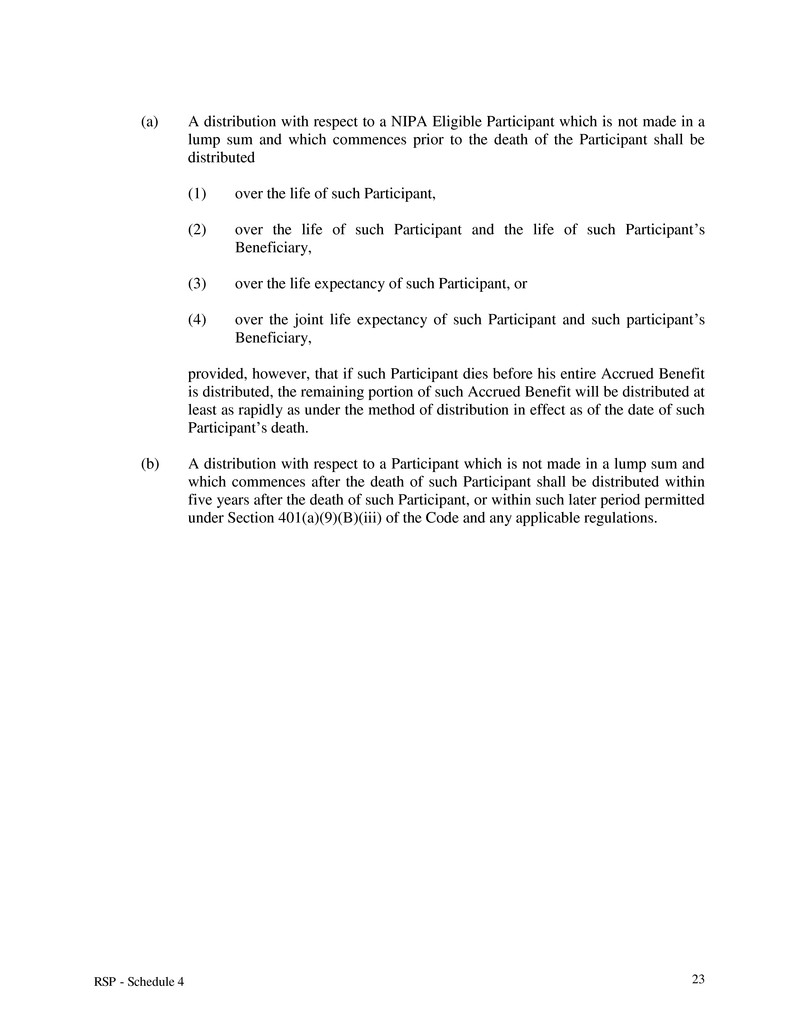
RSP - Schedule 4 23 (a) A distribution with respect to a NIPA Eligible Participant which is not made in a lump sum and which commences prior to the death of the Participant shall be distributed (1) over the life of such Participant, (2) over the life of such Participant and the life of such Participant’s Beneficiary, (3) over the life expectancy of such Participant, or (4) over the joint life expectancy of such Participant and such participant’s Beneficiary, provided, however, that if such Participant dies before his entire Accrued Benefit is distributed, the remaining portion of such Accrued Benefit will be distributed at least as rapidly as under the method of distribution in effect as of the date of such Participant’s death. (b) A distribution with respect to a Participant which is not made in a lump sum and which commences after the death of such Participant shall be distributed within five years after the death of such Participant, or within such later period permitted under Section 401(a)(9)(B)(iii) of the Code and any applicable regulations.

RSP - Schedule 4 24 ARTICLE VII THE INSURER 7.1 No Insurer shall be deemed a party to this agreement or to be in any way responsible for its validity. The obligations and responsibilities of the Insurer shall be measured and determined solely by the terms of its Contracts and Policies. 7.2 The Insurer shall not be required to look into the terms of the agreement or question any action of the Trustees, nor shall it be responsible to see that any action of the Trustees is authorized. 7.3 The Insurer may conclusively assume that each Trustee has full authority, and is acting within that authority, in any transaction concerning the Contracts and/or Policies, and shall be fully discharged from any and all liability for any action taken in accordance with the direction of the Trustees or any one of them. In accepting applications for Contracts and/or Policies, the Insurer has no responsibility for determining whether the Employee is eligible or qualified for participation under the Plan. In all transactions with the Trustees the Insurer shall deal with them as though they were the sole and absolute owners of the Policies and/or Contracts. 7.4 The Insurer shall be fully protected from any liability for any action taken prior to receiving notice of any amendment or termination of this agreement and Trust or for dealing with any prior Trustee or Trustees prior to receiving notice of the appointment of a successor Trustee or Trustees. 23922509v1













































































































